Quick filters:
18th century navy ship Stock Photos and Images
 Mustard for the Royal Navy being loaded aboard a ship setting out to broaden the scope of the British Empire during the reign of King George II in the mid 18th century. Stock Photohttps://www.alamy.com/image-license-details/?v=1https://www.alamy.com/mustard-for-the-royal-navy-being-loaded-aboard-a-ship-setting-out-to-broaden-the-scope-of-the-british-empire-during-the-reign-of-king-george-ii-in-the-mid-18th-century-image504802863.html
Mustard for the Royal Navy being loaded aboard a ship setting out to broaden the scope of the British Empire during the reign of King George II in the mid 18th century. Stock Photohttps://www.alamy.com/image-license-details/?v=1https://www.alamy.com/mustard-for-the-royal-navy-being-loaded-aboard-a-ship-setting-out-to-broaden-the-scope-of-the-british-empire-during-the-reign-of-king-george-ii-in-the-mid-18th-century-image504802863.htmlRM2M97N5K–Mustard for the Royal Navy being loaded aboard a ship setting out to broaden the scope of the British Empire during the reign of King George II in the mid 18th century.
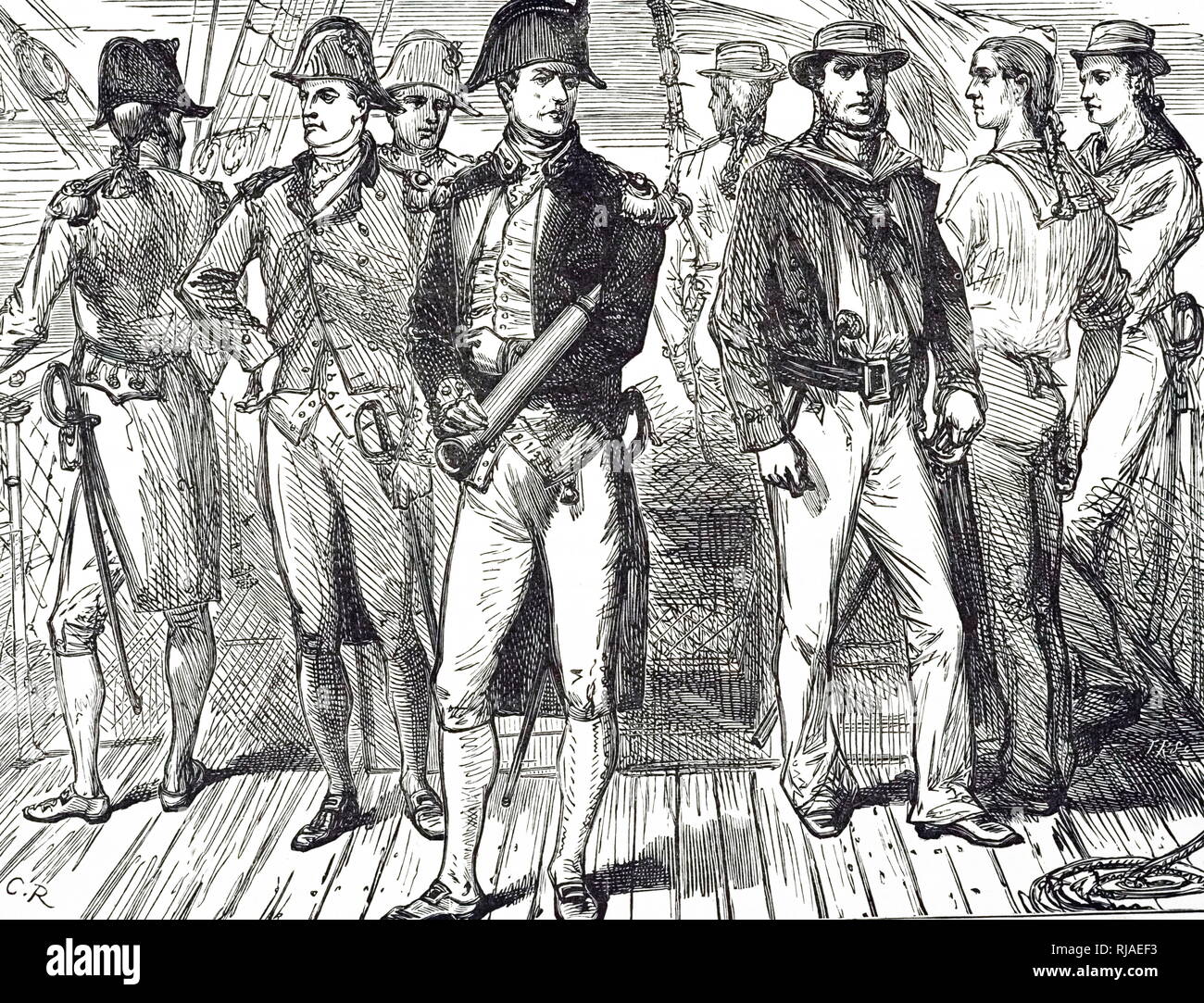 18th century Royal Navy captain and officers on board their ship. Illustration; 1890 Stock Photohttps://www.alamy.com/image-license-details/?v=1https://www.alamy.com/18th-century-royal-navy-captain-and-officers-on-board-their-ship-illustration-1890-image235029511.html
18th century Royal Navy captain and officers on board their ship. Illustration; 1890 Stock Photohttps://www.alamy.com/image-license-details/?v=1https://www.alamy.com/18th-century-royal-navy-captain-and-officers-on-board-their-ship-illustration-1890-image235029511.htmlRMRJAEF3–18th century Royal Navy captain and officers on board their ship. Illustration; 1890
 The Royal flag of France flying over a French Navy ship of the 18th century. Stock Photohttps://www.alamy.com/image-license-details/?v=1https://www.alamy.com/stock-photo-the-royal-flag-of-france-flying-over-a-french-navy-ship-of-the-18th-32080116.html
The Royal flag of France flying over a French Navy ship of the 18th century. Stock Photohttps://www.alamy.com/image-license-details/?v=1https://www.alamy.com/stock-photo-the-royal-flag-of-france-flying-over-a-french-navy-ship-of-the-18th-32080116.htmlRMBT5AEC–The Royal flag of France flying over a French Navy ship of the 18th century.
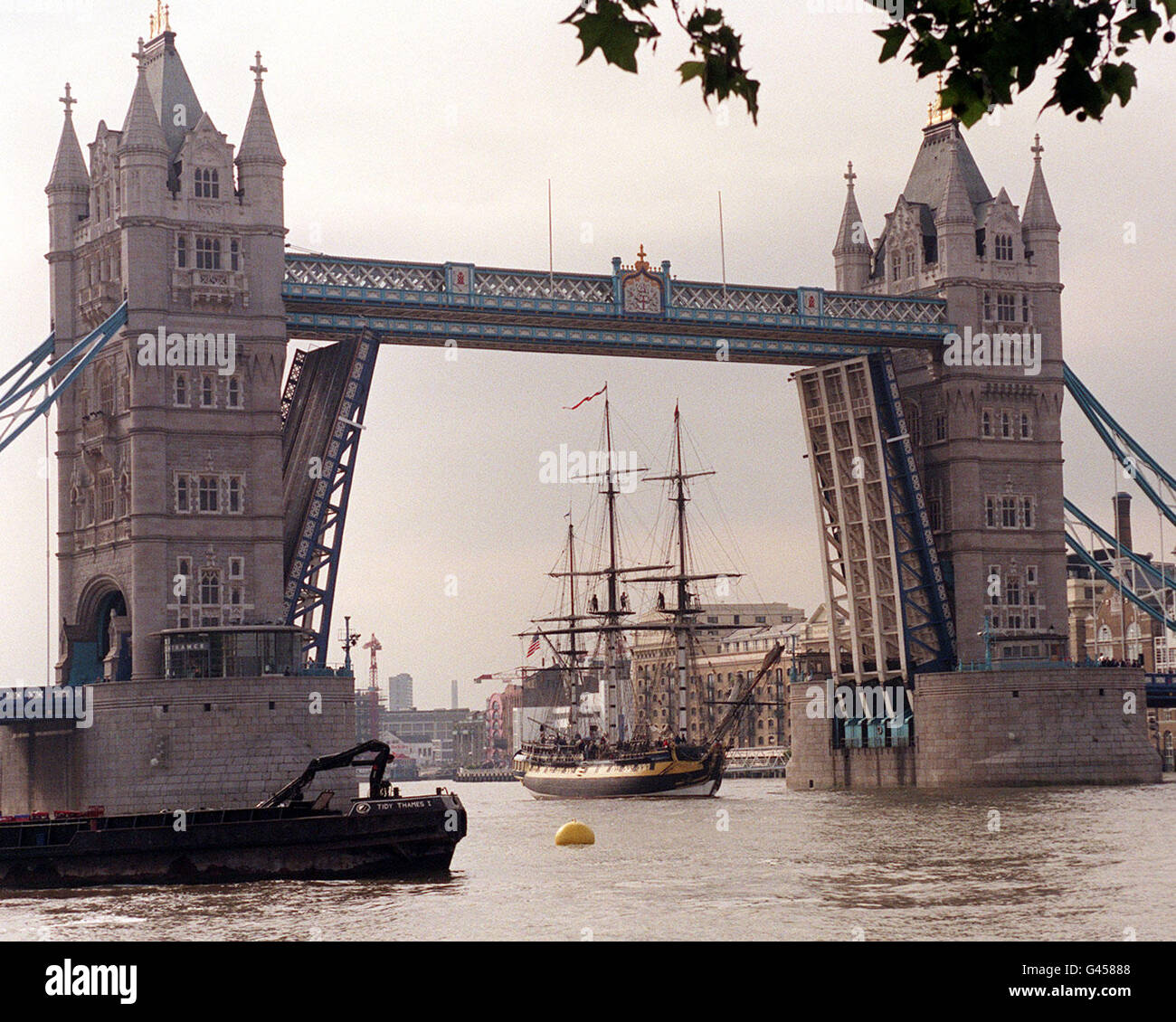 American tall ship 'HMS Rose' passes through Tower Bridge in London this morning (Mon) before returning back along the River Thames to sail to Brest in France. 'HMS Rose' is a replica of an 18th century Royal Navy frigate, built in Hull in 1757. The original Rose has her home brth in Bridgeport, Connecticut, USA where she is a tourist attraction and used as a sail training ship. The replica is due to make her maiden voyage across the Atlantic later this year. Photo by Sean Dempsey/PA. Stock Photohttps://www.alamy.com/image-license-details/?v=1https://www.alamy.com/stock-photo-american-tall-ship-hms-rose-passes-through-tower-bridge-in-london-105837096.html
American tall ship 'HMS Rose' passes through Tower Bridge in London this morning (Mon) before returning back along the River Thames to sail to Brest in France. 'HMS Rose' is a replica of an 18th century Royal Navy frigate, built in Hull in 1757. The original Rose has her home brth in Bridgeport, Connecticut, USA where she is a tourist attraction and used as a sail training ship. The replica is due to make her maiden voyage across the Atlantic later this year. Photo by Sean Dempsey/PA. Stock Photohttps://www.alamy.com/image-license-details/?v=1https://www.alamy.com/stock-photo-american-tall-ship-hms-rose-passes-through-tower-bridge-in-london-105837096.htmlRMG45888–American tall ship 'HMS Rose' passes through Tower Bridge in London this morning (Mon) before returning back along the River Thames to sail to Brest in France. 'HMS Rose' is a replica of an 18th century Royal Navy frigate, built in Hull in 1757. The original Rose has her home brth in Bridgeport, Connecticut, USA where she is a tourist attraction and used as a sail training ship. The replica is due to make her maiden voyage across the Atlantic later this year. Photo by Sean Dempsey/PA.
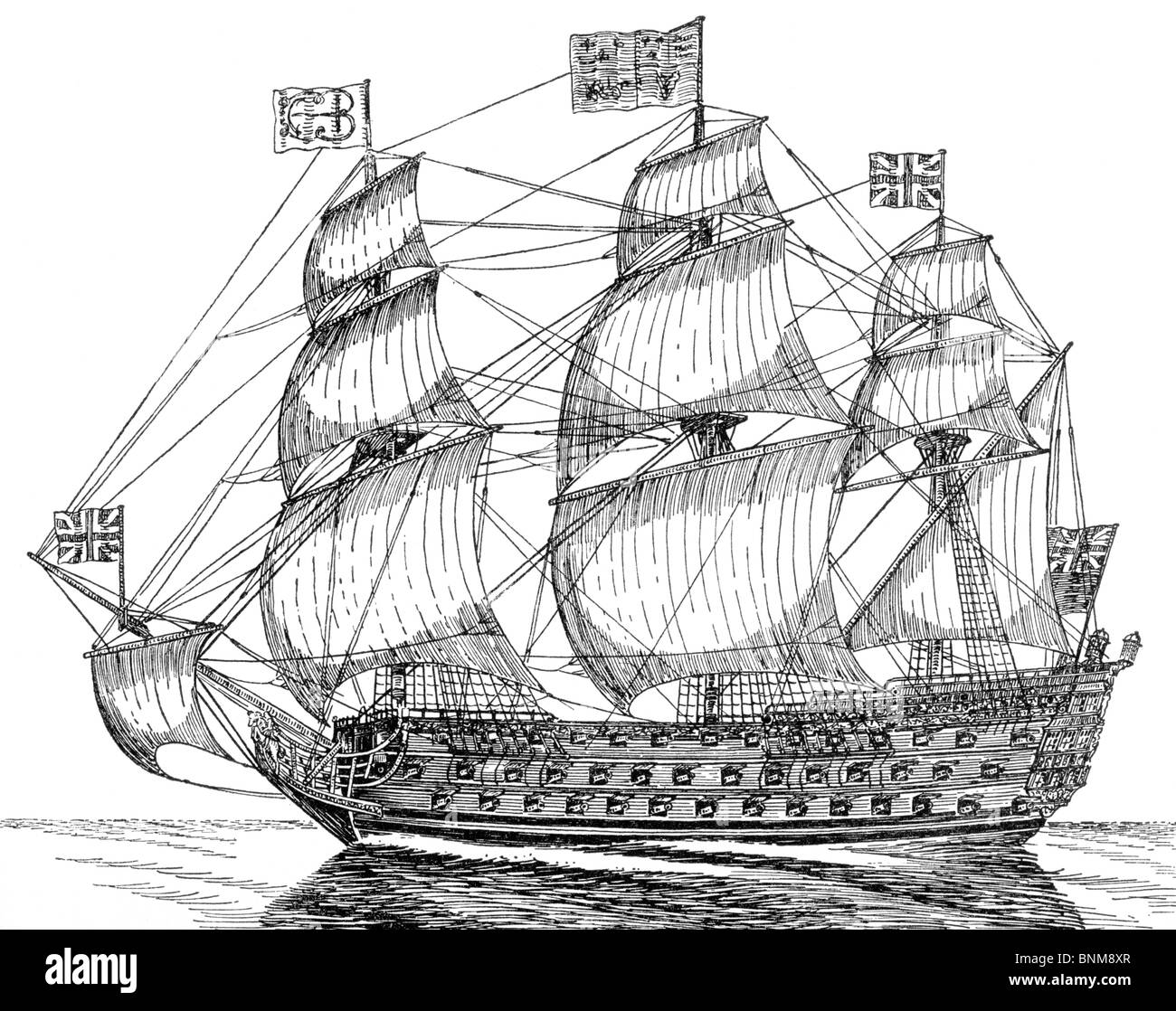 Black and White Illustration of HMS Royal George; 18th Century Naval Ship Stock Photohttps://www.alamy.com/image-license-details/?v=1https://www.alamy.com/stock-photo-black-and-white-illustration-of-hms-royal-george-18th-century-naval-30564207.html
Black and White Illustration of HMS Royal George; 18th Century Naval Ship Stock Photohttps://www.alamy.com/image-license-details/?v=1https://www.alamy.com/stock-photo-black-and-white-illustration-of-hms-royal-george-18th-century-naval-30564207.htmlRMBNM8XR–Black and White Illustration of HMS Royal George; 18th Century Naval Ship
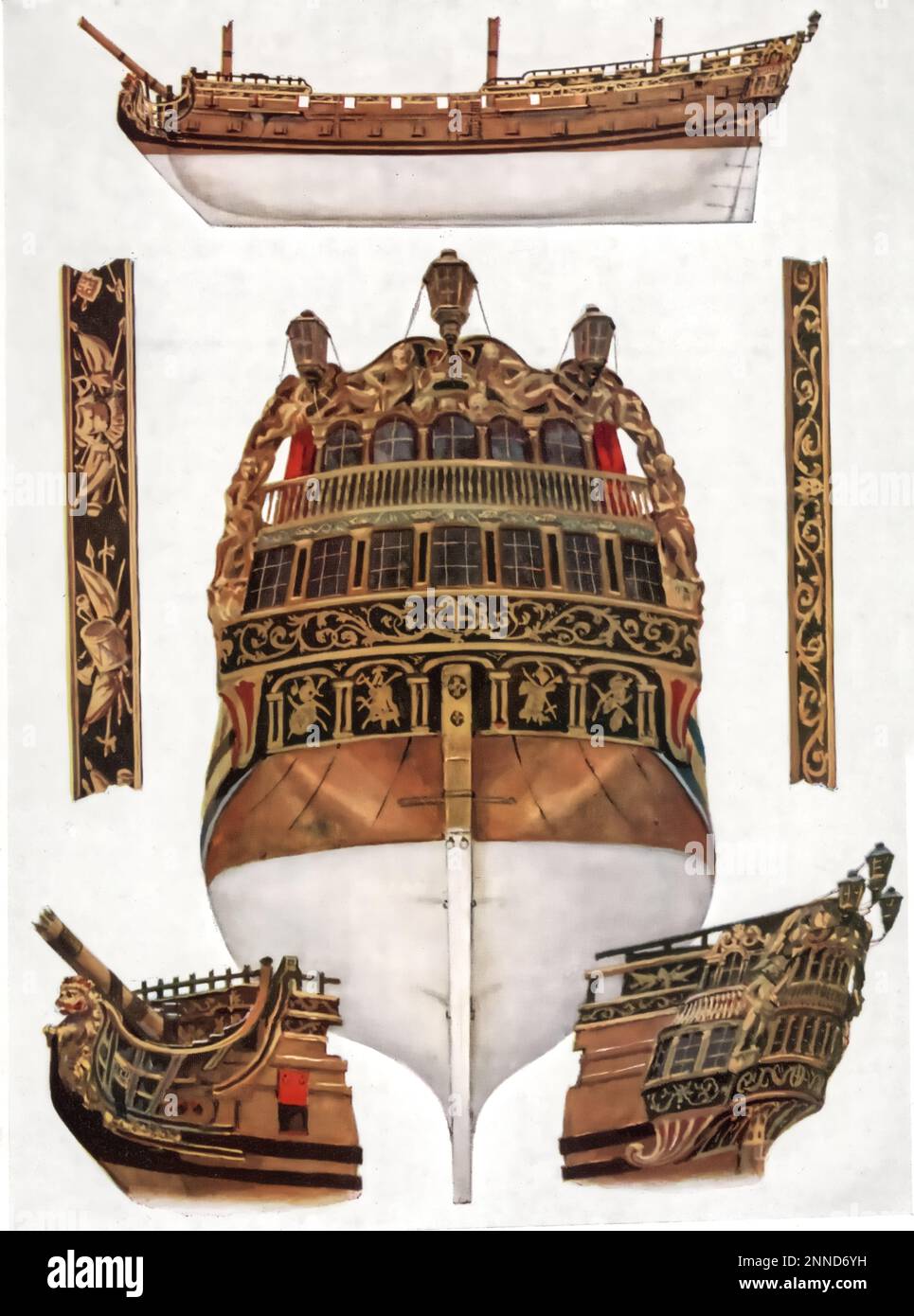 A fourth-rate of King George I (1660-1727), c1927. By Cecil King (1881-1942). An exploded-view of a 17th century fourth-rate. In the rating system of the Royal Navy used to categorize sailing warships in the 18th century, a fourth-rate was a ship of the line with 46 to 60 mounted guns. Stock Photohttps://www.alamy.com/image-license-details/?v=1https://www.alamy.com/a-fourth-rate-of-king-george-i-1660-1727-c1927-by-cecil-king-1881-1942-an-exploded-view-of-a-17th-century-fourth-rate-in-the-rating-system-of-the-royal-navy-used-to-categorize-sailing-warships-in-the-18th-century-a-fourth-rate-was-a-ship-of-the-line-with-46-to-60-mounted-guns-image529509669.html
A fourth-rate of King George I (1660-1727), c1927. By Cecil King (1881-1942). An exploded-view of a 17th century fourth-rate. In the rating system of the Royal Navy used to categorize sailing warships in the 18th century, a fourth-rate was a ship of the line with 46 to 60 mounted guns. Stock Photohttps://www.alamy.com/image-license-details/?v=1https://www.alamy.com/a-fourth-rate-of-king-george-i-1660-1727-c1927-by-cecil-king-1881-1942-an-exploded-view-of-a-17th-century-fourth-rate-in-the-rating-system-of-the-royal-navy-used-to-categorize-sailing-warships-in-the-18th-century-a-fourth-rate-was-a-ship-of-the-line-with-46-to-60-mounted-guns-image529509669.htmlRM2NND6YH–A fourth-rate of King George I (1660-1727), c1927. By Cecil King (1881-1942). An exploded-view of a 17th century fourth-rate. In the rating system of the Royal Navy used to categorize sailing warships in the 18th century, a fourth-rate was a ship of the line with 46 to 60 mounted guns.
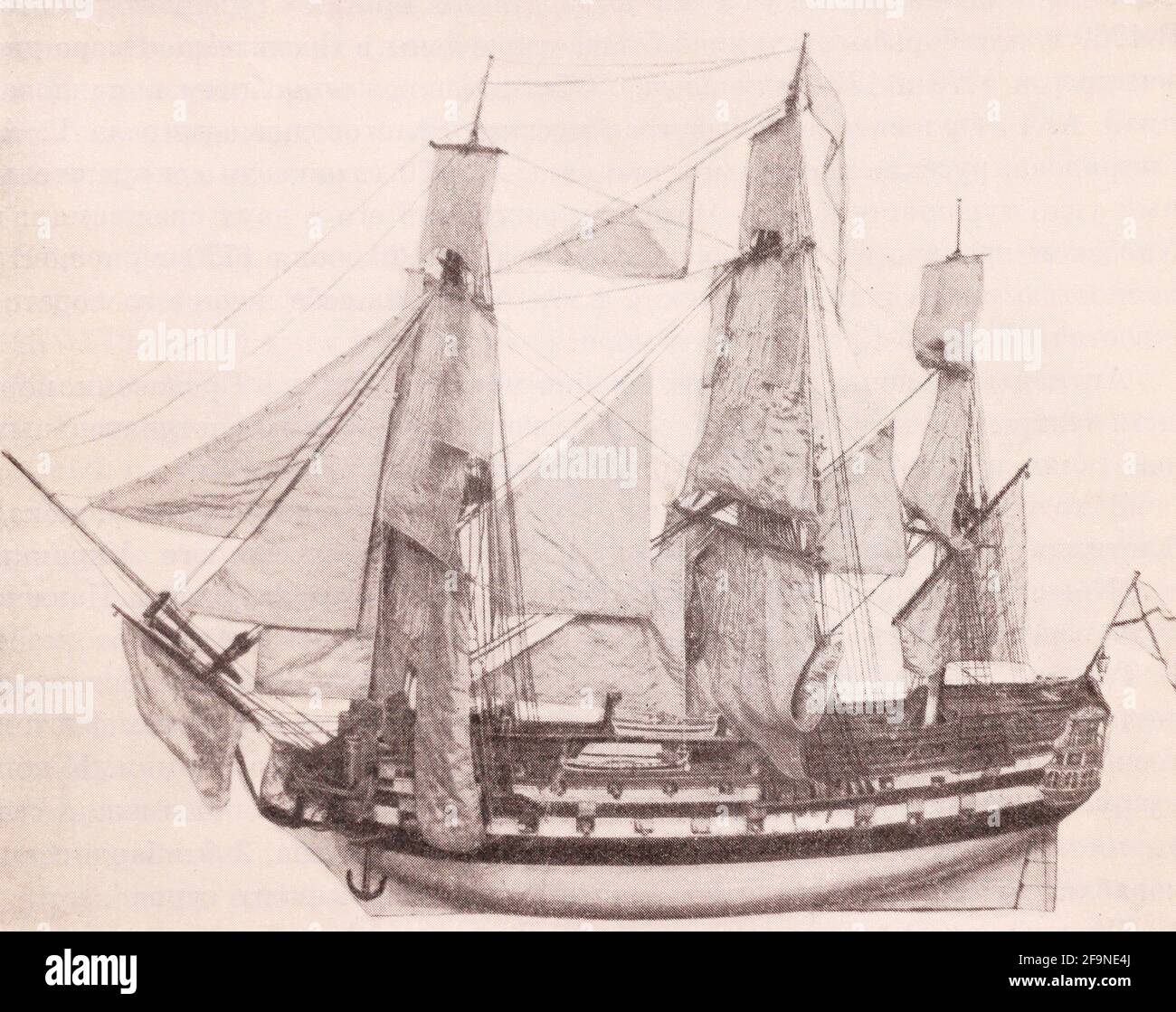 Model of a 54-gun ship from the late 18th century. Stock Photohttps://www.alamy.com/image-license-details/?v=1https://www.alamy.com/model-of-a-54-gun-ship-from-the-late-18th-century-image419052834.html
Model of a 54-gun ship from the late 18th century. Stock Photohttps://www.alamy.com/image-license-details/?v=1https://www.alamy.com/model-of-a-54-gun-ship-from-the-late-18th-century-image419052834.htmlRM2F9NE4J–Model of a 54-gun ship from the late 18th century.
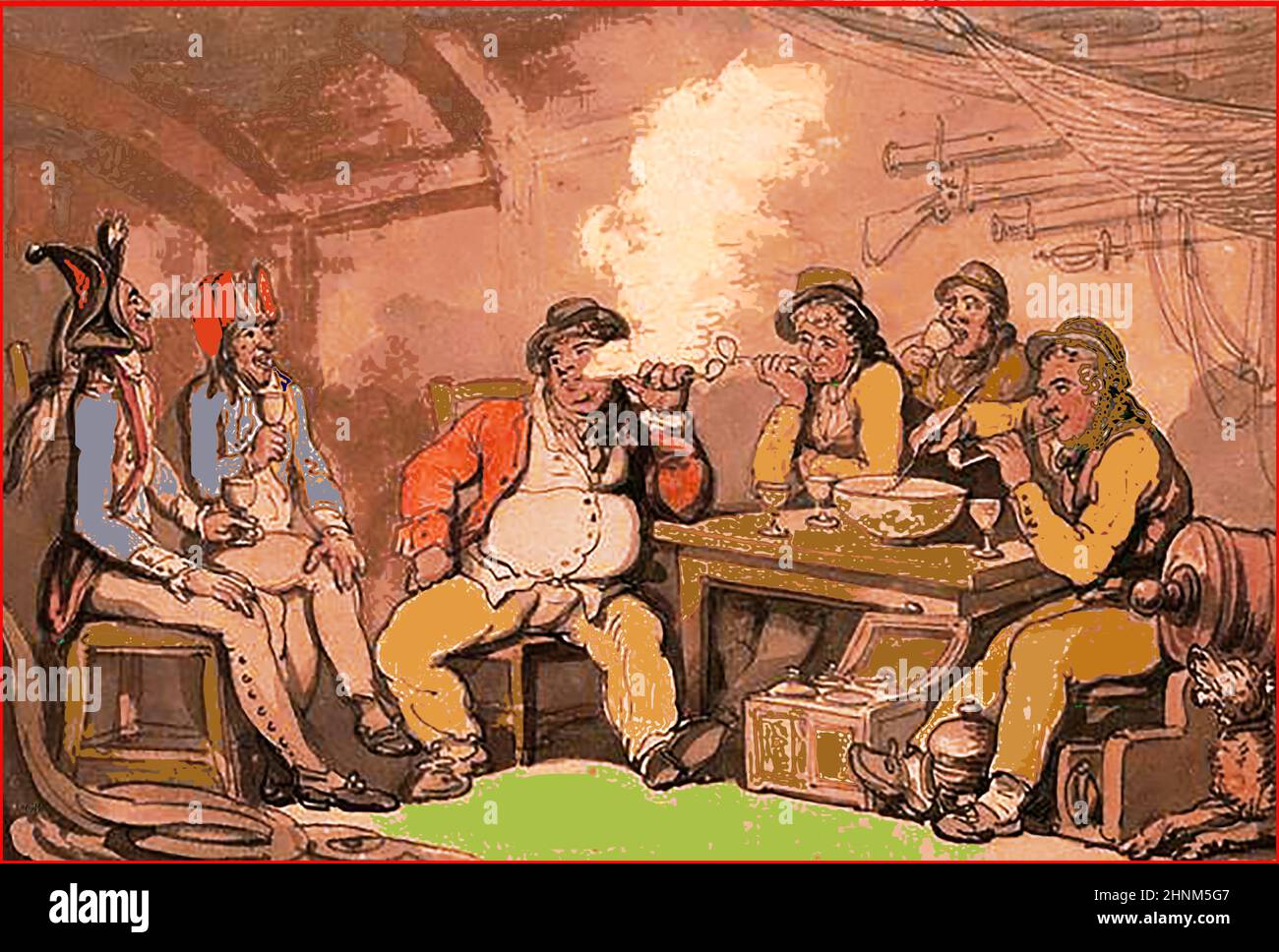 18th century coloured illustration showing French prisoners aboard a British (merchant?) ship being well treated , probably for propaganda purposes Stock Photohttps://www.alamy.com/image-license-details/?v=1https://www.alamy.com/18th-century-coloured-illustration-showing-french-prisoners-aboard-a-british-merchant-ship-being-well-treated-probably-for-propaganda-purposes-image460820759.html
18th century coloured illustration showing French prisoners aboard a British (merchant?) ship being well treated , probably for propaganda purposes Stock Photohttps://www.alamy.com/image-license-details/?v=1https://www.alamy.com/18th-century-coloured-illustration-showing-french-prisoners-aboard-a-british-merchant-ship-being-well-treated-probably-for-propaganda-purposes-image460820759.htmlRM2HNM5G7–18th century coloured illustration showing French prisoners aboard a British (merchant?) ship being well treated , probably for propaganda purposes
 An 18th century sailor of the Royal Navy Heaving the Lead. Stock Photohttps://www.alamy.com/image-license-details/?v=1https://www.alamy.com/stock-photo-an-18th-century-sailor-of-the-royal-navy-heaving-the-lead-31400823.html
An 18th century sailor of the Royal Navy Heaving the Lead. Stock Photohttps://www.alamy.com/image-license-details/?v=1https://www.alamy.com/stock-photo-an-18th-century-sailor-of-the-royal-navy-heaving-the-lead-31400823.htmlRMBR2C1Y–An 18th century sailor of the Royal Navy Heaving the Lead.
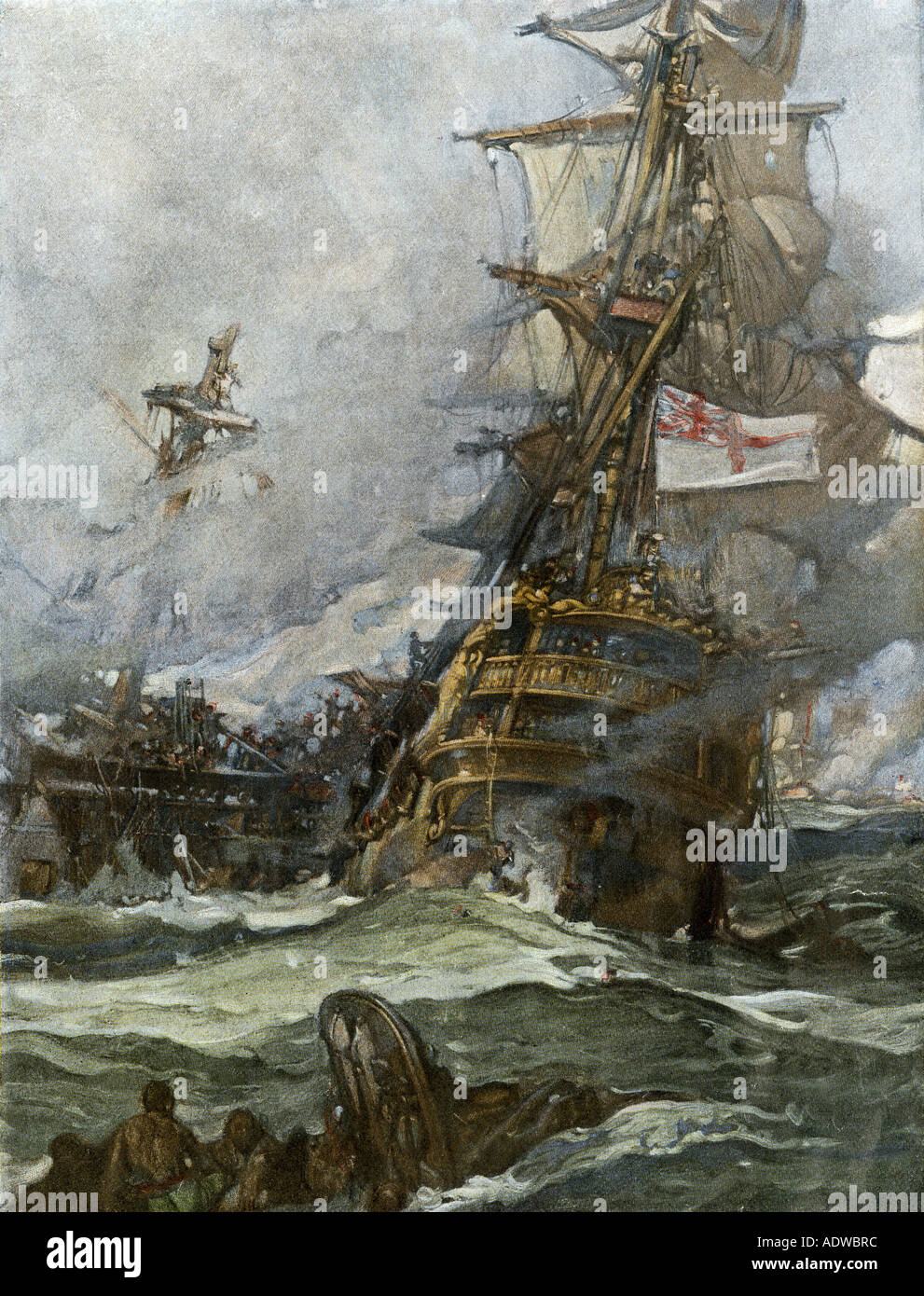 British ship HMS Brunswick in battle with French navy off the coast of Brittany late 1700s. Color halftone of an illustration Stock Photohttps://www.alamy.com/image-license-details/?v=1https://www.alamy.com/british-ship-hms-brunswick-in-battle-with-french-navy-off-the-coast-image7713211.html
British ship HMS Brunswick in battle with French navy off the coast of Brittany late 1700s. Color halftone of an illustration Stock Photohttps://www.alamy.com/image-license-details/?v=1https://www.alamy.com/british-ship-hms-brunswick-in-battle-with-french-navy-off-the-coast-image7713211.htmlRMADWBRC–British ship HMS Brunswick in battle with French navy off the coast of Brittany late 1700s. Color halftone of an illustration
 The Mutiny on the Bounty was a mutiny aboard the Royal Navy ship HMS Bounty on 28 April 1789. The mutiny was led by Fletcher Christian against their captain, Lieutenant William Bligh Stock Photohttps://www.alamy.com/image-license-details/?v=1https://www.alamy.com/the-mutiny-on-the-bounty-was-a-mutiny-aboard-the-royal-navy-ship-hms-bounty-on-28-april-1789-the-mutiny-was-led-by-fletcher-christian-against-their-captain-lieutenant-william-bligh-image225044256.html
The Mutiny on the Bounty was a mutiny aboard the Royal Navy ship HMS Bounty on 28 April 1789. The mutiny was led by Fletcher Christian against their captain, Lieutenant William Bligh Stock Photohttps://www.alamy.com/image-license-details/?v=1https://www.alamy.com/the-mutiny-on-the-bounty-was-a-mutiny-aboard-the-royal-navy-ship-hms-bounty-on-28-april-1789-the-mutiny-was-led-by-fletcher-christian-against-their-captain-lieutenant-william-bligh-image225044256.htmlRMR23J6T–The Mutiny on the Bounty was a mutiny aboard the Royal Navy ship HMS Bounty on 28 April 1789. The mutiny was led by Fletcher Christian against their captain, Lieutenant William Bligh
 John Paul Jones, First Captain of the U.S. Navy, Illustration from the book, 'True Storeis of Great Americans for Young Americans', 1897 Stock Photohttps://www.alamy.com/image-license-details/?v=1https://www.alamy.com/john-paul-jones-first-captain-of-the-us-navy-illustration-from-the-book-true-storeis-of-great-americans-for-young-americans-1897-image209787946.html
John Paul Jones, First Captain of the U.S. Navy, Illustration from the book, 'True Storeis of Great Americans for Young Americans', 1897 Stock Photohttps://www.alamy.com/image-license-details/?v=1https://www.alamy.com/john-paul-jones-first-captain-of-the-us-navy-illustration-from-the-book-true-storeis-of-great-americans-for-young-americans-1897-image209787946.htmlRMP58JJJ–John Paul Jones, First Captain of the U.S. Navy, Illustration from the book, 'True Storeis of Great Americans for Young Americans', 1897
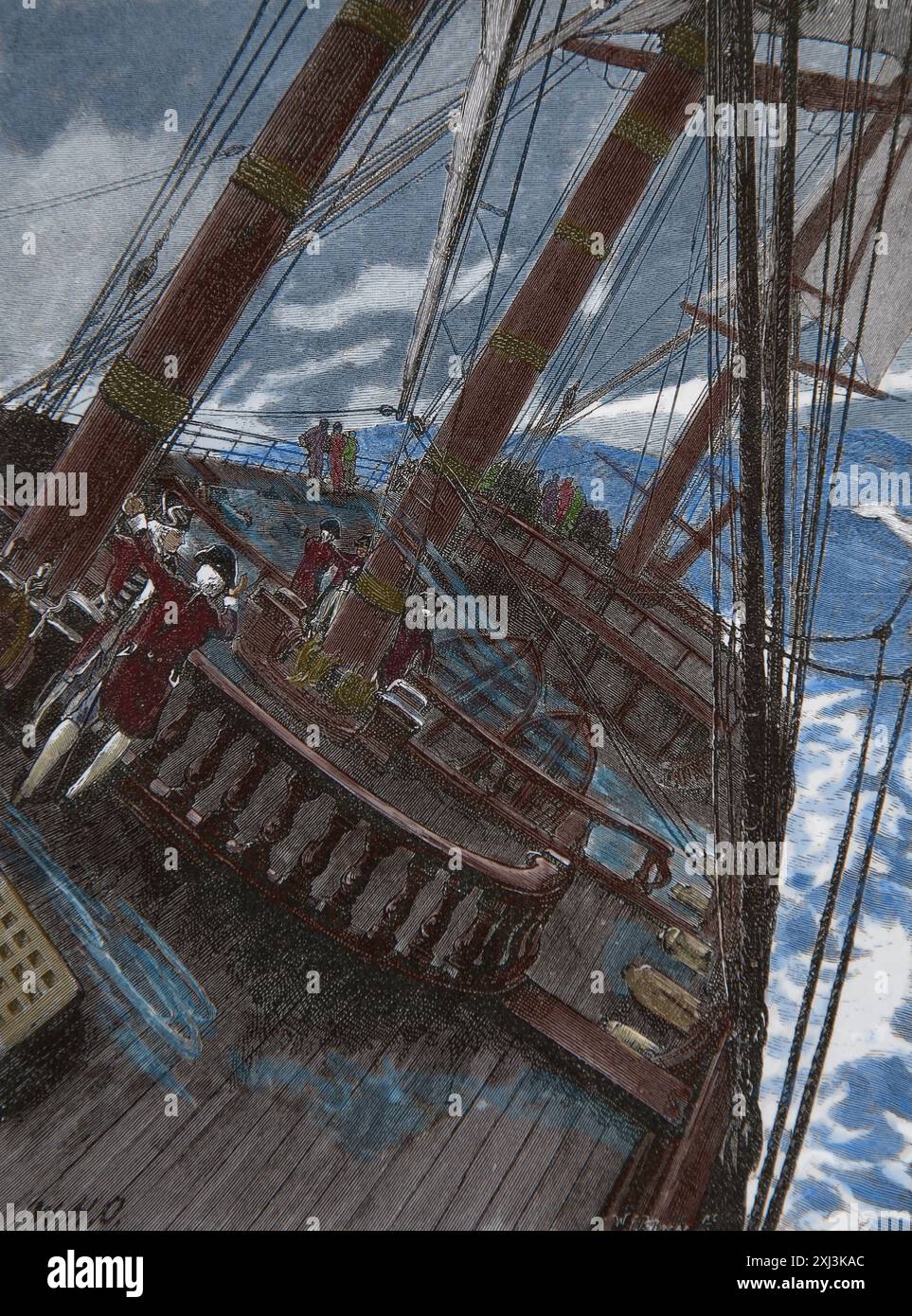 18th century. Europe. British ship. Deck. Engraving, 19th century. Stock Photohttps://www.alamy.com/image-license-details/?v=1https://www.alamy.com/18th-century-europe-british-ship-deck-engraving-19th-century-image613507732.html
18th century. Europe. British ship. Deck. Engraving, 19th century. Stock Photohttps://www.alamy.com/image-license-details/?v=1https://www.alamy.com/18th-century-europe-british-ship-deck-engraving-19th-century-image613507732.htmlRM2XJ3KAC–18th century. Europe. British ship. Deck. Engraving, 19th century.
 'This plate represents the different sailing boats belonging to the Gentlemen of the Cumberland Sailing Society...' 18th century navy. Stock Photohttps://www.alamy.com/image-license-details/?v=1https://www.alamy.com/this-plate-represents-the-different-sailing-boats-belonging-to-the-gentlemen-of-the-cumberland-sailing-society-18th-century-navy-image268821672.html
'This plate represents the different sailing boats belonging to the Gentlemen of the Cumberland Sailing Society...' 18th century navy. Stock Photohttps://www.alamy.com/image-license-details/?v=1https://www.alamy.com/this-plate-represents-the-different-sailing-boats-belonging-to-the-gentlemen-of-the-cumberland-sailing-society-18th-century-navy-image268821672.htmlRMWH9TP0–'This plate represents the different sailing boats belonging to the Gentlemen of the Cumberland Sailing Society...' 18th century navy.
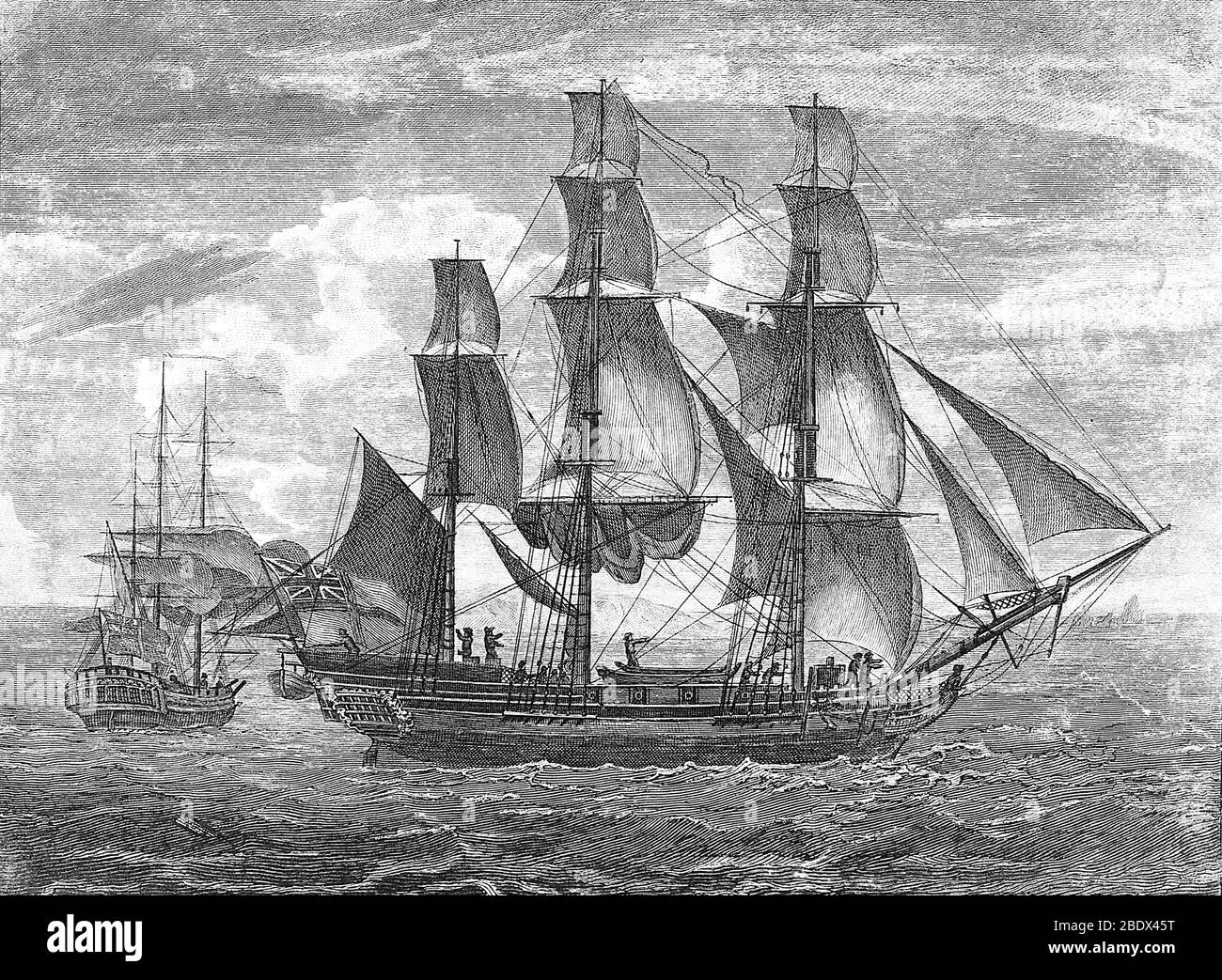 Captain James Cook, HMS Endeavour, 1768 Stock Photohttps://www.alamy.com/image-license-details/?v=1https://www.alamy.com/captain-james-cook-hms-endeavour-1768-image352771940.html
Captain James Cook, HMS Endeavour, 1768 Stock Photohttps://www.alamy.com/image-license-details/?v=1https://www.alamy.com/captain-james-cook-hms-endeavour-1768-image352771940.htmlRM2BDX45T–Captain James Cook, HMS Endeavour, 1768
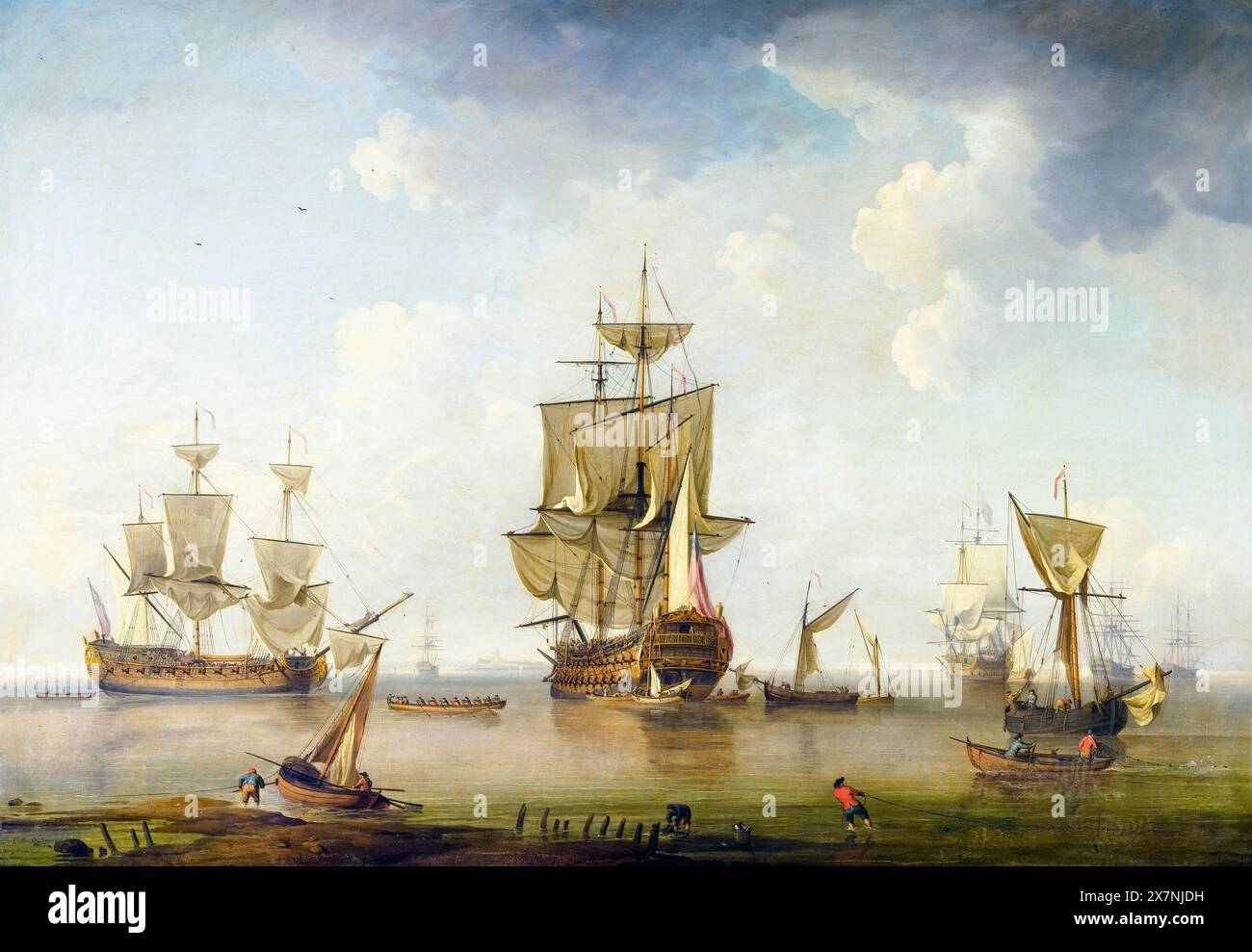 Men of War in Harbour, (18th Century warship) painting in oil on canvas by Charles Brooking, 1745-1755 Stock Photohttps://www.alamy.com/image-license-details/?v=1https://www.alamy.com/men-of-war-in-harbour-18th-century-warship-painting-in-oil-on-canvas-by-charles-brooking-1745-1755-image607140957.html
Men of War in Harbour, (18th Century warship) painting in oil on canvas by Charles Brooking, 1745-1755 Stock Photohttps://www.alamy.com/image-license-details/?v=1https://www.alamy.com/men-of-war-in-harbour-18th-century-warship-painting-in-oil-on-canvas-by-charles-brooking-1745-1755-image607140957.htmlRM2X7NJDH–Men of War in Harbour, (18th Century warship) painting in oil on canvas by Charles Brooking, 1745-1755
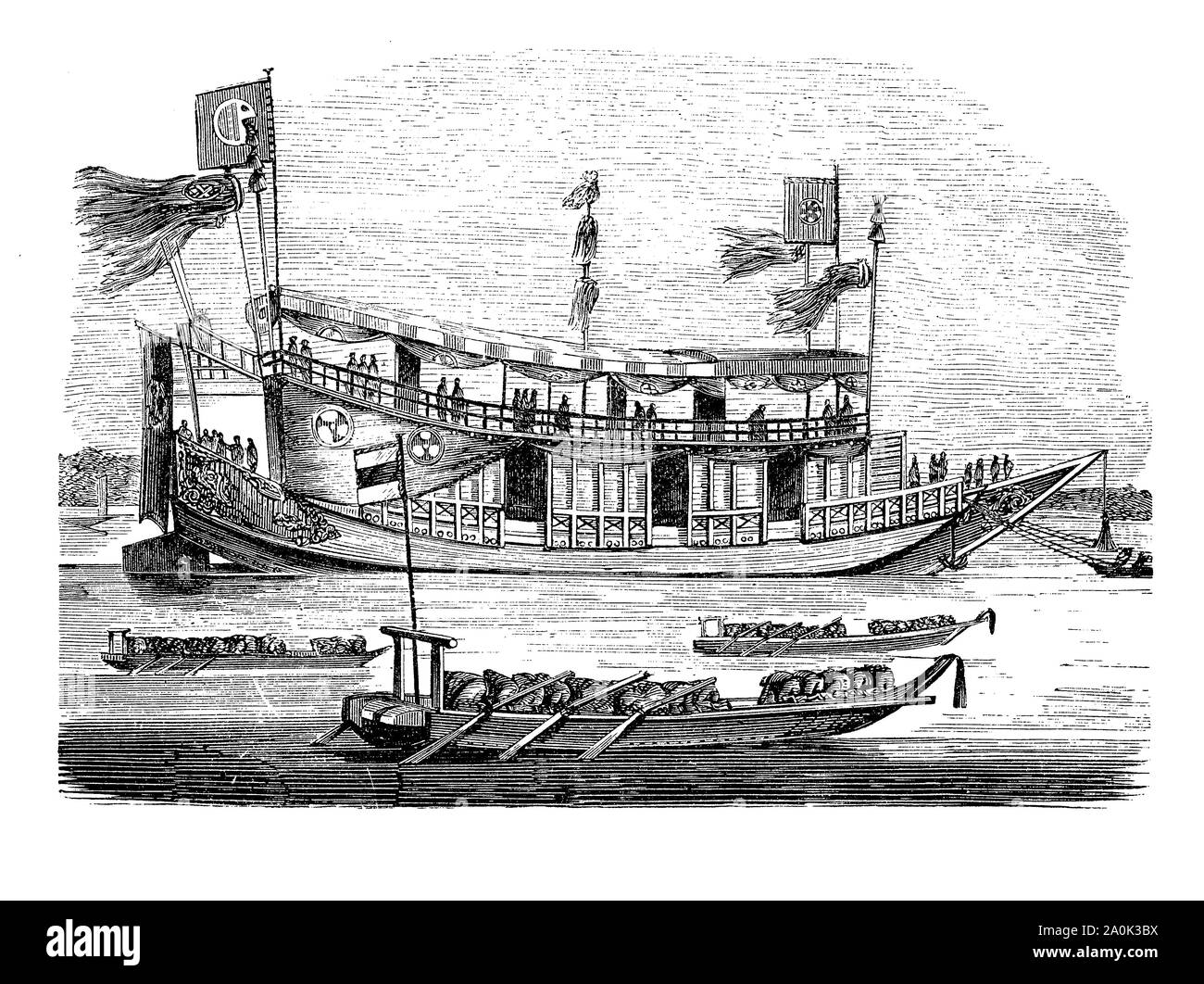 Shogun state ship of 18th century, the military dictator of Japan de facto ruler of the country. The ship was more a floating fortress rather than a true warship used in coastal actions Stock Photohttps://www.alamy.com/image-license-details/?v=1https://www.alamy.com/shogun-state-ship-of-18th-century-the-military-dictator-of-japan-de-facto-ruler-of-the-country-the-ship-was-more-a-floating-fortress-rather-than-a-true-warship-used-in-coastal-actions-image327416766.html
Shogun state ship of 18th century, the military dictator of Japan de facto ruler of the country. The ship was more a floating fortress rather than a true warship used in coastal actions Stock Photohttps://www.alamy.com/image-license-details/?v=1https://www.alamy.com/shogun-state-ship-of-18th-century-the-military-dictator-of-japan-de-facto-ruler-of-the-country-the-ship-was-more-a-floating-fortress-rather-than-a-true-warship-used-in-coastal-actions-image327416766.htmlRF2A0K3BX–Shogun state ship of 18th century, the military dictator of Japan de facto ruler of the country. The ship was more a floating fortress rather than a true warship used in coastal actions
 British Men of War, 18th century: first rate, barge, seventy four, etc. Stock Photohttps://www.alamy.com/image-license-details/?v=1https://www.alamy.com/stock-photo-british-men-of-war-18th-century-first-rate-barge-seventy-four-etc-72535521.html
British Men of War, 18th century: first rate, barge, seventy four, etc. Stock Photohttps://www.alamy.com/image-license-details/?v=1https://www.alamy.com/stock-photo-british-men-of-war-18th-century-first-rate-barge-seventy-four-etc-72535521.htmlRME607P9–British Men of War, 18th century: first rate, barge, seventy four, etc.
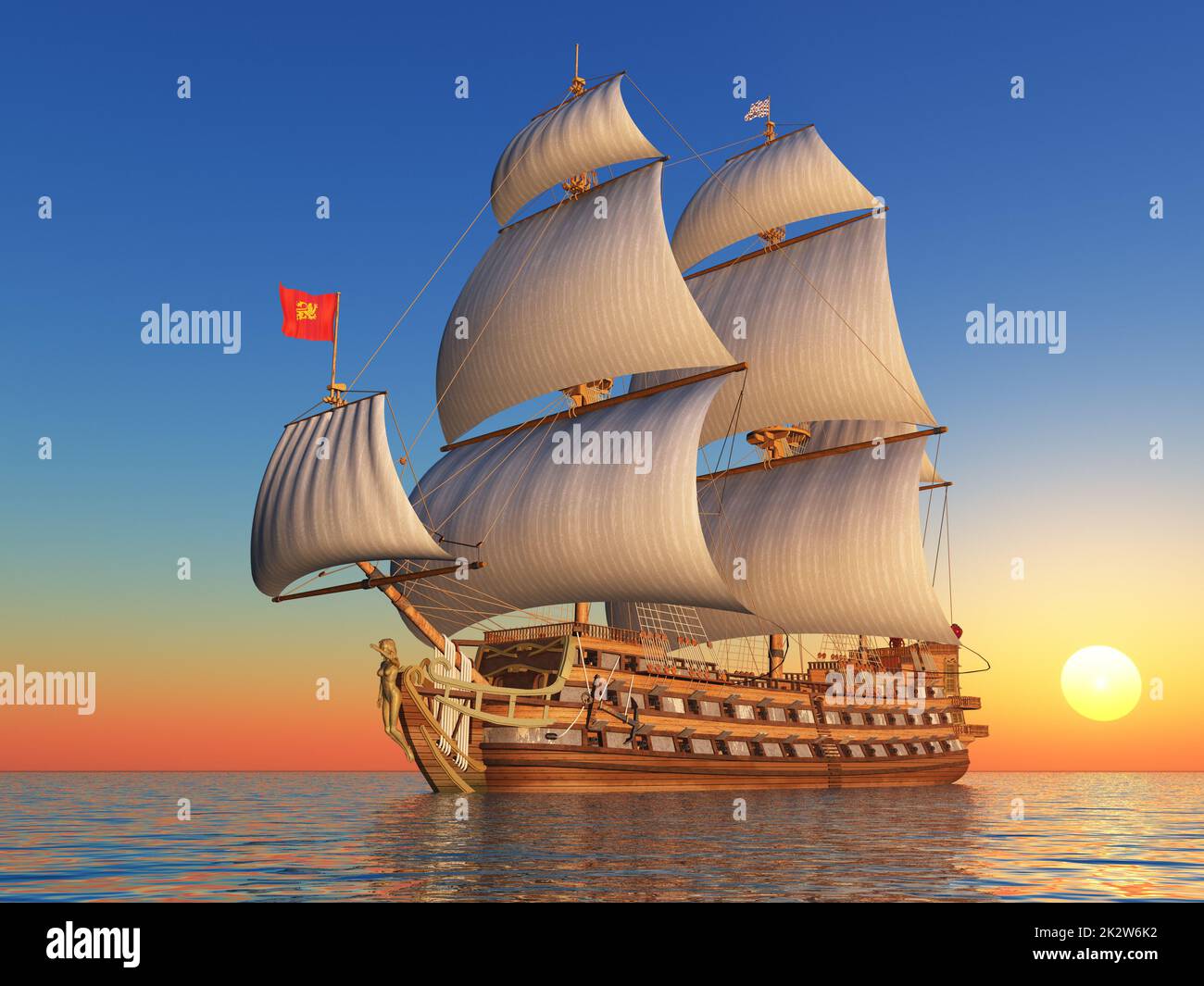 French warship of the 18th century at sunset Stock Photohttps://www.alamy.com/image-license-details/?v=1https://www.alamy.com/french-warship-of-the-18th-century-at-sunset-image483673654.html
French warship of the 18th century at sunset Stock Photohttps://www.alamy.com/image-license-details/?v=1https://www.alamy.com/french-warship-of-the-18th-century-at-sunset-image483673654.htmlRF2K2W6K2–French warship of the 18th century at sunset
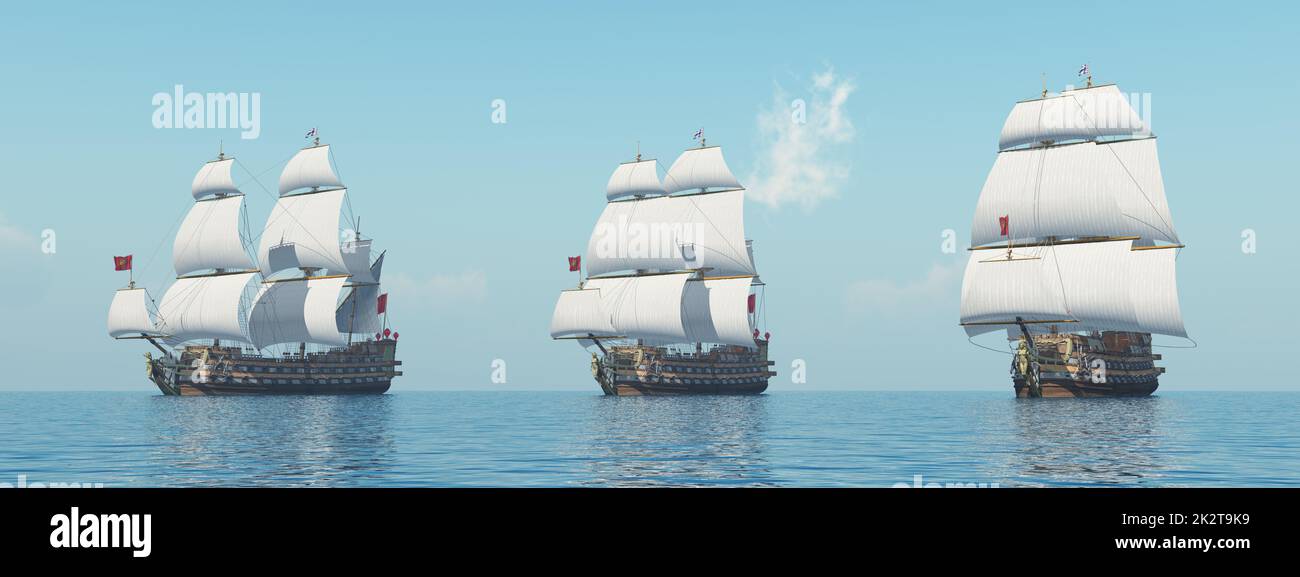 French warships of the 18th century Stock Photohttps://www.alamy.com/image-license-details/?v=1https://www.alamy.com/french-warships-of-the-18th-century-image483654061.html
French warships of the 18th century Stock Photohttps://www.alamy.com/image-license-details/?v=1https://www.alamy.com/french-warships-of-the-18th-century-image483654061.htmlRF2K2T9K9–French warships of the 18th century
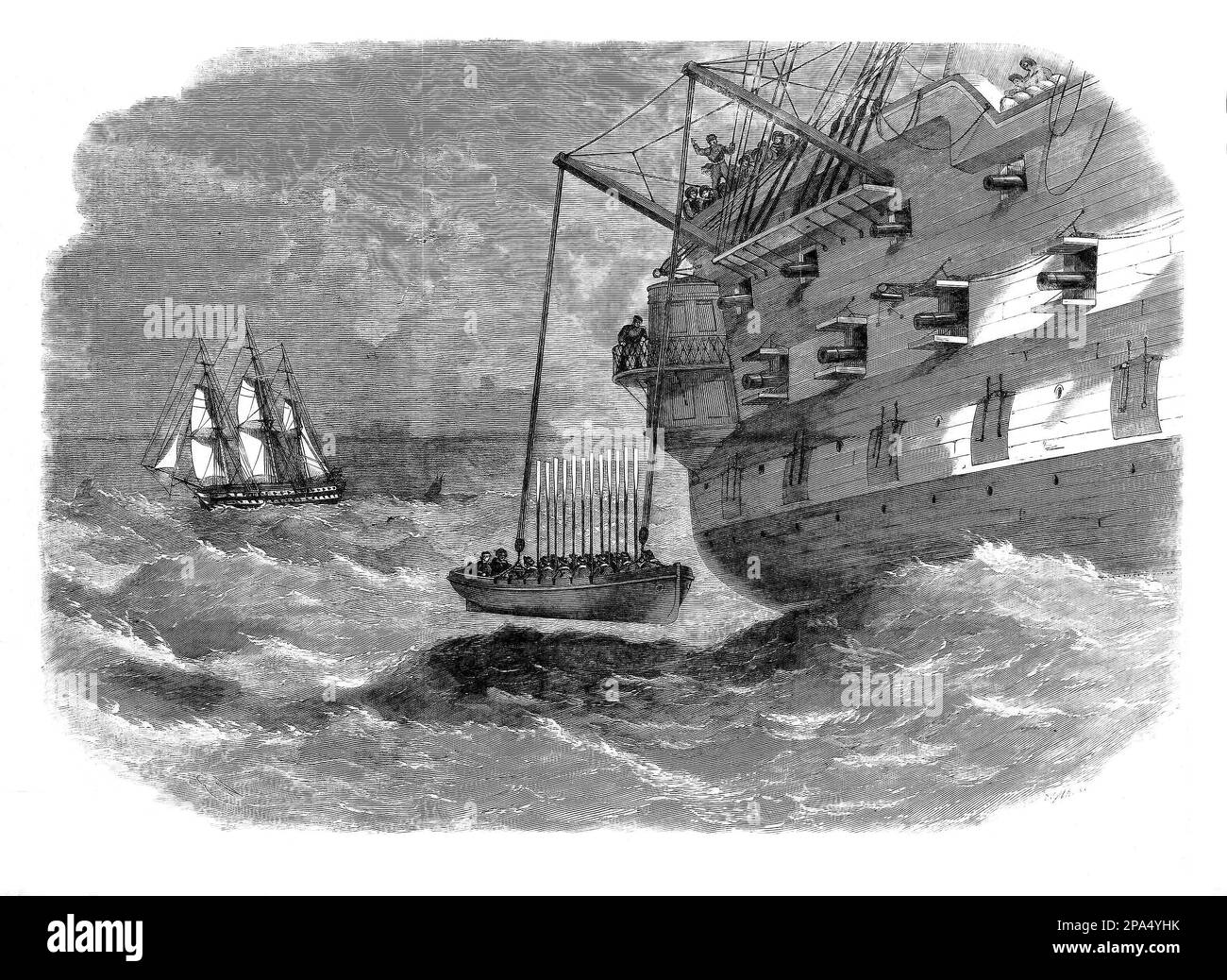 Davits began to be introduced into Royal Navy warships in the late 18th-century and originally took the form of squared baulks of timber. Davit systems are most often used to lower an emergency lifeboat to the embarkation level to be boarded and also used as man-overboard safety devices to retrieve personnel from the water. Stock Photohttps://www.alamy.com/image-license-details/?v=1https://www.alamy.com/davits-began-to-be-introduced-into-royal-navy-warships-in-the-late-18th-century-and-originally-took-the-form-of-squared-baulks-of-timber-davit-systems-are-most-often-used-to-lower-an-emergency-lifeboat-to-the-embarkation-level-to-be-boarded-and-also-used-as-man-overboard-safety-devices-to-retrieve-personnel-from-the-water-image539777439.html
Davits began to be introduced into Royal Navy warships in the late 18th-century and originally took the form of squared baulks of timber. Davit systems are most often used to lower an emergency lifeboat to the embarkation level to be boarded and also used as man-overboard safety devices to retrieve personnel from the water. Stock Photohttps://www.alamy.com/image-license-details/?v=1https://www.alamy.com/davits-began-to-be-introduced-into-royal-navy-warships-in-the-late-18th-century-and-originally-took-the-form-of-squared-baulks-of-timber-davit-systems-are-most-often-used-to-lower-an-emergency-lifeboat-to-the-embarkation-level-to-be-boarded-and-also-used-as-man-overboard-safety-devices-to-retrieve-personnel-from-the-water-image539777439.htmlRM2PA4YHK–Davits began to be introduced into Royal Navy warships in the late 18th-century and originally took the form of squared baulks of timber. Davit systems are most often used to lower an emergency lifeboat to the embarkation level to be boarded and also used as man-overboard safety devices to retrieve personnel from the water.
 The English and the Natives HMS Bounty, also known as HM Armed Vessel Bounty, was a small merchant vessel that the Royal Navy purchased in 1787 for a botanical mission. The ship was sent to the South Pacific Ocean under the command of William Bligh to acquire breadfruit plants and transport them to the West Indies. That mission was never completed owing to a 1789 mutiny led by acting lieutenant Fletcher Christian, an incident now popularly known as the mutiny on the Bounty. The mutineers later burned Bounty while she was moored at Pitcairn Island. Stock Photohttps://www.alamy.com/image-license-details/?v=1https://www.alamy.com/the-english-and-the-natives-hms-bounty-also-known-as-hm-armed-vessel-bounty-was-a-small-merchant-vessel-that-the-royal-navy-purchased-in-1787-for-a-botanical-mission-the-ship-was-sent-to-the-south-pacific-ocean-under-the-command-of-william-bligh-to-acquire-breadfruit-plants-and-transport-them-to-the-west-indies-that-mission-was-never-completed-owing-to-a-1789-mutiny-led-by-acting-lieutenant-fletcher-christian-an-incident-now-popularly-known-as-the-mutiny-on-the-bounty-the-mutineers-later-burned-bounty-while-she-was-moored-at-pitcairn-island-image447693679.html
The English and the Natives HMS Bounty, also known as HM Armed Vessel Bounty, was a small merchant vessel that the Royal Navy purchased in 1787 for a botanical mission. The ship was sent to the South Pacific Ocean under the command of William Bligh to acquire breadfruit plants and transport them to the West Indies. That mission was never completed owing to a 1789 mutiny led by acting lieutenant Fletcher Christian, an incident now popularly known as the mutiny on the Bounty. The mutineers later burned Bounty while she was moored at Pitcairn Island. Stock Photohttps://www.alamy.com/image-license-details/?v=1https://www.alamy.com/the-english-and-the-natives-hms-bounty-also-known-as-hm-armed-vessel-bounty-was-a-small-merchant-vessel-that-the-royal-navy-purchased-in-1787-for-a-botanical-mission-the-ship-was-sent-to-the-south-pacific-ocean-under-the-command-of-william-bligh-to-acquire-breadfruit-plants-and-transport-them-to-the-west-indies-that-mission-was-never-completed-owing-to-a-1789-mutiny-led-by-acting-lieutenant-fletcher-christian-an-incident-now-popularly-known-as-the-mutiny-on-the-bounty-the-mutineers-later-burned-bounty-while-she-was-moored-at-pitcairn-island-image447693679.htmlRF2H0A5RY–The English and the Natives HMS Bounty, also known as HM Armed Vessel Bounty, was a small merchant vessel that the Royal Navy purchased in 1787 for a botanical mission. The ship was sent to the South Pacific Ocean under the command of William Bligh to acquire breadfruit plants and transport them to the West Indies. That mission was never completed owing to a 1789 mutiny led by acting lieutenant Fletcher Christian, an incident now popularly known as the mutiny on the Bounty. The mutineers later burned Bounty while she was moored at Pitcairn Island.
 Brest, France in 1791. Engraved by LeBreton. From Histoire de la Revolution Francaise by Louis Blanc Stock Photohttps://www.alamy.com/image-license-details/?v=1https://www.alamy.com/brest-france-in-1791-engraved-by-lebreton-from-histoire-de-la-revolution-image4363982.html
Brest, France in 1791. Engraved by LeBreton. From Histoire de la Revolution Francaise by Louis Blanc Stock Photohttps://www.alamy.com/image-license-details/?v=1https://www.alamy.com/brest-france-in-1791-engraved-by-lebreton-from-histoire-de-la-revolution-image4363982.htmlRMADBJCF–Brest, France in 1791. Engraved by LeBreton. From Histoire de la Revolution Francaise by Louis Blanc
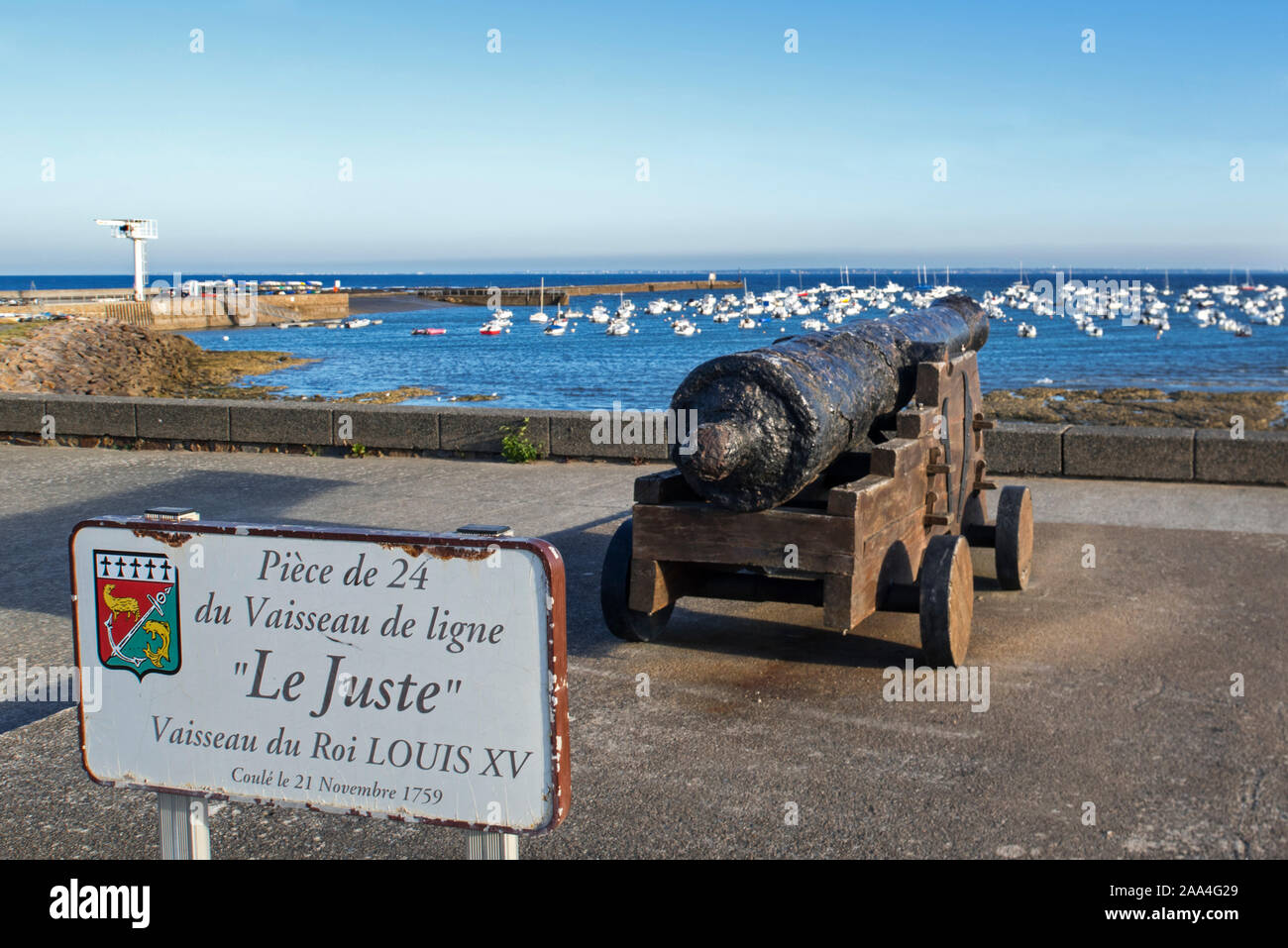 Salvaged 18th century ship's cannon from the Juste, ship of the line of the French Navy at Préfailles, Pointe Saint-Gildas, Loire-Atlantique, France Stock Photohttps://www.alamy.com/image-license-details/?v=1https://www.alamy.com/salvaged-18th-century-ships-cannon-from-the-juste-ship-of-the-line-of-the-french-navy-at-prfailles-pointe-saint-gildas-loire-atlantique-france-image333243969.html
Salvaged 18th century ship's cannon from the Juste, ship of the line of the French Navy at Préfailles, Pointe Saint-Gildas, Loire-Atlantique, France Stock Photohttps://www.alamy.com/image-license-details/?v=1https://www.alamy.com/salvaged-18th-century-ships-cannon-from-the-juste-ship-of-the-line-of-the-french-navy-at-prfailles-pointe-saint-gildas-loire-atlantique-france-image333243969.htmlRM2AA4G29–Salvaged 18th century ship's cannon from the Juste, ship of the line of the French Navy at Préfailles, Pointe Saint-Gildas, Loire-Atlantique, France
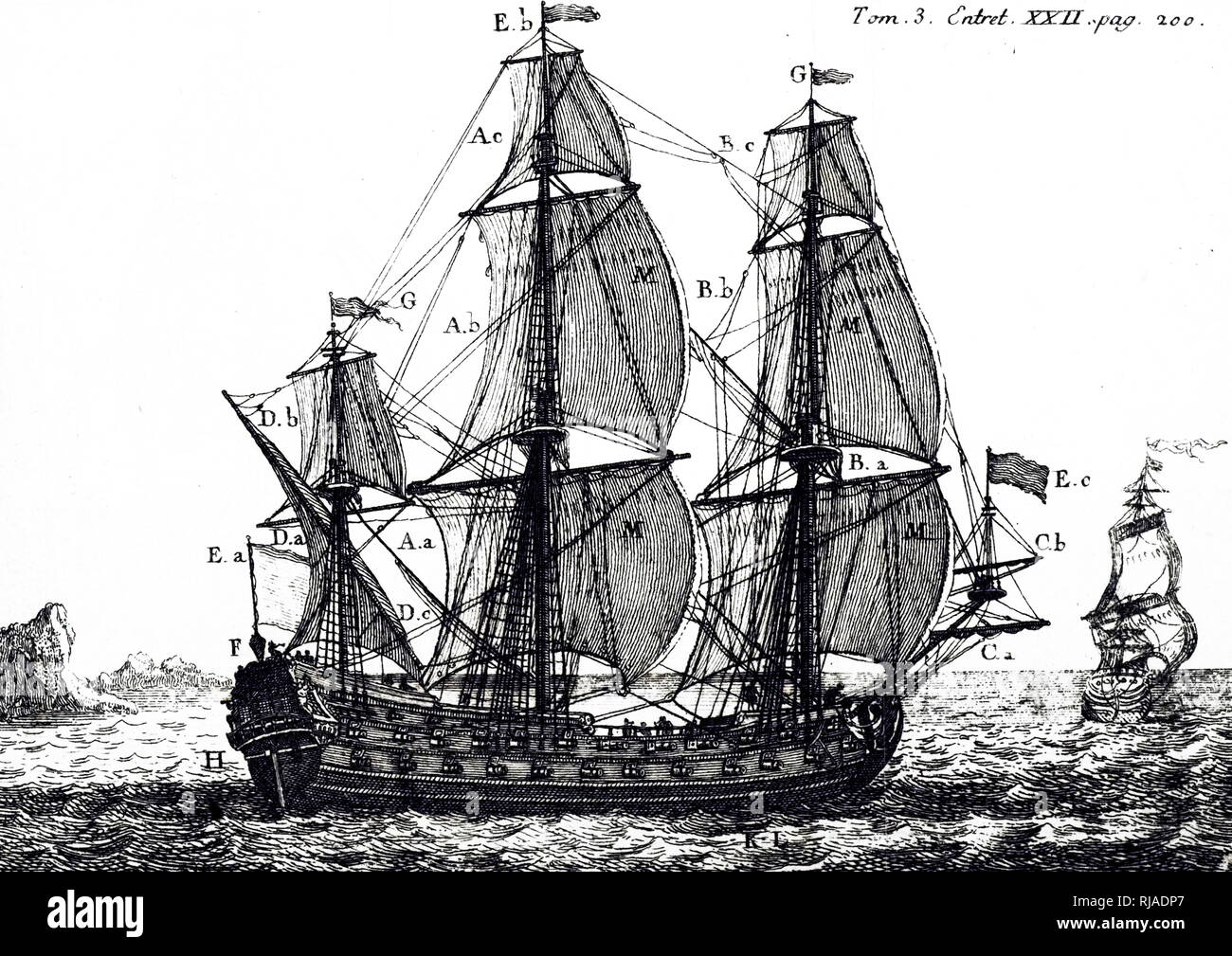 A woodblock engraving depicting a first-rate ship of the line carrying sail. Dated 18th century Stock Photohttps://www.alamy.com/image-license-details/?v=1https://www.alamy.com/a-woodblock-engraving-depicting-a-first-rate-ship-of-the-line-carrying-sail-dated-18th-century-image235028927.html
A woodblock engraving depicting a first-rate ship of the line carrying sail. Dated 18th century Stock Photohttps://www.alamy.com/image-license-details/?v=1https://www.alamy.com/a-woodblock-engraving-depicting-a-first-rate-ship-of-the-line-carrying-sail-dated-18th-century-image235028927.htmlRMRJADP7–A woodblock engraving depicting a first-rate ship of the line carrying sail. Dated 18th century
 Vintage 1922 print entitled “The First Journey of Victory, 1778” depicting the famous Royal Navy ship HMS Victory at sea. Victory, best known for her role as Vice-Admiral Nelson’s flagship at the Battle of Trafalgar in 1805, was launched from Chatham Dockyard in 1765 but did not enter active service until 1778 after France joined the American War of Independence. Artist William Lionel Wyllie and his son Harold were heavily involved in the ship’s restoration and preservation in the early 20th century and Victory is today a museum vessel in dry dock in Portsmouth. Stock Photohttps://www.alamy.com/image-license-details/?v=1https://www.alamy.com/vintage-1922-print-entitled-the-first-journey-of-victory-1778-depicting-the-famous-royal-navy-ship-hms-victory-at-sea-victory-best-known-for-her-role-as-vice-admiral-nelsons-flagship-at-the-battle-of-trafalgar-in-1805-was-launched-from-chatham-dockyard-in-1765-but-did-not-enter-active-service-until-1778-after-france-joined-the-american-war-of-independence-artist-william-lionel-wyllie-and-his-son-harold-were-heavily-involved-in-the-ships-restoration-and-preservation-in-the-early-20th-century-and-victory-is-today-a-museum-vessel-in-dry-dock-in-portsmouth-image264545806.html
Vintage 1922 print entitled “The First Journey of Victory, 1778” depicting the famous Royal Navy ship HMS Victory at sea. Victory, best known for her role as Vice-Admiral Nelson’s flagship at the Battle of Trafalgar in 1805, was launched from Chatham Dockyard in 1765 but did not enter active service until 1778 after France joined the American War of Independence. Artist William Lionel Wyllie and his son Harold were heavily involved in the ship’s restoration and preservation in the early 20th century and Victory is today a museum vessel in dry dock in Portsmouth. Stock Photohttps://www.alamy.com/image-license-details/?v=1https://www.alamy.com/vintage-1922-print-entitled-the-first-journey-of-victory-1778-depicting-the-famous-royal-navy-ship-hms-victory-at-sea-victory-best-known-for-her-role-as-vice-admiral-nelsons-flagship-at-the-battle-of-trafalgar-in-1805-was-launched-from-chatham-dockyard-in-1765-but-did-not-enter-active-service-until-1778-after-france-joined-the-american-war-of-independence-artist-william-lionel-wyllie-and-his-son-harold-were-heavily-involved-in-the-ships-restoration-and-preservation-in-the-early-20th-century-and-victory-is-today-a-museum-vessel-in-dry-dock-in-portsmouth-image264545806.htmlRMWAB2TE–Vintage 1922 print entitled “The First Journey of Victory, 1778” depicting the famous Royal Navy ship HMS Victory at sea. Victory, best known for her role as Vice-Admiral Nelson’s flagship at the Battle of Trafalgar in 1805, was launched from Chatham Dockyard in 1765 but did not enter active service until 1778 after France joined the American War of Independence. Artist William Lionel Wyllie and his son Harold were heavily involved in the ship’s restoration and preservation in the early 20th century and Victory is today a museum vessel in dry dock in Portsmouth.
 PIRATES SHOUT DEFIANCE AT A ROYAL NAVY SHIP Stock Photohttps://www.alamy.com/image-license-details/?v=1https://www.alamy.com/pirates-shout-defiance-at-a-royal-navy-ship-image263432498.html
PIRATES SHOUT DEFIANCE AT A ROYAL NAVY SHIP Stock Photohttps://www.alamy.com/image-license-details/?v=1https://www.alamy.com/pirates-shout-defiance-at-a-royal-navy-ship-image263432498.htmlRMW8GARE–PIRATES SHOUT DEFIANCE AT A ROYAL NAVY SHIP
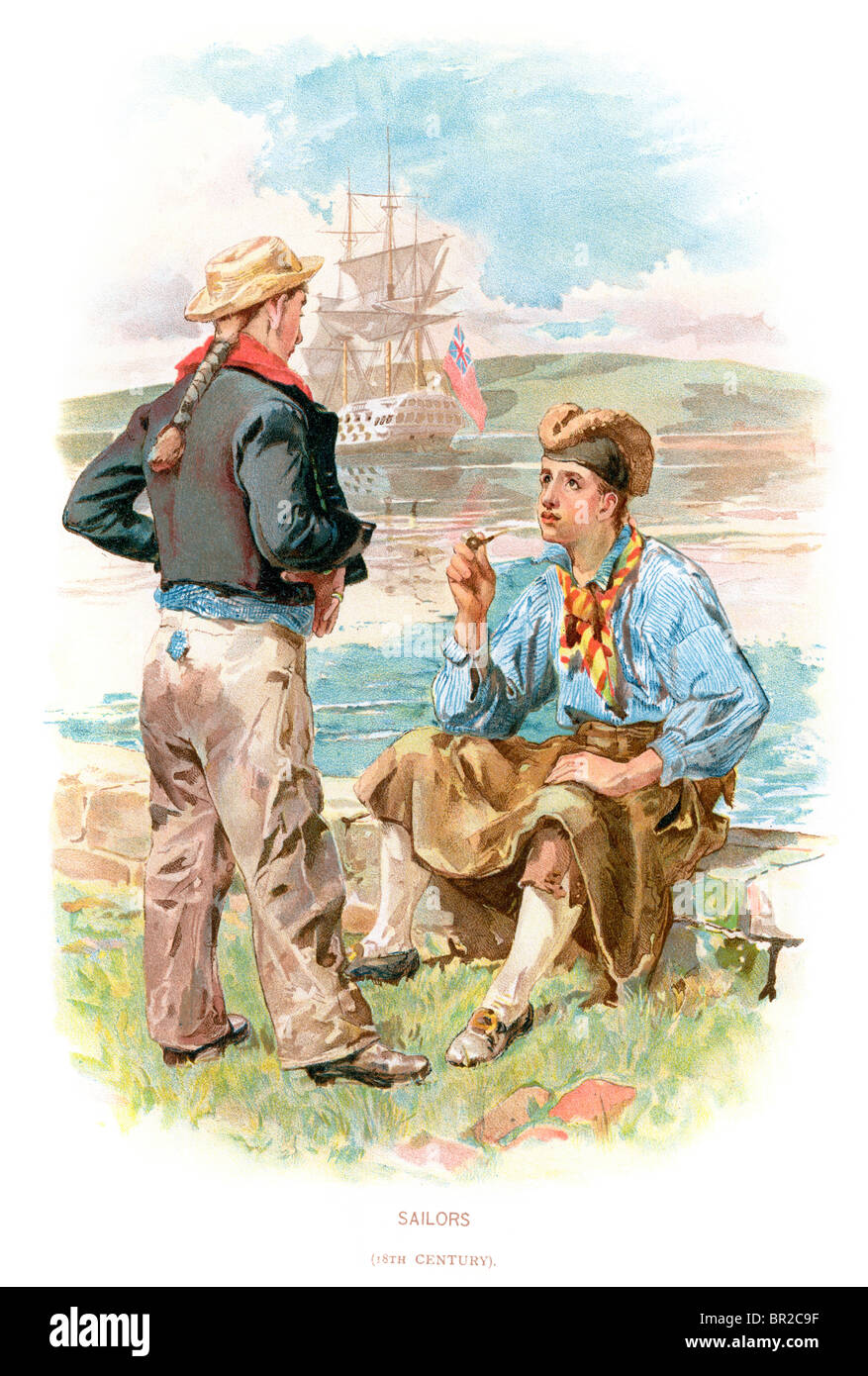 Two Royal Navy sailors from the 18th Century. (Symons 99) Stock Photohttps://www.alamy.com/image-license-details/?v=1https://www.alamy.com/stock-photo-two-royal-navy-sailors-from-the-18th-century-symons-99-31401035.html
Two Royal Navy sailors from the 18th Century. (Symons 99) Stock Photohttps://www.alamy.com/image-license-details/?v=1https://www.alamy.com/stock-photo-two-royal-navy-sailors-from-the-18th-century-symons-99-31401035.htmlRMBR2C9F–Two Royal Navy sailors from the 18th Century. (Symons 99)
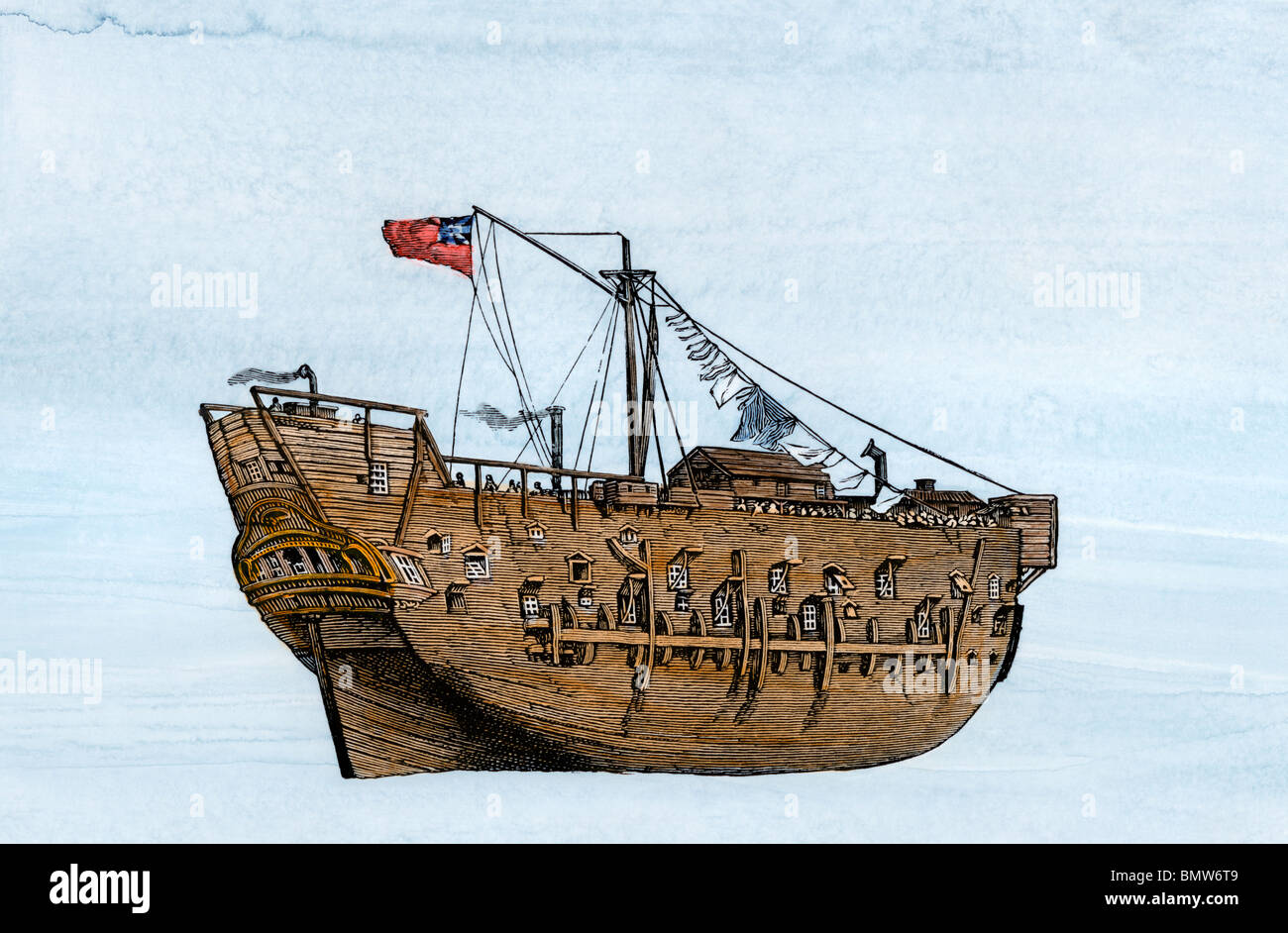 Captain James Cook's ship 'Discovery'. Hand-colored woodcut Stock Photohttps://www.alamy.com/image-license-details/?v=1https://www.alamy.com/stock-photo-captain-james-cooks-ship-discovery-hand-colored-woodcut-30057673.html
Captain James Cook's ship 'Discovery'. Hand-colored woodcut Stock Photohttps://www.alamy.com/image-license-details/?v=1https://www.alamy.com/stock-photo-captain-james-cooks-ship-discovery-hand-colored-woodcut-30057673.htmlRMBMW6T9–Captain James Cook's ship 'Discovery'. Hand-colored woodcut
 Philip James de Loutherbourg French school The Battle of Camperdown 1799 Oil on canvas (152 x 214 cm) London, Tate Modern Stock Photohttps://www.alamy.com/image-license-details/?v=1https://www.alamy.com/philip-james-de-loutherbourg-french-school-the-battle-of-camperdown-1799-oil-on-canvas-152-x-214-cm-london-tate-modern-image483534951.html
Philip James de Loutherbourg French school The Battle of Camperdown 1799 Oil on canvas (152 x 214 cm) London, Tate Modern Stock Photohttps://www.alamy.com/image-license-details/?v=1https://www.alamy.com/philip-james-de-loutherbourg-french-school-the-battle-of-camperdown-1799-oil-on-canvas-152-x-214-cm-london-tate-modern-image483534951.htmlRM2K2JWNB–Philip James de Loutherbourg French school The Battle of Camperdown 1799 Oil on canvas (152 x 214 cm) London, Tate Modern
 American Revolutionary War. Siege of Boston (April 19, 1775 - March 17, 1776). Departure of the British fleet. On March 17, 1776, British forces were forced to evacuate the city of Boston following General George Washington’s successful placement of fortifications and artillery on Dorchester Heights, which overlooks Boston fom the south. Engraving by Petit. Panorama Universal. History of the United States of America, from 1st edition of Jean B.G. Roux de Rochelle's Etats-Unis d'Amérique in 1837. Spanish edition, printed in Barcelona, 1850. Later colouration. Stock Photohttps://www.alamy.com/image-license-details/?v=1https://www.alamy.com/american-revolutionary-war-siege-of-boston-april-19-1775-march-17-1776-departure-of-the-british-fleet-on-march-17-1776-british-forces-were-forced-to-evacuate-the-city-of-boston-following-general-george-washingtons-successful-placement-of-fortifications-and-artillery-on-dorchester-heights-which-overlooks-boston-fom-the-south-engraving-by-petit-panorama-universal-history-of-the-united-states-of-america-from-1st-edition-of-jean-bg-roux-de-rochelles-etats-unis-damrique-in-1837-spanish-edition-printed-in-barcelona-1850-later-colouration-image386266203.html
American Revolutionary War. Siege of Boston (April 19, 1775 - March 17, 1776). Departure of the British fleet. On March 17, 1776, British forces were forced to evacuate the city of Boston following General George Washington’s successful placement of fortifications and artillery on Dorchester Heights, which overlooks Boston fom the south. Engraving by Petit. Panorama Universal. History of the United States of America, from 1st edition of Jean B.G. Roux de Rochelle's Etats-Unis d'Amérique in 1837. Spanish edition, printed in Barcelona, 1850. Later colouration. Stock Photohttps://www.alamy.com/image-license-details/?v=1https://www.alamy.com/american-revolutionary-war-siege-of-boston-april-19-1775-march-17-1776-departure-of-the-british-fleet-on-march-17-1776-british-forces-were-forced-to-evacuate-the-city-of-boston-following-general-george-washingtons-successful-placement-of-fortifications-and-artillery-on-dorchester-heights-which-overlooks-boston-fom-the-south-engraving-by-petit-panorama-universal-history-of-the-united-states-of-america-from-1st-edition-of-jean-bg-roux-de-rochelles-etats-unis-damrique-in-1837-spanish-edition-printed-in-barcelona-1850-later-colouration-image386266203.htmlRM2DCBXDF–American Revolutionary War. Siege of Boston (April 19, 1775 - March 17, 1776). Departure of the British fleet. On March 17, 1776, British forces were forced to evacuate the city of Boston following General George Washington’s successful placement of fortifications and artillery on Dorchester Heights, which overlooks Boston fom the south. Engraving by Petit. Panorama Universal. History of the United States of America, from 1st edition of Jean B.G. Roux de Rochelle's Etats-Unis d'Amérique in 1837. Spanish edition, printed in Barcelona, 1850. Later colouration.
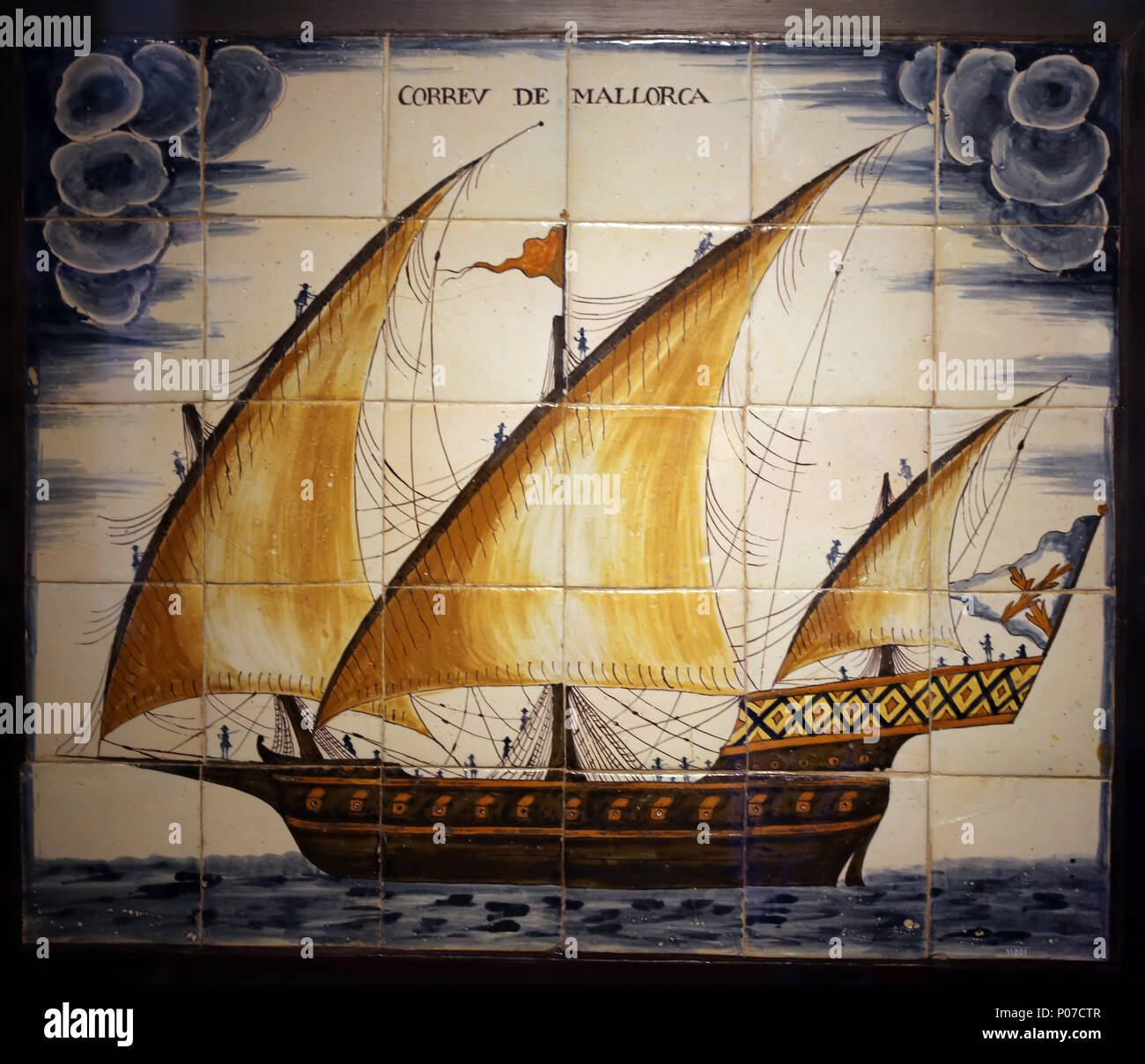 Ceramic panel depicting the Mail of Mallorca. Xebec type ship, 18th century. Barcelona Maritime Museum. Spain. Stock Photohttps://www.alamy.com/image-license-details/?v=1https://www.alamy.com/ceramic-panel-depicting-the-mail-of-mallorca-xebec-type-ship-18th-century-barcelona-maritime-museum-spain-image206688183.html
Ceramic panel depicting the Mail of Mallorca. Xebec type ship, 18th century. Barcelona Maritime Museum. Spain. Stock Photohttps://www.alamy.com/image-license-details/?v=1https://www.alamy.com/ceramic-panel-depicting-the-mail-of-mallorca-xebec-type-ship-18th-century-barcelona-maritime-museum-spain-image206688183.htmlRMP07CTR–Ceramic panel depicting the Mail of Mallorca. Xebec type ship, 18th century. Barcelona Maritime Museum. Spain.
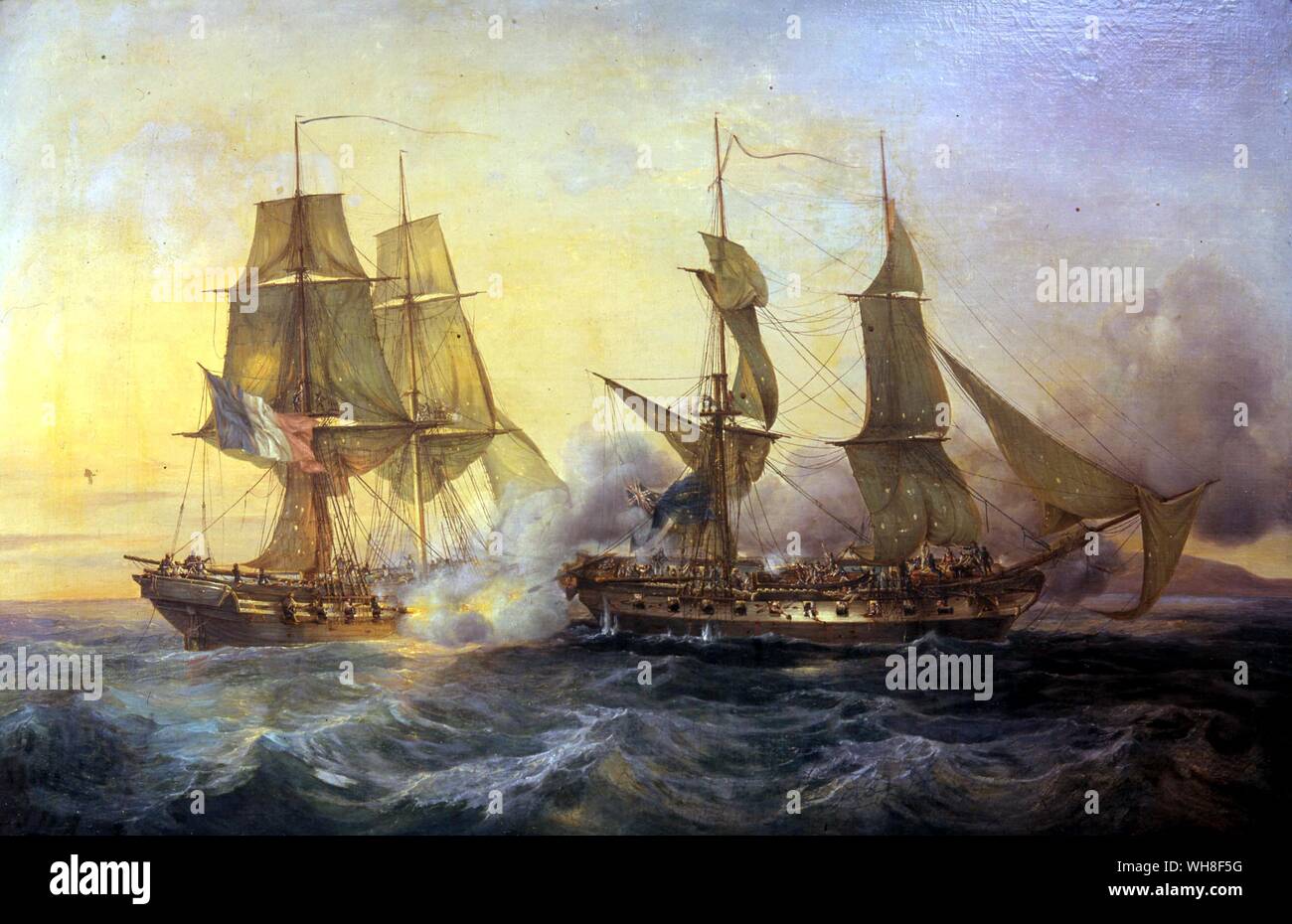 Brigs Fighting. Two-masted sailing ship with square rigging on both masts. Naval brigs carried a battery of ten to twenty guns on a single deck. In the great European Navies of the 18th and 19th centuries, they served as couriers for battle fleets and as training vessels for cadets. In the early U.S. Navy, brigs acquired distinction during the War of 1812 in small fleet engagements on the Great Lakes and as merchant raiders in the Atlantic. Square rigging required a large crew, so merchant brigs became uneconomical, and in the 19th century they began to give way to such fore-and-aft rigged Stock Photohttps://www.alamy.com/image-license-details/?v=1https://www.alamy.com/brigs-fighting-two-masted-sailing-ship-with-square-rigging-on-both-masts-naval-brigs-carried-a-battery-of-ten-to-twenty-guns-on-a-single-deck-in-the-great-european-navies-of-the-18th-and-19th-centuries-they-served-as-couriers-for-battle-fleets-and-as-training-vessels-for-cadets-in-the-early-us-navy-brigs-acquired-distinction-during-the-war-of-1812-in-small-fleet-engagements-on-the-great-lakes-and-as-merchant-raiders-in-the-atlantic-square-rigging-required-a-large-crew-so-merchant-brigs-became-uneconomical-and-in-the-19th-century-they-began-to-give-way-to-such-fore-and-aft-rigged-image268792204.html
Brigs Fighting. Two-masted sailing ship with square rigging on both masts. Naval brigs carried a battery of ten to twenty guns on a single deck. In the great European Navies of the 18th and 19th centuries, they served as couriers for battle fleets and as training vessels for cadets. In the early U.S. Navy, brigs acquired distinction during the War of 1812 in small fleet engagements on the Great Lakes and as merchant raiders in the Atlantic. Square rigging required a large crew, so merchant brigs became uneconomical, and in the 19th century they began to give way to such fore-and-aft rigged Stock Photohttps://www.alamy.com/image-license-details/?v=1https://www.alamy.com/brigs-fighting-two-masted-sailing-ship-with-square-rigging-on-both-masts-naval-brigs-carried-a-battery-of-ten-to-twenty-guns-on-a-single-deck-in-the-great-european-navies-of-the-18th-and-19th-centuries-they-served-as-couriers-for-battle-fleets-and-as-training-vessels-for-cadets-in-the-early-us-navy-brigs-acquired-distinction-during-the-war-of-1812-in-small-fleet-engagements-on-the-great-lakes-and-as-merchant-raiders-in-the-atlantic-square-rigging-required-a-large-crew-so-merchant-brigs-became-uneconomical-and-in-the-19th-century-they-began-to-give-way-to-such-fore-and-aft-rigged-image268792204.htmlRMWH8F5G–Brigs Fighting. Two-masted sailing ship with square rigging on both masts. Naval brigs carried a battery of ten to twenty guns on a single deck. In the great European Navies of the 18th and 19th centuries, they served as couriers for battle fleets and as training vessels for cadets. In the early U.S. Navy, brigs acquired distinction during the War of 1812 in small fleet engagements on the Great Lakes and as merchant raiders in the Atlantic. Square rigging required a large crew, so merchant brigs became uneconomical, and in the 19th century they began to give way to such fore-and-aft rigged
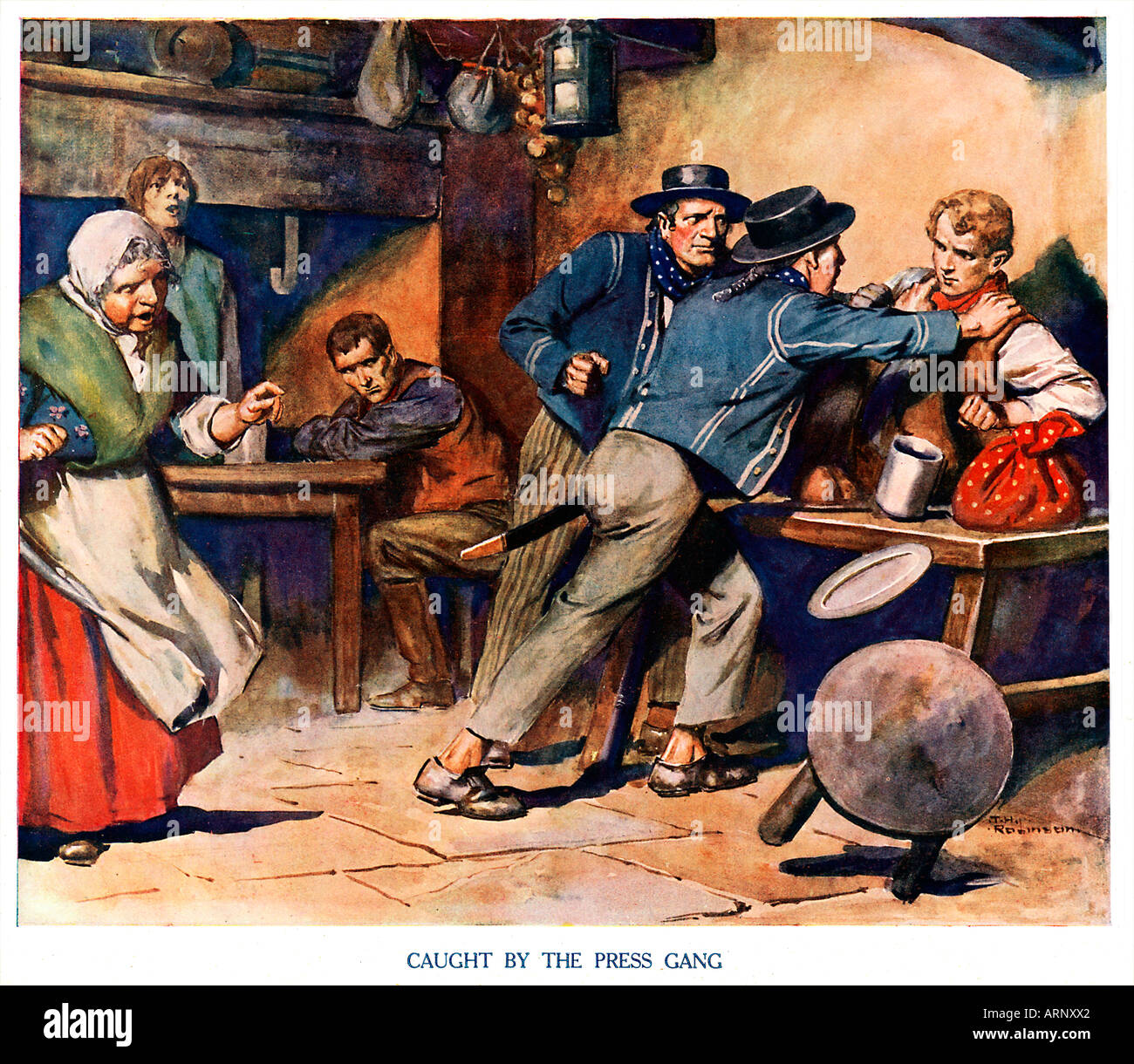 Caught By The Press Gang recruitment for the Navy and the scourge of English port taverns in the 18th Century Stock Photohttps://www.alamy.com/image-license-details/?v=1https://www.alamy.com/caught-by-the-press-gang-recruitment-for-the-navy-and-the-scourge-image9199905.html
Caught By The Press Gang recruitment for the Navy and the scourge of English port taverns in the 18th Century Stock Photohttps://www.alamy.com/image-license-details/?v=1https://www.alamy.com/caught-by-the-press-gang-recruitment-for-the-navy-and-the-scourge-image9199905.htmlRMARNXX2–Caught By The Press Gang recruitment for the Navy and the scourge of English port taverns in the 18th Century
 Lisbon, Portugal - March the 1st, 2020: Principe da Beira warship stern, 1774. Scale model. Navy Museum, Lisbon, Portugal Stock Photohttps://www.alamy.com/image-license-details/?v=1https://www.alamy.com/lisbon-portugal-march-the-1st-2020-principe-da-beira-warship-stern-1774-scale-model-navy-museum-lisbon-portugal-image392902235.html
Lisbon, Portugal - March the 1st, 2020: Principe da Beira warship stern, 1774. Scale model. Navy Museum, Lisbon, Portugal Stock Photohttps://www.alamy.com/image-license-details/?v=1https://www.alamy.com/lisbon-portugal-march-the-1st-2020-principe-da-beira-warship-stern-1774-scale-model-navy-museum-lisbon-portugal-image392902235.htmlRM2DR66PK–Lisbon, Portugal - March the 1st, 2020: Principe da Beira warship stern, 1774. Scale model. Navy Museum, Lisbon, Portugal
 Royal Navy Post Captain, 18th century (c1890-c1893). Artist: Unknown Stock Photohttps://www.alamy.com/image-license-details/?v=1https://www.alamy.com/royal-navy-post-captain-18th-century-c1890-c1893-artist-unknown-image262768085.html
Royal Navy Post Captain, 18th century (c1890-c1893). Artist: Unknown Stock Photohttps://www.alamy.com/image-license-details/?v=1https://www.alamy.com/royal-navy-post-captain-18th-century-c1890-c1893-artist-unknown-image262768085.htmlRMW7E3AD–Royal Navy Post Captain, 18th century (c1890-c1893). Artist: Unknown
![crustaceans collected and described on the voyage. from the book ' A voyage towards the North Pole : undertaken by His Majesty's command, 1773 ' by Constantine John Phipps, Baron Mulgrave, 1744-1792; The 1773 Phipps expedition towards the North Pole was a British Royal Navy expedition in which two ships under the commands of Constantine John Phipps as Captain of the HMS Racehorse [an 18-gun ship-rigged sloop of the Royal Navy.] and Skeffington Lutwidge as Captain of the HMS Carcass [a bomb vessel of the Royal Navy], sailed towards the North Pole in the summer of 1773 and became stuck in ice n Stock Photo crustaceans collected and described on the voyage. from the book ' A voyage towards the North Pole : undertaken by His Majesty's command, 1773 ' by Constantine John Phipps, Baron Mulgrave, 1744-1792; The 1773 Phipps expedition towards the North Pole was a British Royal Navy expedition in which two ships under the commands of Constantine John Phipps as Captain of the HMS Racehorse [an 18-gun ship-rigged sloop of the Royal Navy.] and Skeffington Lutwidge as Captain of the HMS Carcass [a bomb vessel of the Royal Navy], sailed towards the North Pole in the summer of 1773 and became stuck in ice n Stock Photo](https://c8.alamy.com/comp/2GB5C9F/crustaceans-collected-and-described-on-the-voyage-from-the-book-a-voyage-towards-the-north-pole-undertaken-by-his-majestys-command-1773-by-constantine-john-phipps-baron-mulgrave-1744-1792-the-1773-phipps-expedition-towards-the-north-pole-was-a-british-royal-navy-expedition-in-which-two-ships-under-the-commands-of-constantine-john-phipps-as-captain-of-the-hms-racehorse-an-18-gun-ship-rigged-sloop-of-the-royal-navy-and-skeffington-lutwidge-as-captain-of-the-hms-carcass-a-bomb-vessel-of-the-royal-navy-sailed-towards-the-north-pole-in-the-summer-of-1773-and-became-stuck-in-ice-n-2GB5C9F.jpg) crustaceans collected and described on the voyage. from the book ' A voyage towards the North Pole : undertaken by His Majesty's command, 1773 ' by Constantine John Phipps, Baron Mulgrave, 1744-1792; The 1773 Phipps expedition towards the North Pole was a British Royal Navy expedition in which two ships under the commands of Constantine John Phipps as Captain of the HMS Racehorse [an 18-gun ship-rigged sloop of the Royal Navy.] and Skeffington Lutwidge as Captain of the HMS Carcass [a bomb vessel of the Royal Navy], sailed towards the North Pole in the summer of 1773 and became stuck in ice n Stock Photohttps://www.alamy.com/image-license-details/?v=1https://www.alamy.com/crustaceans-collected-and-described-on-the-voyage-from-the-book-a-voyage-towards-the-north-pole-undertaken-by-his-majestys-command-1773-by-constantine-john-phipps-baron-mulgrave-1744-1792-the-1773-phipps-expedition-towards-the-north-pole-was-a-british-royal-navy-expedition-in-which-two-ships-under-the-commands-of-constantine-john-phipps-as-captain-of-the-hms-racehorse-an-18-gun-ship-rigged-sloop-of-the-royal-navy-and-skeffington-lutwidge-as-captain-of-the-hms-carcass-a-bomb-vessel-of-the-royal-navy-sailed-towards-the-north-pole-in-the-summer-of-1773-and-became-stuck-in-ice-n-image437139851.html
crustaceans collected and described on the voyage. from the book ' A voyage towards the North Pole : undertaken by His Majesty's command, 1773 ' by Constantine John Phipps, Baron Mulgrave, 1744-1792; The 1773 Phipps expedition towards the North Pole was a British Royal Navy expedition in which two ships under the commands of Constantine John Phipps as Captain of the HMS Racehorse [an 18-gun ship-rigged sloop of the Royal Navy.] and Skeffington Lutwidge as Captain of the HMS Carcass [a bomb vessel of the Royal Navy], sailed towards the North Pole in the summer of 1773 and became stuck in ice n Stock Photohttps://www.alamy.com/image-license-details/?v=1https://www.alamy.com/crustaceans-collected-and-described-on-the-voyage-from-the-book-a-voyage-towards-the-north-pole-undertaken-by-his-majestys-command-1773-by-constantine-john-phipps-baron-mulgrave-1744-1792-the-1773-phipps-expedition-towards-the-north-pole-was-a-british-royal-navy-expedition-in-which-two-ships-under-the-commands-of-constantine-john-phipps-as-captain-of-the-hms-racehorse-an-18-gun-ship-rigged-sloop-of-the-royal-navy-and-skeffington-lutwidge-as-captain-of-the-hms-carcass-a-bomb-vessel-of-the-royal-navy-sailed-towards-the-north-pole-in-the-summer-of-1773-and-became-stuck-in-ice-n-image437139851.htmlRM2GB5C9F–crustaceans collected and described on the voyage. from the book ' A voyage towards the North Pole : undertaken by His Majesty's command, 1773 ' by Constantine John Phipps, Baron Mulgrave, 1744-1792; The 1773 Phipps expedition towards the North Pole was a British Royal Navy expedition in which two ships under the commands of Constantine John Phipps as Captain of the HMS Racehorse [an 18-gun ship-rigged sloop of the Royal Navy.] and Skeffington Lutwidge as Captain of the HMS Carcass [a bomb vessel of the Royal Navy], sailed towards the North Pole in the summer of 1773 and became stuck in ice n
 French warship of the 18th century Stock Photohttps://www.alamy.com/image-license-details/?v=1https://www.alamy.com/french-warship-of-the-18th-century-image483654060.html
French warship of the 18th century Stock Photohttps://www.alamy.com/image-license-details/?v=1https://www.alamy.com/french-warship-of-the-18th-century-image483654060.htmlRF2K2T9K8–French warship of the 18th century
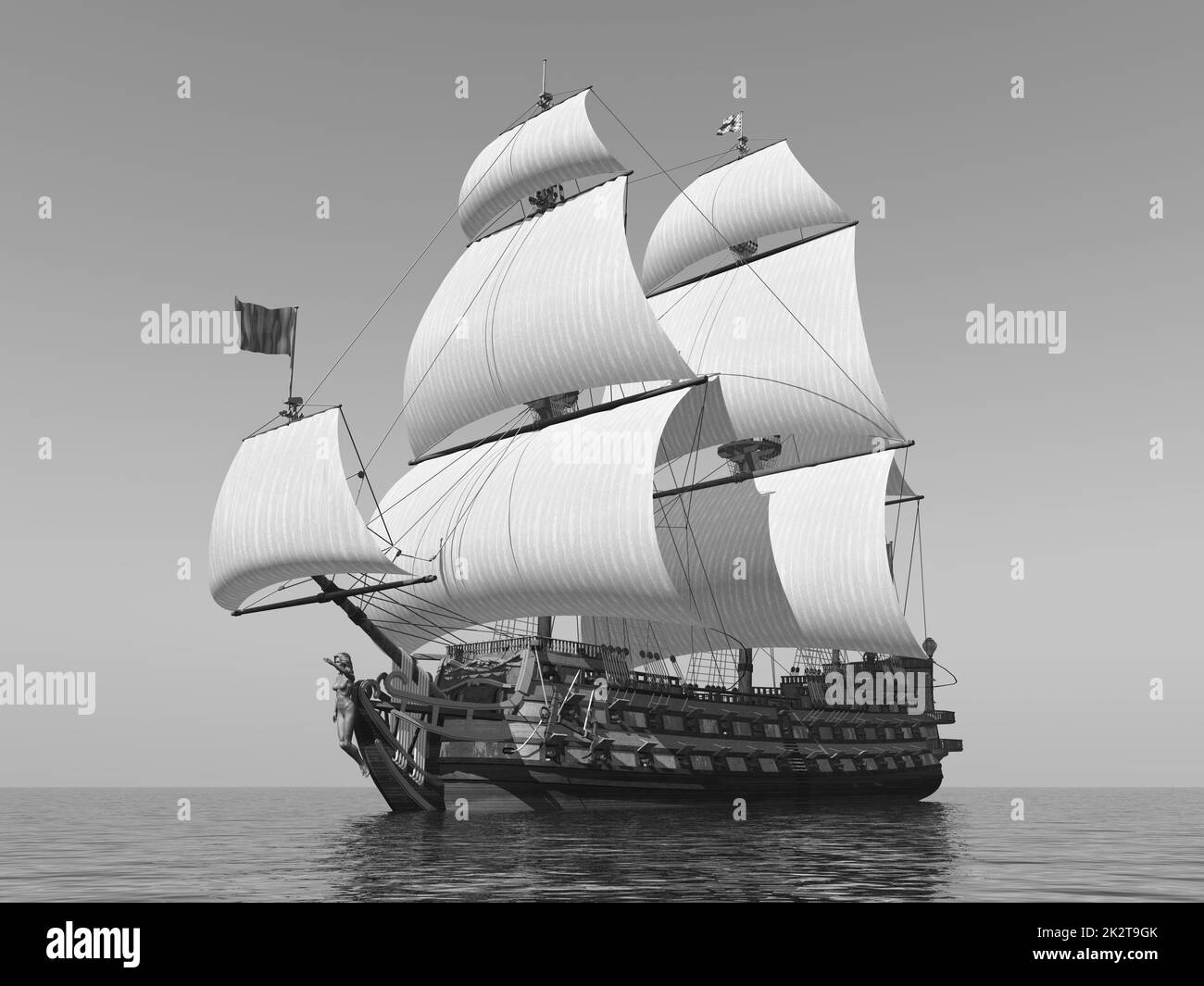 French warship of the 18th century in black and white Stock Photohttps://www.alamy.com/image-license-details/?v=1https://www.alamy.com/french-warship-of-the-18th-century-in-black-and-white-image483653987.html
French warship of the 18th century in black and white Stock Photohttps://www.alamy.com/image-license-details/?v=1https://www.alamy.com/french-warship-of-the-18th-century-in-black-and-white-image483653987.htmlRF2K2T9GK–French warship of the 18th century in black and white
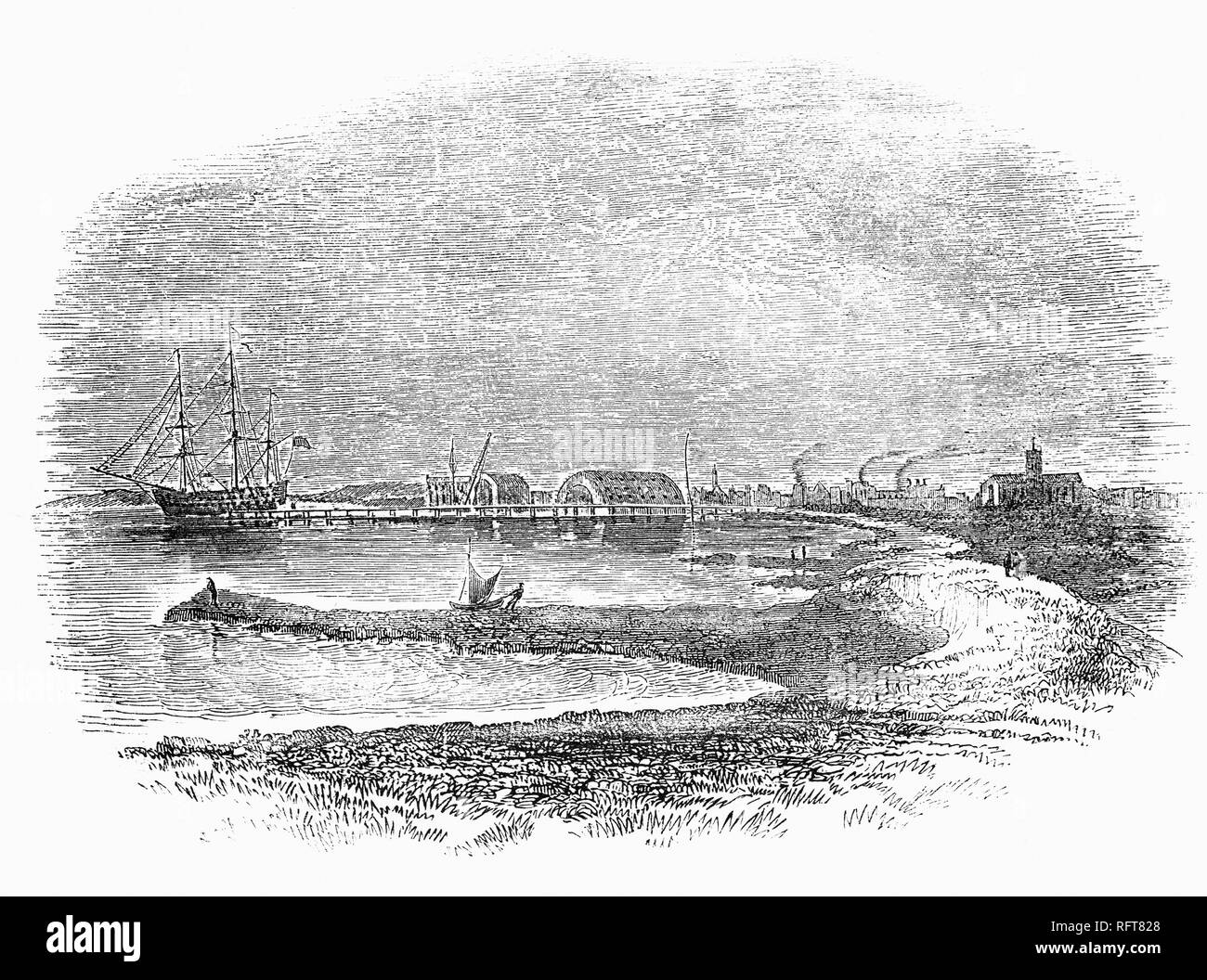 Sheerness Dockyard also known as the Sheerness Station was a Royal Navy Dockyard located on the Sheerness peninsula, at the mouth of the River Medway in Kent opened in the 1660s. It initially functioned as an extension to Chatham and was conceived primarily for the repair and maintenance of naval ships and no shipbuilding took place until 1691. The first dry-dock was completed in 1708; a second was added in 1720 with access through a tidal basin, known as the Mud Dock. The dockyard began to expand and by 1800 had Dockyard filled all available space. Stock Photohttps://www.alamy.com/image-license-details/?v=1https://www.alamy.com/sheerness-dockyard-also-known-as-the-sheerness-station-was-a-royal-navy-dockyard-located-on-the-sheerness-peninsula-at-the-mouth-of-the-river-medway-in-kent-opened-in-the-1660s-it-initially-functioned-as-an-extension-to-chatham-and-was-conceived-primarily-for-the-repair-and-maintenance-of-naval-ships-and-no-shipbuilding-took-place-until-1691-the-first-dry-dock-was-completed-in-1708-a-second-was-added-in-1720-with-access-through-a-tidal-basin-known-as-the-mud-dock-the-dockyard-began-to-expand-and-by-1800-had-dockyard-filled-all-available-space-image233487808.html
Sheerness Dockyard also known as the Sheerness Station was a Royal Navy Dockyard located on the Sheerness peninsula, at the mouth of the River Medway in Kent opened in the 1660s. It initially functioned as an extension to Chatham and was conceived primarily for the repair and maintenance of naval ships and no shipbuilding took place until 1691. The first dry-dock was completed in 1708; a second was added in 1720 with access through a tidal basin, known as the Mud Dock. The dockyard began to expand and by 1800 had Dockyard filled all available space. Stock Photohttps://www.alamy.com/image-license-details/?v=1https://www.alamy.com/sheerness-dockyard-also-known-as-the-sheerness-station-was-a-royal-navy-dockyard-located-on-the-sheerness-peninsula-at-the-mouth-of-the-river-medway-in-kent-opened-in-the-1660s-it-initially-functioned-as-an-extension-to-chatham-and-was-conceived-primarily-for-the-repair-and-maintenance-of-naval-ships-and-no-shipbuilding-took-place-until-1691-the-first-dry-dock-was-completed-in-1708-a-second-was-added-in-1720-with-access-through-a-tidal-basin-known-as-the-mud-dock-the-dockyard-began-to-expand-and-by-1800-had-dockyard-filled-all-available-space-image233487808.htmlRMRFT828–Sheerness Dockyard also known as the Sheerness Station was a Royal Navy Dockyard located on the Sheerness peninsula, at the mouth of the River Medway in Kent opened in the 1660s. It initially functioned as an extension to Chatham and was conceived primarily for the repair and maintenance of naval ships and no shipbuilding took place until 1691. The first dry-dock was completed in 1708; a second was added in 1720 with access through a tidal basin, known as the Mud Dock. The dockyard began to expand and by 1800 had Dockyard filled all available space.
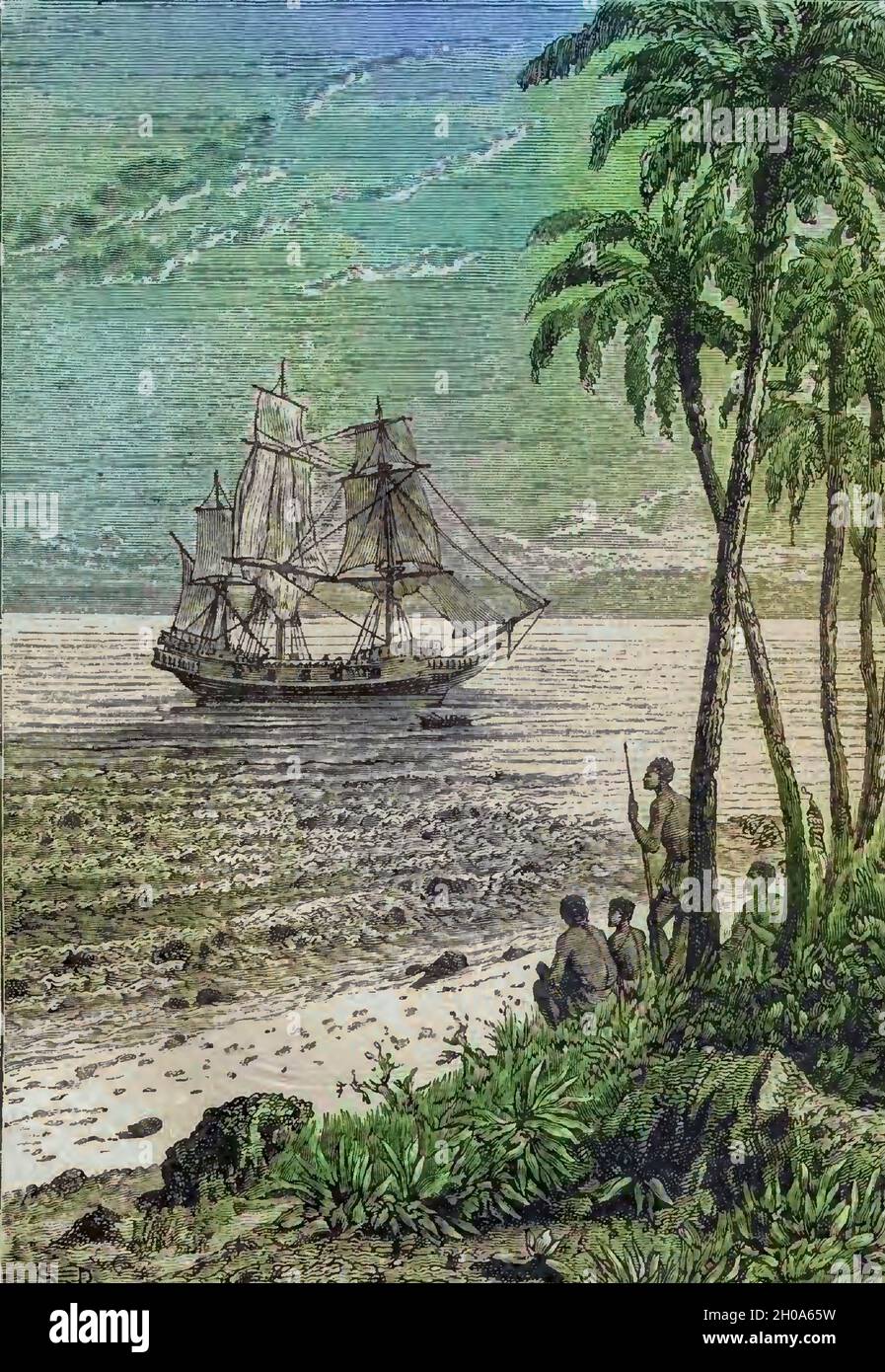 The Bounty Approaching the Shore HMS Bounty, also known as HM Armed Vessel Bounty, was a small merchant vessel that the Royal Navy purchased in 1787 for a botanical mission. The ship was sent to the South Pacific Ocean under the command of William Bligh to acquire breadfruit plants and transport them to the West Indies. That mission was never completed owing to a 1789 mutiny led by acting lieutenant Fletcher Christian, an incident now popularly known as the mutiny on the Bounty. The mutineers later burned Bounty while she was moored at Pitcairn Island. Stock Photohttps://www.alamy.com/image-license-details/?v=1https://www.alamy.com/the-bounty-approaching-the-shore-hms-bounty-also-known-as-hm-armed-vessel-bounty-was-a-small-merchant-vessel-that-the-royal-navy-purchased-in-1787-for-a-botanical-mission-the-ship-was-sent-to-the-south-pacific-ocean-under-the-command-of-william-bligh-to-acquire-breadfruit-plants-and-transport-them-to-the-west-indies-that-mission-was-never-completed-owing-to-a-1789-mutiny-led-by-acting-lieutenant-fletcher-christian-an-incident-now-popularly-known-as-the-mutiny-on-the-bounty-the-mutineers-later-burned-bounty-while-she-was-moored-at-pitcairn-island-image447693957.html
The Bounty Approaching the Shore HMS Bounty, also known as HM Armed Vessel Bounty, was a small merchant vessel that the Royal Navy purchased in 1787 for a botanical mission. The ship was sent to the South Pacific Ocean under the command of William Bligh to acquire breadfruit plants and transport them to the West Indies. That mission was never completed owing to a 1789 mutiny led by acting lieutenant Fletcher Christian, an incident now popularly known as the mutiny on the Bounty. The mutineers later burned Bounty while she was moored at Pitcairn Island. Stock Photohttps://www.alamy.com/image-license-details/?v=1https://www.alamy.com/the-bounty-approaching-the-shore-hms-bounty-also-known-as-hm-armed-vessel-bounty-was-a-small-merchant-vessel-that-the-royal-navy-purchased-in-1787-for-a-botanical-mission-the-ship-was-sent-to-the-south-pacific-ocean-under-the-command-of-william-bligh-to-acquire-breadfruit-plants-and-transport-them-to-the-west-indies-that-mission-was-never-completed-owing-to-a-1789-mutiny-led-by-acting-lieutenant-fletcher-christian-an-incident-now-popularly-known-as-the-mutiny-on-the-bounty-the-mutineers-later-burned-bounty-while-she-was-moored-at-pitcairn-island-image447693957.htmlRF2H0A65W–The Bounty Approaching the Shore HMS Bounty, also known as HM Armed Vessel Bounty, was a small merchant vessel that the Royal Navy purchased in 1787 for a botanical mission. The ship was sent to the South Pacific Ocean under the command of William Bligh to acquire breadfruit plants and transport them to the West Indies. That mission was never completed owing to a 1789 mutiny led by acting lieutenant Fletcher Christian, an incident now popularly known as the mutiny on the Bounty. The mutineers later burned Bounty while she was moored at Pitcairn Island.
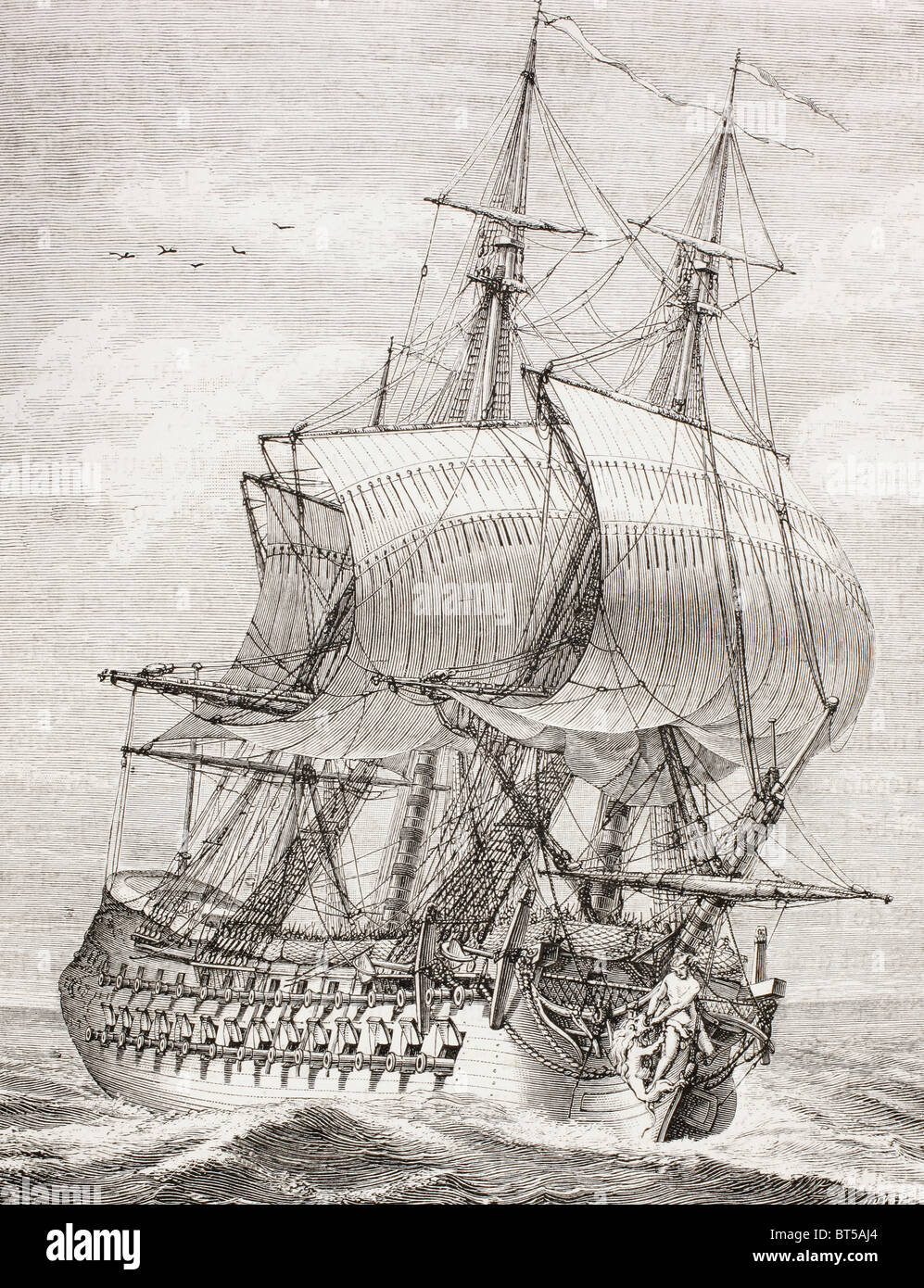 The 58 gun frigate of the French navy with gun ports raised and ready for battle. Stock Photohttps://www.alamy.com/image-license-details/?v=1https://www.alamy.com/stock-photo-the-58-gun-frigate-of-the-french-navy-with-gun-ports-raised-and-ready-32080220.html
The 58 gun frigate of the French navy with gun ports raised and ready for battle. Stock Photohttps://www.alamy.com/image-license-details/?v=1https://www.alamy.com/stock-photo-the-58-gun-frigate-of-the-french-navy-with-gun-ports-raised-and-ready-32080220.htmlRMBT5AJ4–The 58 gun frigate of the French navy with gun ports raised and ready for battle.
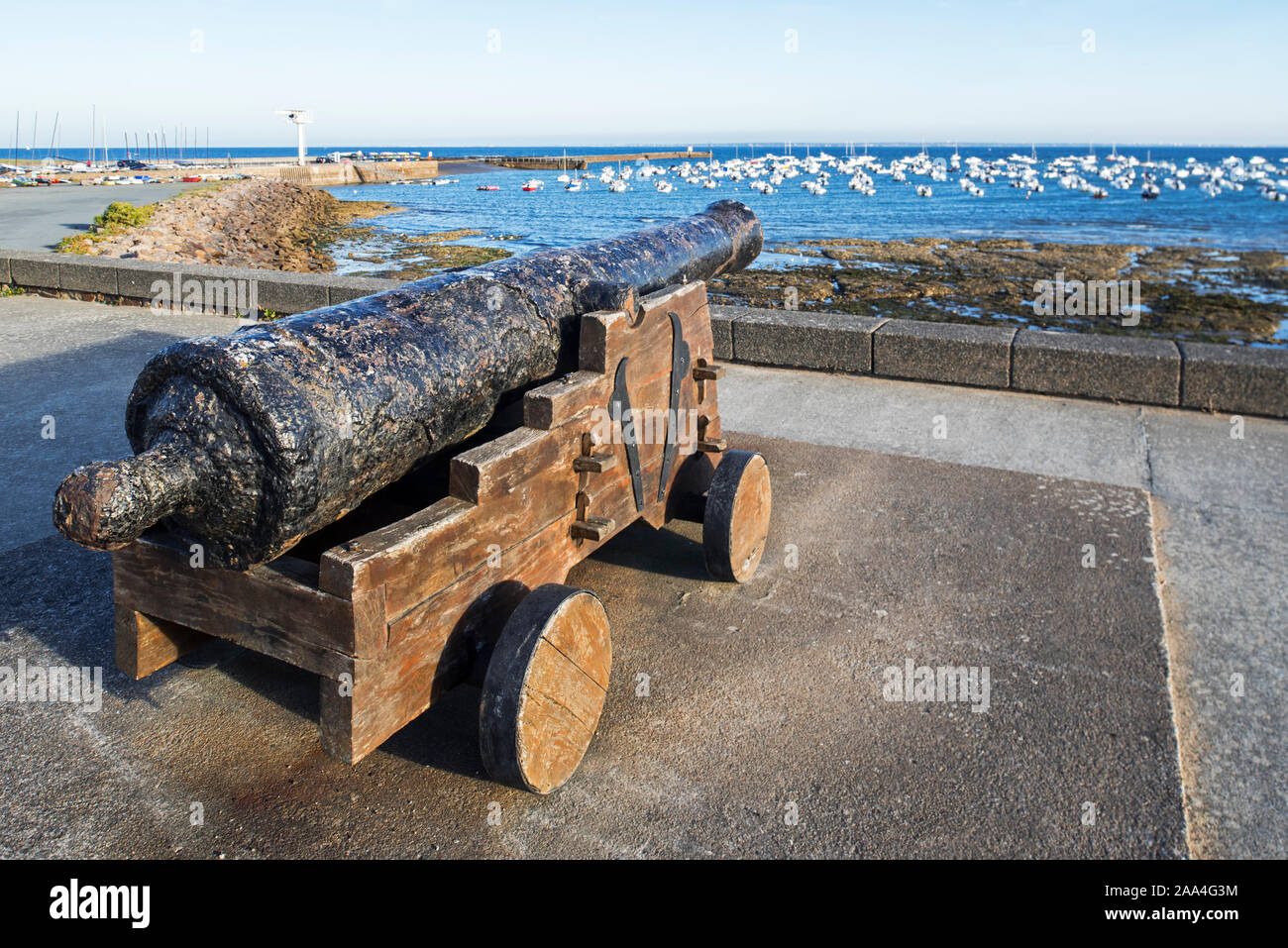 Salvaged 18th century ship's cannon from the Juste, ship of the line of the French Navy at Préfailles, Pointe Saint-Gildas, Loire-Atlantique, France Stock Photohttps://www.alamy.com/image-license-details/?v=1https://www.alamy.com/salvaged-18th-century-ships-cannon-from-the-juste-ship-of-the-line-of-the-french-navy-at-prfailles-pointe-saint-gildas-loire-atlantique-france-image333244008.html
Salvaged 18th century ship's cannon from the Juste, ship of the line of the French Navy at Préfailles, Pointe Saint-Gildas, Loire-Atlantique, France Stock Photohttps://www.alamy.com/image-license-details/?v=1https://www.alamy.com/salvaged-18th-century-ships-cannon-from-the-juste-ship-of-the-line-of-the-french-navy-at-prfailles-pointe-saint-gildas-loire-atlantique-france-image333244008.htmlRM2AA4G3M–Salvaged 18th century ship's cannon from the Juste, ship of the line of the French Navy at Préfailles, Pointe Saint-Gildas, Loire-Atlantique, France
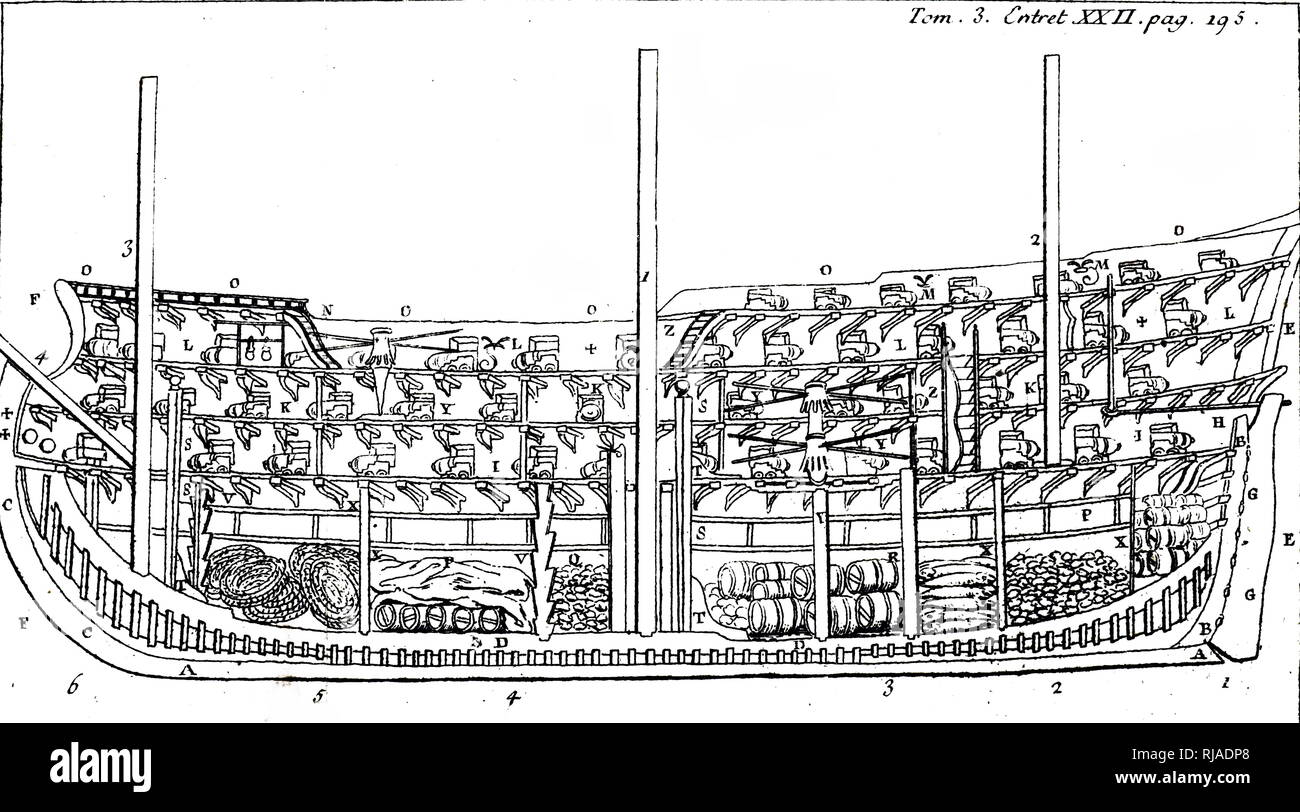 A woodblock engraving depicting a first-rate ship of the line carrying sail. Dated 18th century Stock Photohttps://www.alamy.com/image-license-details/?v=1https://www.alamy.com/a-woodblock-engraving-depicting-a-first-rate-ship-of-the-line-carrying-sail-dated-18th-century-image235028928.html
A woodblock engraving depicting a first-rate ship of the line carrying sail. Dated 18th century Stock Photohttps://www.alamy.com/image-license-details/?v=1https://www.alamy.com/a-woodblock-engraving-depicting-a-first-rate-ship-of-the-line-carrying-sail-dated-18th-century-image235028928.htmlRMRJADP8–A woodblock engraving depicting a first-rate ship of the line carrying sail. Dated 18th century
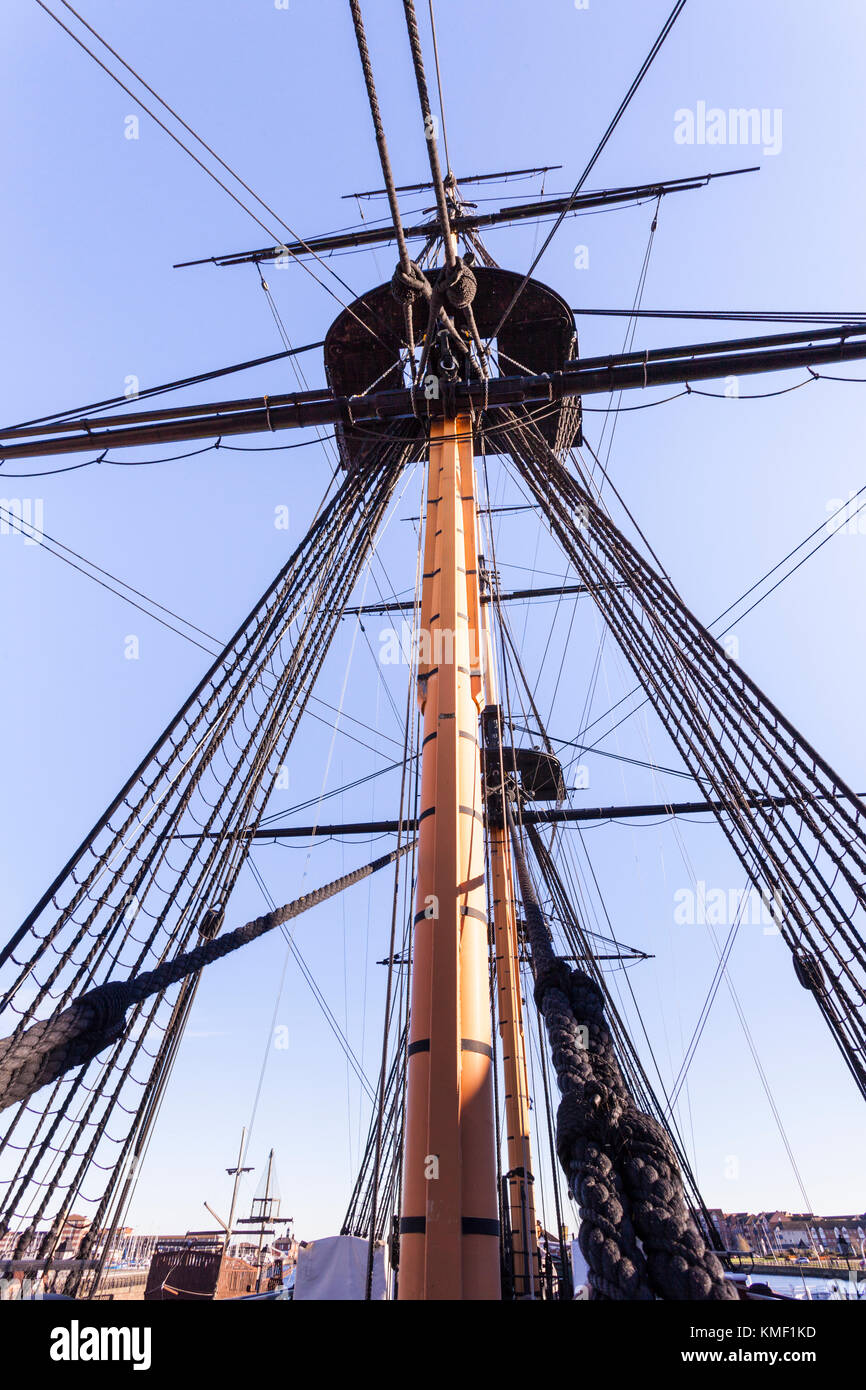 HMS Trincomalee at The National Museum of the Royal Navy, Hartlepool UK Stock Photohttps://www.alamy.com/image-license-details/?v=1https://www.alamy.com/stock-image-hms-trincomalee-at-the-national-museum-of-the-royal-navy-hartlepool-167517041.html
HMS Trincomalee at The National Museum of the Royal Navy, Hartlepool UK Stock Photohttps://www.alamy.com/image-license-details/?v=1https://www.alamy.com/stock-image-hms-trincomalee-at-the-national-museum-of-the-royal-navy-hartlepool-167517041.htmlRMKMF1KD–HMS Trincomalee at The National Museum of the Royal Navy, Hartlepool UK
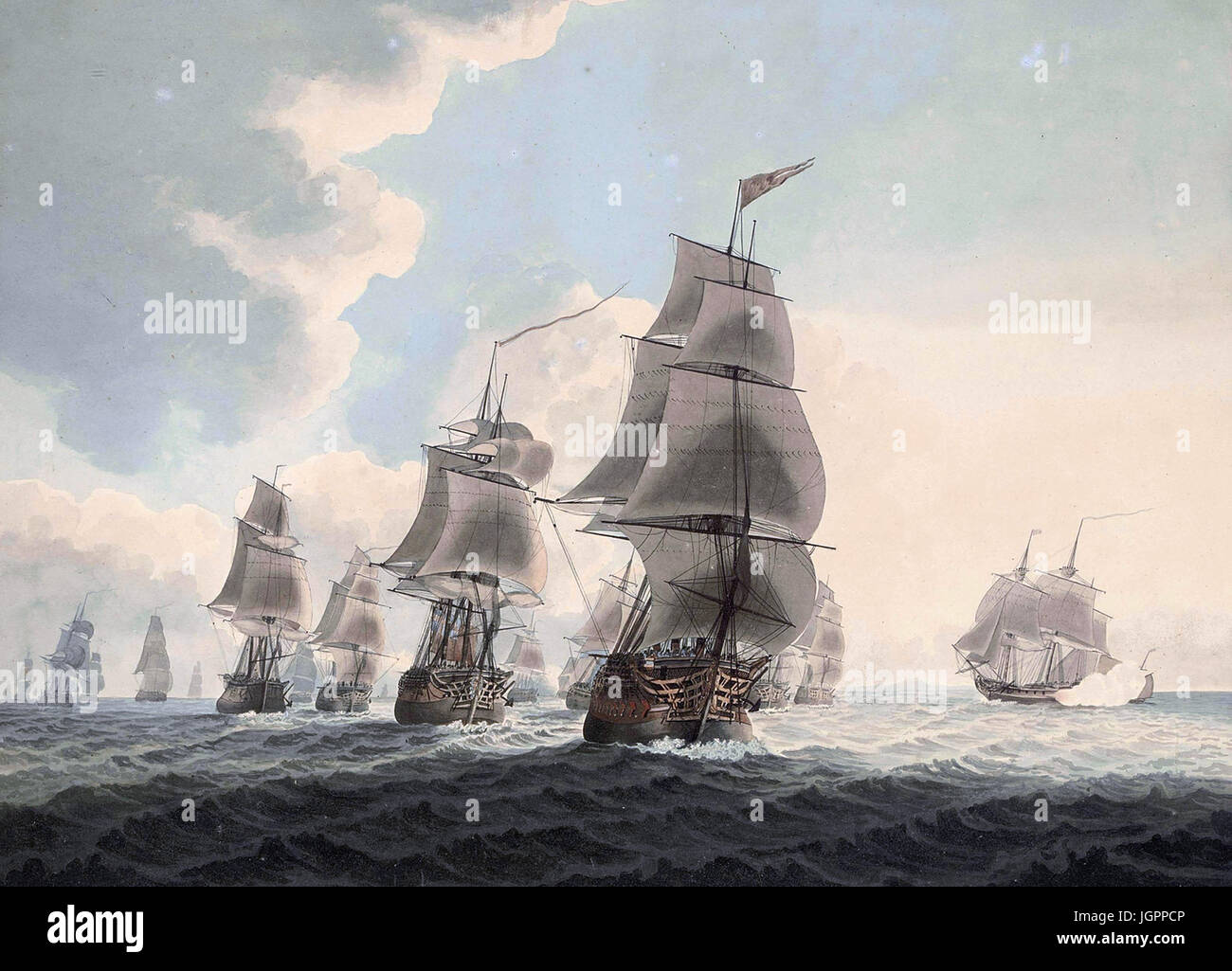 SAMUEL ATKINS (c 1760-1810) English artist. 'A squadron of the Royal Navy running down the Channel and an East Indiaman preparing to sail' Undated oil painting. Stock Photohttps://www.alamy.com/image-license-details/?v=1https://www.alamy.com/stock-photo-samuel-atkins-c-1760-1810-english-artist-a-squadron-of-the-royal-navy-148017990.html
SAMUEL ATKINS (c 1760-1810) English artist. 'A squadron of the Royal Navy running down the Channel and an East Indiaman preparing to sail' Undated oil painting. Stock Photohttps://www.alamy.com/image-license-details/?v=1https://www.alamy.com/stock-photo-samuel-atkins-c-1760-1810-english-artist-a-squadron-of-the-royal-navy-148017990.htmlRMJGPPCP–SAMUEL ATKINS (c 1760-1810) English artist. 'A squadron of the Royal Navy running down the Channel and an East Indiaman preparing to sail' Undated oil painting.
 Post-Captain is an obsolete alternative form of the rank of Captain in the Royal Navy. Stock Photohttps://www.alamy.com/image-license-details/?v=1https://www.alamy.com/stock-photo-post-captain-is-an-obsolete-alternative-form-of-the-rank-of-captain-31400986.html
Post-Captain is an obsolete alternative form of the rank of Captain in the Royal Navy. Stock Photohttps://www.alamy.com/image-license-details/?v=1https://www.alamy.com/stock-photo-post-captain-is-an-obsolete-alternative-form-of-the-rank-of-captain-31400986.htmlRMBR2C7P–Post-Captain is an obsolete alternative form of the rank of Captain in the Royal Navy.
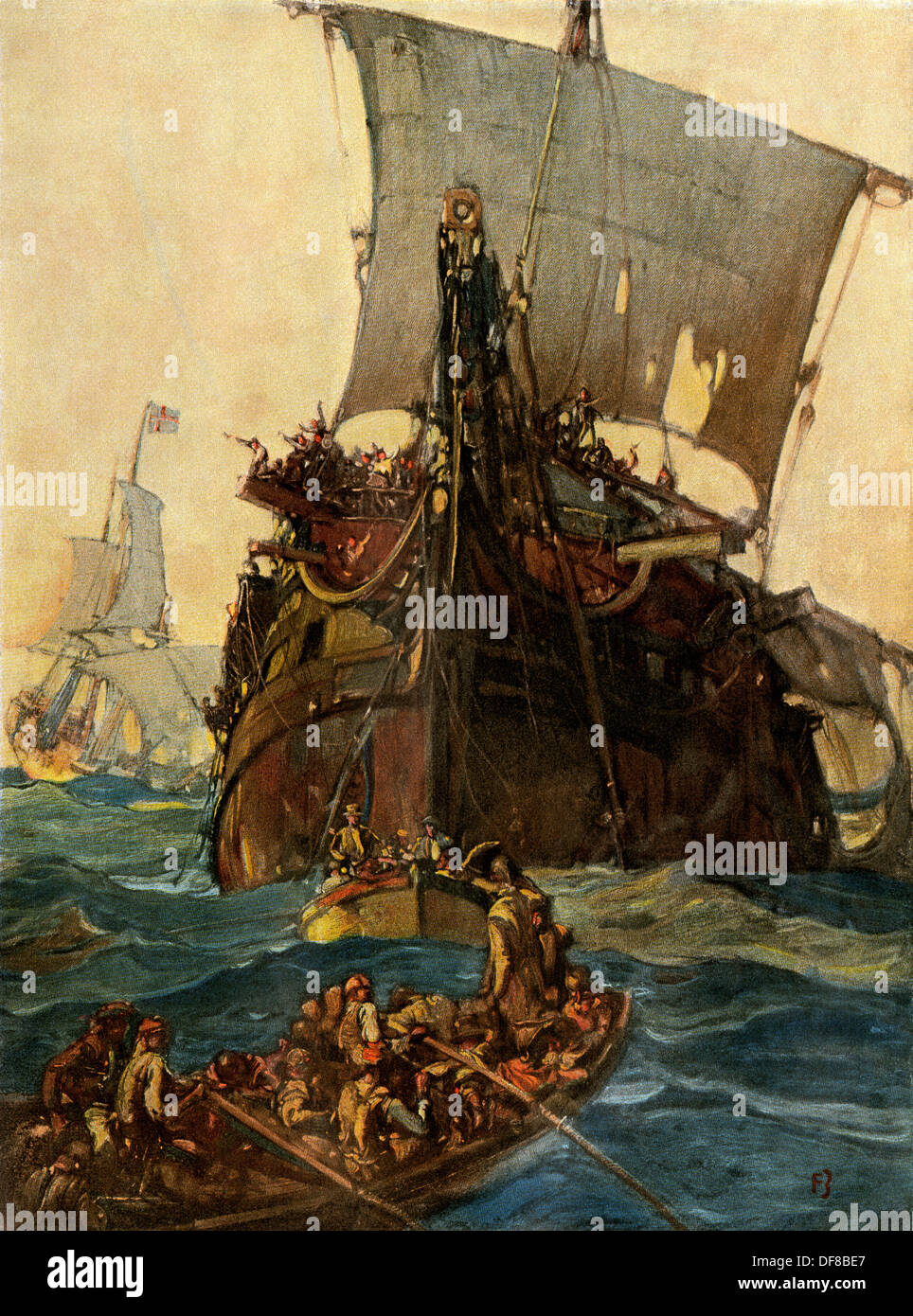 English Navy sinking the French 'Vengeur' off the coast of Brittany, late 1700s. Color halftone of an illustration Stock Photohttps://www.alamy.com/image-license-details/?v=1https://www.alamy.com/english-navy-sinking-the-french-vengeur-off-the-coast-of-brittany-image61035583.html
English Navy sinking the French 'Vengeur' off the coast of Brittany, late 1700s. Color halftone of an illustration Stock Photohttps://www.alamy.com/image-license-details/?v=1https://www.alamy.com/english-navy-sinking-the-french-vengeur-off-the-coast-of-brittany-image61035583.htmlRMDF8BE7–English Navy sinking the French 'Vengeur' off the coast of Brittany, late 1700s. Color halftone of an illustration
 Philip James de Loutherbourg French school The Battle of the Nile 1800 Oil on canvas (152 x 214 cm) London, Tate Modern Stock Photohttps://www.alamy.com/image-license-details/?v=1https://www.alamy.com/philip-james-de-loutherbourg-french-school-the-battle-of-the-nile-1800-oil-on-canvas-152-x-214-cm-london-tate-modern-image483534949.html
Philip James de Loutherbourg French school The Battle of the Nile 1800 Oil on canvas (152 x 214 cm) London, Tate Modern Stock Photohttps://www.alamy.com/image-license-details/?v=1https://www.alamy.com/philip-james-de-loutherbourg-french-school-the-battle-of-the-nile-1800-oil-on-canvas-152-x-214-cm-london-tate-modern-image483534949.htmlRM2K2JWN9–Philip James de Loutherbourg French school The Battle of the Nile 1800 Oil on canvas (152 x 214 cm) London, Tate Modern
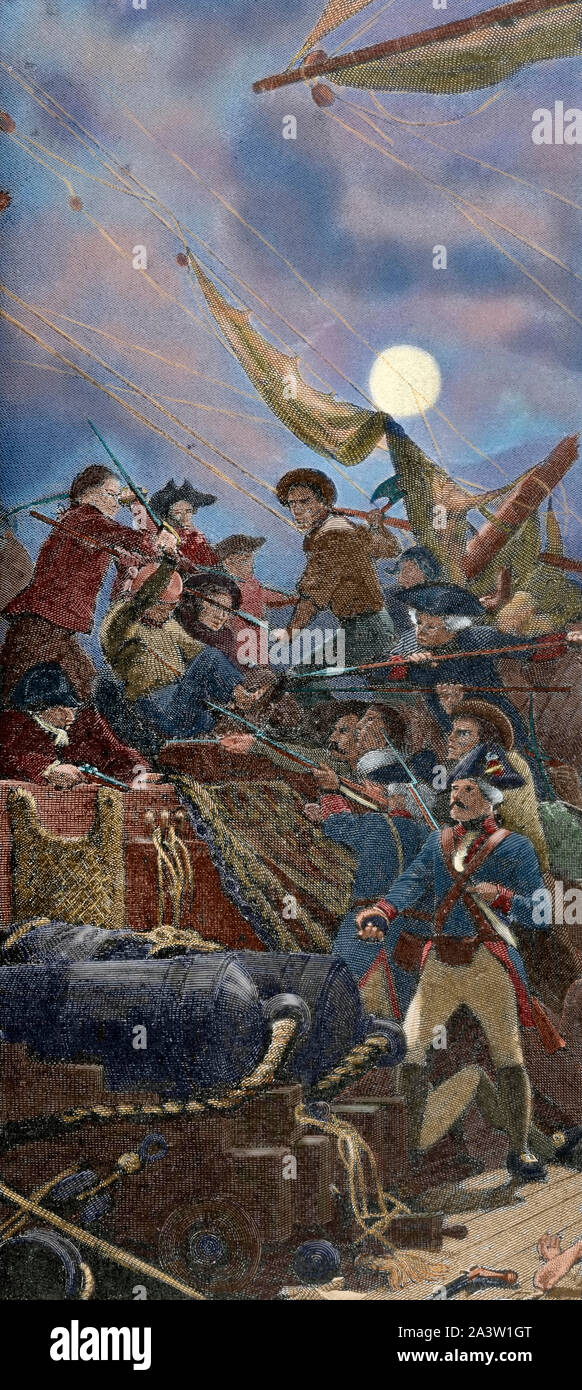 American Revolutionary War (1775-1783). John Paul Jones (1747-1792) captures the British ship Serapis on September 23, 1779. American Revolution. 19th century. Later colouration. Stock Photohttps://www.alamy.com/image-license-details/?v=1https://www.alamy.com/american-revolutionary-war-1775-1783-john-paul-jones-1747-1792-captures-the-british-ship-serapis-on-september-23-1779-american-revolution-19th-century-later-colouration-image329391016.html
American Revolutionary War (1775-1783). John Paul Jones (1747-1792) captures the British ship Serapis on September 23, 1779. American Revolution. 19th century. Later colouration. Stock Photohttps://www.alamy.com/image-license-details/?v=1https://www.alamy.com/american-revolutionary-war-1775-1783-john-paul-jones-1747-1792-captures-the-british-ship-serapis-on-september-23-1779-american-revolution-19th-century-later-colouration-image329391016.htmlRM2A3W1GT–American Revolutionary War (1775-1783). John Paul Jones (1747-1792) captures the British ship Serapis on September 23, 1779. American Revolution. 19th century. Later colouration.
 18th century. Scene after a naval battle. Maintenance and cleaning work. Engraving, 19th century. Stock Photohttps://www.alamy.com/image-license-details/?v=1https://www.alamy.com/18th-century-scene-after-a-naval-battle-maintenance-and-cleaning-work-engraving-19th-century-image614382793.html
18th century. Scene after a naval battle. Maintenance and cleaning work. Engraving, 19th century. Stock Photohttps://www.alamy.com/image-license-details/?v=1https://www.alamy.com/18th-century-scene-after-a-naval-battle-maintenance-and-cleaning-work-engraving-19th-century-image614382793.htmlRM2XKFFEH–18th century. Scene after a naval battle. Maintenance and cleaning work. Engraving, 19th century.
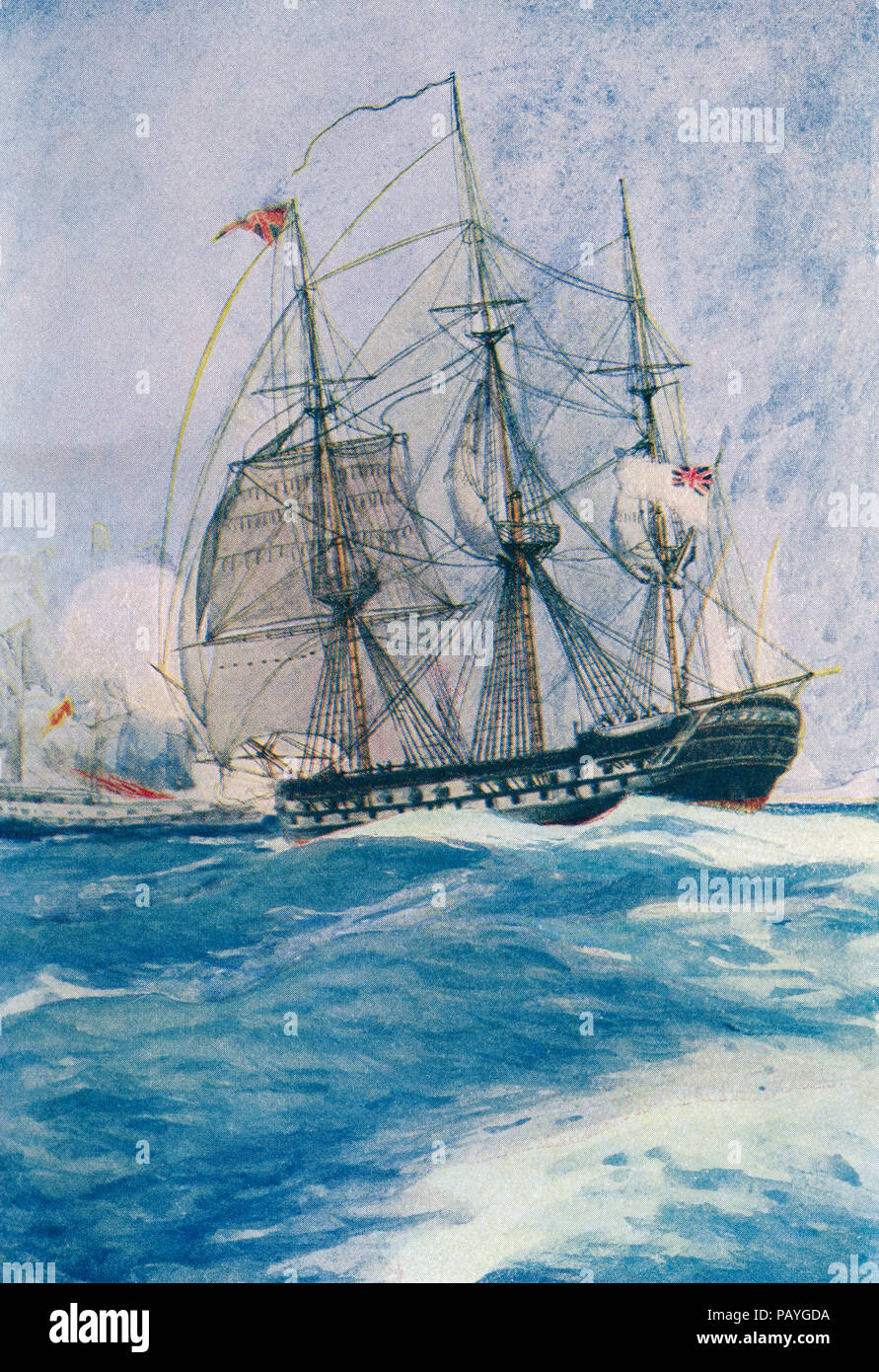 A Man-o-War in Nelson's day. From The Book of Ships, published c.1920. Stock Photohttps://www.alamy.com/image-license-details/?v=1https://www.alamy.com/a-man-o-war-in-nelsons-day-from-the-book-of-ships-published-c1920-image213276598.html
A Man-o-War in Nelson's day. From The Book of Ships, published c.1920. Stock Photohttps://www.alamy.com/image-license-details/?v=1https://www.alamy.com/a-man-o-war-in-nelsons-day-from-the-book-of-ships-published-c1920-image213276598.htmlRMPAYGDA–A Man-o-War in Nelson's day. From The Book of Ships, published c.1920.
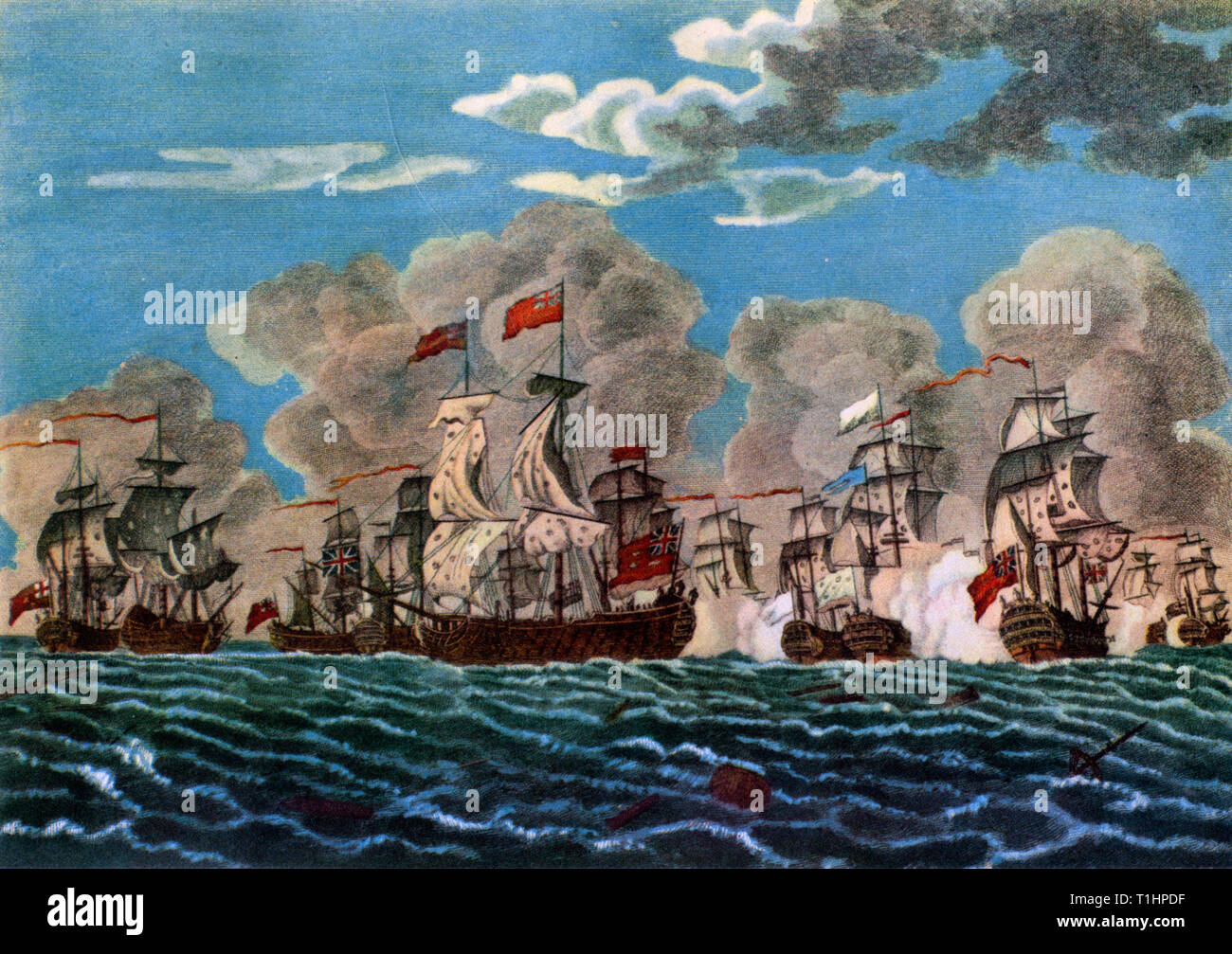 'The Action off Lagos, 18th August, 1759', 1781. A battle during the Seven Years War. After Francis Swaine (1725-1782). The naval Battle of Lagos between Britain and France took place over the 18th and 19th August 1759, during the Seven Years' War. The battle took place off the coasts of Spain and Portugal, and is named after Lagos, Portugal. For the British, it was part of the Annus Mirabilis of 1759. A coloured engraving published by Macgowan & Davis. Stock Photohttps://www.alamy.com/image-license-details/?v=1https://www.alamy.com/the-action-off-lagos-18th-august-1759-1781-a-battle-during-the-seven-years-war-after-francis-swaine-1725-1782-the-naval-battle-of-lagos-between-britain-and-france-took-place-over-the-18th-and-19th-august-1759-during-the-seven-years-war-the-battle-took-place-off-the-coasts-of-spain-and-portugal-and-is-named-after-lagos-portugal-for-the-british-it-was-part-of-the-annus-mirabilis-of-1759-a-coloured-engraving-published-by-macgowan-davis-image241950619.html
'The Action off Lagos, 18th August, 1759', 1781. A battle during the Seven Years War. After Francis Swaine (1725-1782). The naval Battle of Lagos between Britain and France took place over the 18th and 19th August 1759, during the Seven Years' War. The battle took place off the coasts of Spain and Portugal, and is named after Lagos, Portugal. For the British, it was part of the Annus Mirabilis of 1759. A coloured engraving published by Macgowan & Davis. Stock Photohttps://www.alamy.com/image-license-details/?v=1https://www.alamy.com/the-action-off-lagos-18th-august-1759-1781-a-battle-during-the-seven-years-war-after-francis-swaine-1725-1782-the-naval-battle-of-lagos-between-britain-and-france-took-place-over-the-18th-and-19th-august-1759-during-the-seven-years-war-the-battle-took-place-off-the-coasts-of-spain-and-portugal-and-is-named-after-lagos-portugal-for-the-british-it-was-part-of-the-annus-mirabilis-of-1759-a-coloured-engraving-published-by-macgowan-davis-image241950619.htmlRMT1HPDF–'The Action off Lagos, 18th August, 1759', 1781. A battle during the Seven Years War. After Francis Swaine (1725-1782). The naval Battle of Lagos between Britain and France took place over the 18th and 19th August 1759, during the Seven Years' War. The battle took place off the coasts of Spain and Portugal, and is named after Lagos, Portugal. For the British, it was part of the Annus Mirabilis of 1759. A coloured engraving published by Macgowan & Davis.
 'The Naval Battle of Chesma on 5 July 1770', 18th century. Artist: Jacob Philip Hackert Stock Photohttps://www.alamy.com/image-license-details/?v=1https://www.alamy.com/the-naval-battle-of-chesma-on-5-july-1770-18th-century-artist-jacob-image60250809.html
'The Naval Battle of Chesma on 5 July 1770', 18th century. Artist: Jacob Philip Hackert Stock Photohttps://www.alamy.com/image-license-details/?v=1https://www.alamy.com/the-naval-battle-of-chesma-on-5-july-1770-18th-century-artist-jacob-image60250809.htmlRMDE0JEH–'The Naval Battle of Chesma on 5 July 1770', 18th century. Artist: Jacob Philip Hackert
 The HMS Victory. 1778 Stock Photohttps://www.alamy.com/image-license-details/?v=1https://www.alamy.com/stock-photo-the-hms-victory-1778-50035326.html
The HMS Victory. 1778 Stock Photohttps://www.alamy.com/image-license-details/?v=1https://www.alamy.com/stock-photo-the-hms-victory-1778-50035326.htmlRMCWB8FX–The HMS Victory. 1778
![Irving apparatus for distillation from the book ' A voyage towards the North Pole : undertaken by His Majesty's command, 1773 ' by Constantine John Phipps, Baron Mulgrave, 1744-1792; The 1773 Phipps expedition towards the North Pole was a British Royal Navy expedition in which two ships under the commands of Constantine John Phipps as Captain of the HMS Racehorse [an 18-gun ship-rigged sloop of the Royal Navy.] and Skeffington Lutwidge as Captain of the HMS Carcass [a bomb vessel of the Royal Navy], sailed towards the North Pole in the summer of 1773 and became stuck in ice near Svalbard. A y Stock Photo Irving apparatus for distillation from the book ' A voyage towards the North Pole : undertaken by His Majesty's command, 1773 ' by Constantine John Phipps, Baron Mulgrave, 1744-1792; The 1773 Phipps expedition towards the North Pole was a British Royal Navy expedition in which two ships under the commands of Constantine John Phipps as Captain of the HMS Racehorse [an 18-gun ship-rigged sloop of the Royal Navy.] and Skeffington Lutwidge as Captain of the HMS Carcass [a bomb vessel of the Royal Navy], sailed towards the North Pole in the summer of 1773 and became stuck in ice near Svalbard. A y Stock Photo](https://c8.alamy.com/comp/2GB5CE8/irving-apparatus-for-distillation-from-the-book-a-voyage-towards-the-north-pole-undertaken-by-his-majestys-command-1773-by-constantine-john-phipps-baron-mulgrave-1744-1792-the-1773-phipps-expedition-towards-the-north-pole-was-a-british-royal-navy-expedition-in-which-two-ships-under-the-commands-of-constantine-john-phipps-as-captain-of-the-hms-racehorse-an-18-gun-ship-rigged-sloop-of-the-royal-navy-and-skeffington-lutwidge-as-captain-of-the-hms-carcass-a-bomb-vessel-of-the-royal-navy-sailed-towards-the-north-pole-in-the-summer-of-1773-and-became-stuck-in-ice-near-svalbard-a-y-2GB5CE8.jpg) Irving apparatus for distillation from the book ' A voyage towards the North Pole : undertaken by His Majesty's command, 1773 ' by Constantine John Phipps, Baron Mulgrave, 1744-1792; The 1773 Phipps expedition towards the North Pole was a British Royal Navy expedition in which two ships under the commands of Constantine John Phipps as Captain of the HMS Racehorse [an 18-gun ship-rigged sloop of the Royal Navy.] and Skeffington Lutwidge as Captain of the HMS Carcass [a bomb vessel of the Royal Navy], sailed towards the North Pole in the summer of 1773 and became stuck in ice near Svalbard. A y Stock Photohttps://www.alamy.com/image-license-details/?v=1https://www.alamy.com/irving-apparatus-for-distillation-from-the-book-a-voyage-towards-the-north-pole-undertaken-by-his-majestys-command-1773-by-constantine-john-phipps-baron-mulgrave-1744-1792-the-1773-phipps-expedition-towards-the-north-pole-was-a-british-royal-navy-expedition-in-which-two-ships-under-the-commands-of-constantine-john-phipps-as-captain-of-the-hms-racehorse-an-18-gun-ship-rigged-sloop-of-the-royal-navy-and-skeffington-lutwidge-as-captain-of-the-hms-carcass-a-bomb-vessel-of-the-royal-navy-sailed-towards-the-north-pole-in-the-summer-of-1773-and-became-stuck-in-ice-near-svalbard-a-y-image437139984.html
Irving apparatus for distillation from the book ' A voyage towards the North Pole : undertaken by His Majesty's command, 1773 ' by Constantine John Phipps, Baron Mulgrave, 1744-1792; The 1773 Phipps expedition towards the North Pole was a British Royal Navy expedition in which two ships under the commands of Constantine John Phipps as Captain of the HMS Racehorse [an 18-gun ship-rigged sloop of the Royal Navy.] and Skeffington Lutwidge as Captain of the HMS Carcass [a bomb vessel of the Royal Navy], sailed towards the North Pole in the summer of 1773 and became stuck in ice near Svalbard. A y Stock Photohttps://www.alamy.com/image-license-details/?v=1https://www.alamy.com/irving-apparatus-for-distillation-from-the-book-a-voyage-towards-the-north-pole-undertaken-by-his-majestys-command-1773-by-constantine-john-phipps-baron-mulgrave-1744-1792-the-1773-phipps-expedition-towards-the-north-pole-was-a-british-royal-navy-expedition-in-which-two-ships-under-the-commands-of-constantine-john-phipps-as-captain-of-the-hms-racehorse-an-18-gun-ship-rigged-sloop-of-the-royal-navy-and-skeffington-lutwidge-as-captain-of-the-hms-carcass-a-bomb-vessel-of-the-royal-navy-sailed-towards-the-north-pole-in-the-summer-of-1773-and-became-stuck-in-ice-near-svalbard-a-y-image437139984.htmlRM2GB5CE8–Irving apparatus for distillation from the book ' A voyage towards the North Pole : undertaken by His Majesty's command, 1773 ' by Constantine John Phipps, Baron Mulgrave, 1744-1792; The 1773 Phipps expedition towards the North Pole was a British Royal Navy expedition in which two ships under the commands of Constantine John Phipps as Captain of the HMS Racehorse [an 18-gun ship-rigged sloop of the Royal Navy.] and Skeffington Lutwidge as Captain of the HMS Carcass [a bomb vessel of the Royal Navy], sailed towards the North Pole in the summer of 1773 and became stuck in ice near Svalbard. A y
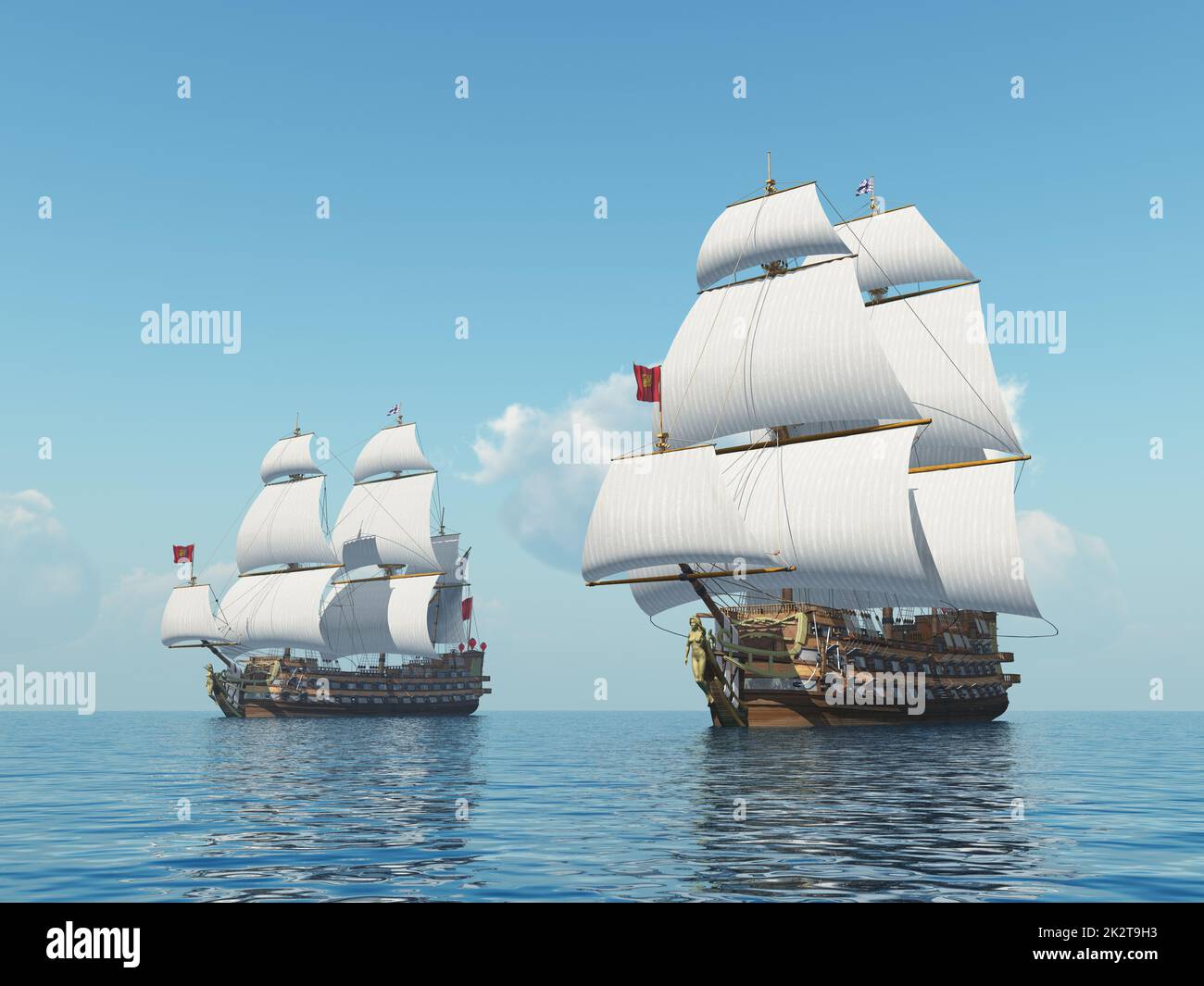 French warships of the 18th century Stock Photohttps://www.alamy.com/image-license-details/?v=1https://www.alamy.com/french-warships-of-the-18th-century-image483653999.html
French warships of the 18th century Stock Photohttps://www.alamy.com/image-license-details/?v=1https://www.alamy.com/french-warships-of-the-18th-century-image483653999.htmlRF2K2T9H3–French warships of the 18th century
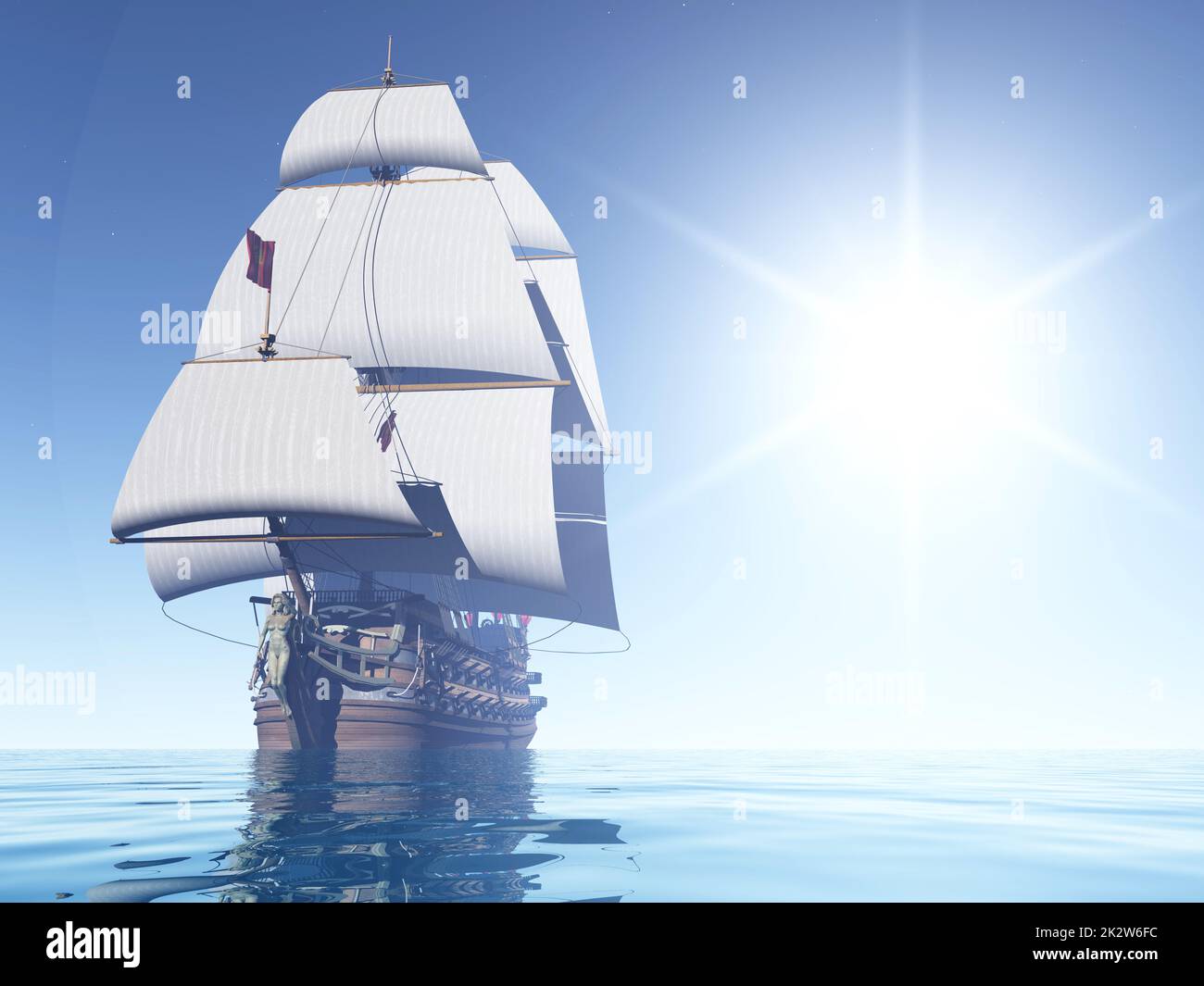 18th century French warship and glaring sun in the morning mist Stock Photohttps://www.alamy.com/image-license-details/?v=1https://www.alamy.com/18th-century-french-warship-and-glaring-sun-in-the-morning-mist-image483673552.html
18th century French warship and glaring sun in the morning mist Stock Photohttps://www.alamy.com/image-license-details/?v=1https://www.alamy.com/18th-century-french-warship-and-glaring-sun-in-the-morning-mist-image483673552.htmlRF2K2W6FC–18th century French warship and glaring sun in the morning mist
 A monochrome illustration of the Spanish ship of the line, 'San Hermenegildo', a 112 cannon vessel launched in Havana, Cuba in 1789. During the Battle of Algeciras Bay in July 1801, the vessel was destroyed when the 'Superb' a British ship fired and struck the San Hermenegildo. Another Spanish ship, the Real Carlos caught fire and the two Spanish ships confused one another for British ships and began a furious duel until a sudden gust of wind brought the two ships together and entangled their rigging. The Hermenegildo also caught fire and the two ships exploded. Stock Photohttps://www.alamy.com/image-license-details/?v=1https://www.alamy.com/a-monochrome-illustration-of-the-spanish-ship-of-the-line-san-hermenegildo-a-112-cannon-vessel-launched-in-havana-cuba-in-1789-during-the-battle-of-algeciras-bay-in-july-1801-the-vessel-was-destroyed-when-the-superb-a-british-ship-fired-and-struck-the-san-hermenegildo-another-spanish-ship-the-real-carlos-caught-fire-and-the-two-spanish-ships-confused-one-another-for-british-ships-and-began-a-furious-duel-until-a-sudden-gust-of-wind-brought-the-two-ships-together-and-entangled-their-rigging-the-hermenegildo-also-caught-fire-and-the-two-ships-exploded-image457679726.html
A monochrome illustration of the Spanish ship of the line, 'San Hermenegildo', a 112 cannon vessel launched in Havana, Cuba in 1789. During the Battle of Algeciras Bay in July 1801, the vessel was destroyed when the 'Superb' a British ship fired and struck the San Hermenegildo. Another Spanish ship, the Real Carlos caught fire and the two Spanish ships confused one another for British ships and began a furious duel until a sudden gust of wind brought the two ships together and entangled their rigging. The Hermenegildo also caught fire and the two ships exploded. Stock Photohttps://www.alamy.com/image-license-details/?v=1https://www.alamy.com/a-monochrome-illustration-of-the-spanish-ship-of-the-line-san-hermenegildo-a-112-cannon-vessel-launched-in-havana-cuba-in-1789-during-the-battle-of-algeciras-bay-in-july-1801-the-vessel-was-destroyed-when-the-superb-a-british-ship-fired-and-struck-the-san-hermenegildo-another-spanish-ship-the-real-carlos-caught-fire-and-the-two-spanish-ships-confused-one-another-for-british-ships-and-began-a-furious-duel-until-a-sudden-gust-of-wind-brought-the-two-ships-together-and-entangled-their-rigging-the-hermenegildo-also-caught-fire-and-the-two-ships-exploded-image457679726.htmlRM2HGH34E–A monochrome illustration of the Spanish ship of the line, 'San Hermenegildo', a 112 cannon vessel launched in Havana, Cuba in 1789. During the Battle of Algeciras Bay in July 1801, the vessel was destroyed when the 'Superb' a British ship fired and struck the San Hermenegildo. Another Spanish ship, the Real Carlos caught fire and the two Spanish ships confused one another for British ships and began a furious duel until a sudden gust of wind brought the two ships together and entangled their rigging. The Hermenegildo also caught fire and the two ships exploded.
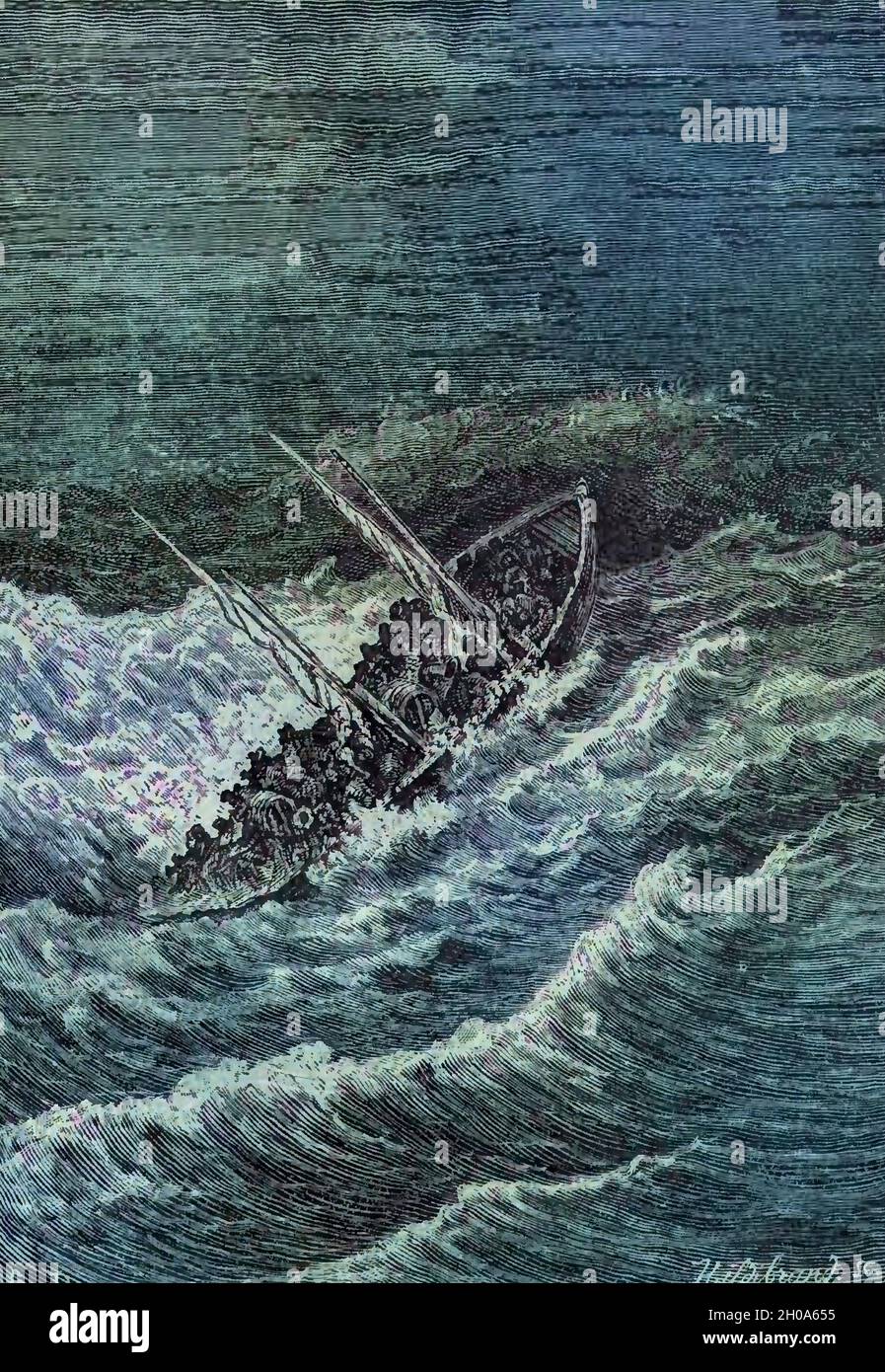 Bligh's Perilous Voyage HMS Bounty, also known as HM Armed Vessel Bounty, was a small merchant vessel that the Royal Navy purchased in 1787 for a botanical mission. The ship was sent to the South Pacific Ocean under the command of William Bligh to acquire breadfruit plants and transport them to the West Indies. That mission was never completed owing to a 1789 mutiny led by acting lieutenant Fletcher Christian, an incident now popularly known as the mutiny on the Bounty. The mutineers later burned Bounty while she was moored at Pitcairn Island. Stock Photohttps://www.alamy.com/image-license-details/?v=1https://www.alamy.com/blighs-perilous-voyage-hms-bounty-also-known-as-hm-armed-vessel-bounty-was-a-small-merchant-vessel-that-the-royal-navy-purchased-in-1787-for-a-botanical-mission-the-ship-was-sent-to-the-south-pacific-ocean-under-the-command-of-william-bligh-to-acquire-breadfruit-plants-and-transport-them-to-the-west-indies-that-mission-was-never-completed-owing-to-a-1789-mutiny-led-by-acting-lieutenant-fletcher-christian-an-incident-now-popularly-known-as-the-mutiny-on-the-bounty-the-mutineers-later-burned-bounty-while-she-was-moored-at-pitcairn-island-image447693937.html
Bligh's Perilous Voyage HMS Bounty, also known as HM Armed Vessel Bounty, was a small merchant vessel that the Royal Navy purchased in 1787 for a botanical mission. The ship was sent to the South Pacific Ocean under the command of William Bligh to acquire breadfruit plants and transport them to the West Indies. That mission was never completed owing to a 1789 mutiny led by acting lieutenant Fletcher Christian, an incident now popularly known as the mutiny on the Bounty. The mutineers later burned Bounty while she was moored at Pitcairn Island. Stock Photohttps://www.alamy.com/image-license-details/?v=1https://www.alamy.com/blighs-perilous-voyage-hms-bounty-also-known-as-hm-armed-vessel-bounty-was-a-small-merchant-vessel-that-the-royal-navy-purchased-in-1787-for-a-botanical-mission-the-ship-was-sent-to-the-south-pacific-ocean-under-the-command-of-william-bligh-to-acquire-breadfruit-plants-and-transport-them-to-the-west-indies-that-mission-was-never-completed-owing-to-a-1789-mutiny-led-by-acting-lieutenant-fletcher-christian-an-incident-now-popularly-known-as-the-mutiny-on-the-bounty-the-mutineers-later-burned-bounty-while-she-was-moored-at-pitcairn-island-image447693937.htmlRF2H0A655–Bligh's Perilous Voyage HMS Bounty, also known as HM Armed Vessel Bounty, was a small merchant vessel that the Royal Navy purchased in 1787 for a botanical mission. The ship was sent to the South Pacific Ocean under the command of William Bligh to acquire breadfruit plants and transport them to the West Indies. That mission was never completed owing to a 1789 mutiny led by acting lieutenant Fletcher Christian, an incident now popularly known as the mutiny on the Bounty. The mutineers later burned Bounty while she was moored at Pitcairn Island.
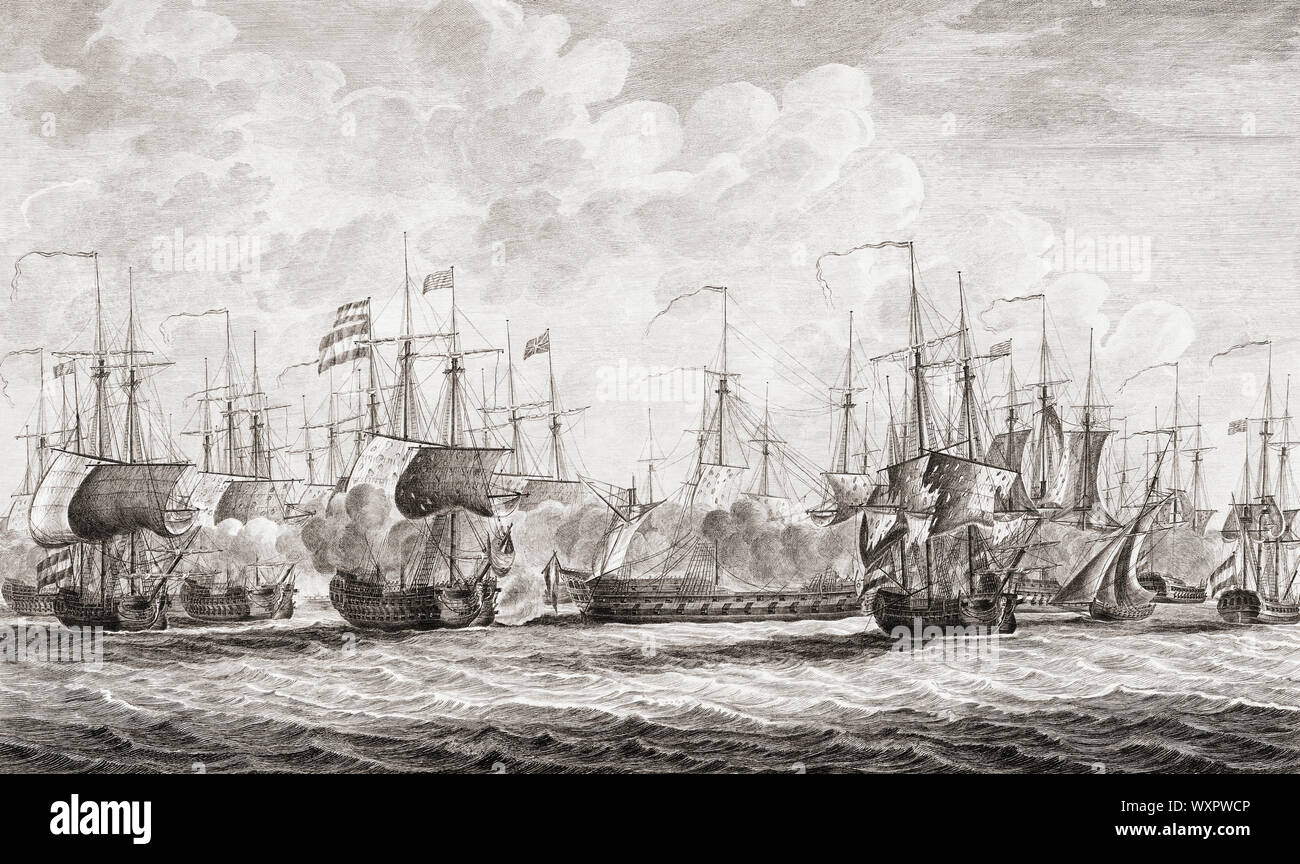 The Battle of Dogger Bank, 1781, between navies of the Dutch Republic and Great Britain during the Fourth Anglo-Dutch War. Stock Photohttps://www.alamy.com/image-license-details/?v=1https://www.alamy.com/the-battle-of-dogger-bank-1781-between-navies-of-the-dutch-republic-and-great-britain-during-the-fourth-anglo-dutch-war-image274639478.html
The Battle of Dogger Bank, 1781, between navies of the Dutch Republic and Great Britain during the Fourth Anglo-Dutch War. Stock Photohttps://www.alamy.com/image-license-details/?v=1https://www.alamy.com/the-battle-of-dogger-bank-1781-between-navies-of-the-dutch-republic-and-great-britain-during-the-fourth-anglo-dutch-war-image274639478.htmlRMWXPWCP–The Battle of Dogger Bank, 1781, between navies of the Dutch Republic and Great Britain during the Fourth Anglo-Dutch War.
 'The Death of Captain Faulkner', 18th century(?). Artist: Grainger Stock Photohttps://www.alamy.com/image-license-details/?v=1https://www.alamy.com/the-death-of-captain-faulkner-18th-century-artist-grainger-image262766841.html
'The Death of Captain Faulkner', 18th century(?). Artist: Grainger Stock Photohttps://www.alamy.com/image-license-details/?v=1https://www.alamy.com/the-death-of-captain-faulkner-18th-century-artist-grainger-image262766841.htmlRMW7E1P1–'The Death of Captain Faulkner', 18th century(?). Artist: Grainger
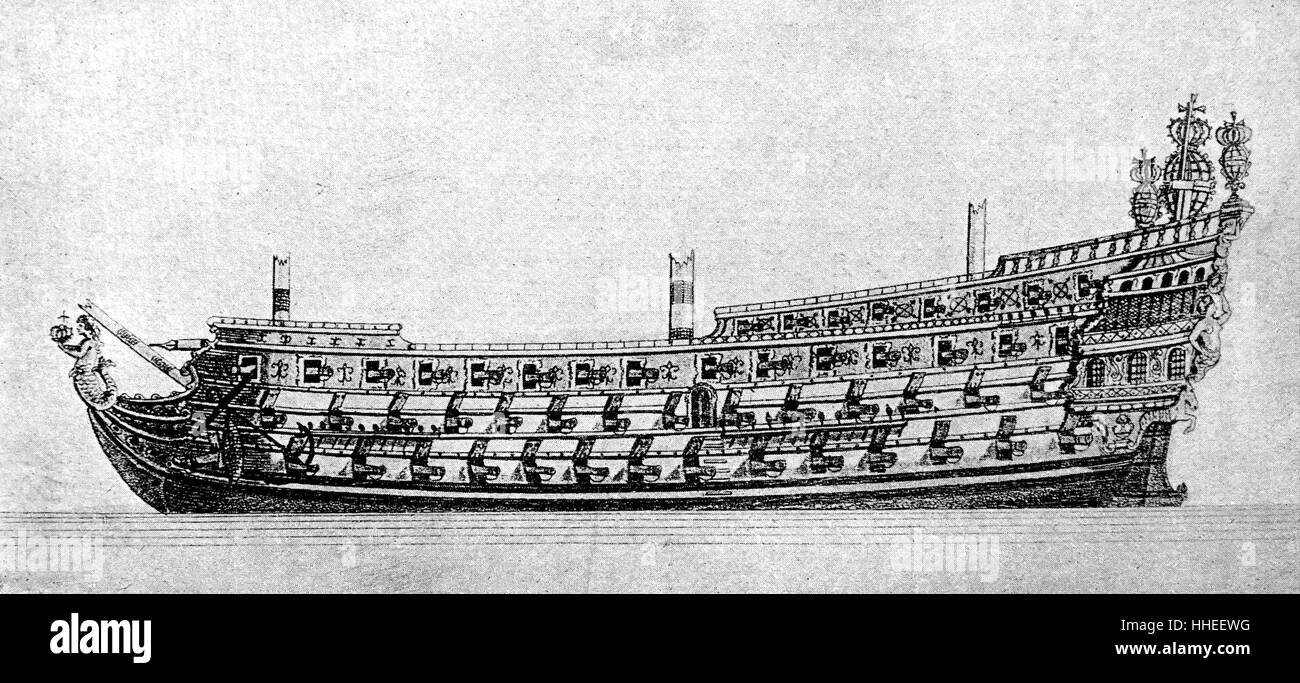 Illustration of the 'Soleil Royal', the finest ship of the navy of King Louis XIV. Dated 18th Century Stock Photohttps://www.alamy.com/image-license-details/?v=1https://www.alamy.com/stock-photo-illustration-of-the-soleil-royal-the-finest-ship-of-the-navy-of-king-131240748.html
Illustration of the 'Soleil Royal', the finest ship of the navy of King Louis XIV. Dated 18th Century Stock Photohttps://www.alamy.com/image-license-details/?v=1https://www.alamy.com/stock-photo-illustration-of-the-soleil-royal-the-finest-ship-of-the-navy-of-king-131240748.htmlRMHHEEWG–Illustration of the 'Soleil Royal', the finest ship of the navy of King Louis XIV. Dated 18th Century
 HMS Trincomalee at The National Museum of the Royal Navy, Hartlepool UK Stock Photohttps://www.alamy.com/image-license-details/?v=1https://www.alamy.com/stock-image-hms-trincomalee-at-the-national-museum-of-the-royal-navy-hartlepool-167517060.html
HMS Trincomalee at The National Museum of the Royal Navy, Hartlepool UK Stock Photohttps://www.alamy.com/image-license-details/?v=1https://www.alamy.com/stock-image-hms-trincomalee-at-the-national-museum-of-the-royal-navy-hartlepool-167517060.htmlRMKMF1M4–HMS Trincomalee at The National Museum of the Royal Navy, Hartlepool UK
 AJAXNETPHOTO. 18TH JULY, 1999. SAHUR, FRANCE. - ARMADA DU SIECLE - ARMADA OF THE CENTURY - HAPPIER DAYS. PRIDE OF THE FRENCH NAVY HELICOPTER CRUISER JEANNE D'ARC UNDER WAY ON THE RIVER SEINE TOWARD LE HAVRE DURING THE FESTIVAL 'SAIL PAST'. PHOTO:JONATHAN EASTLAND/AJAX REF:991807 Stock Photohttps://www.alamy.com/image-license-details/?v=1https://www.alamy.com/stock-photo-ajaxnetphoto-18th-july-1999-sahur-france-armada-du-siecle-armada-of-79042039.html
AJAXNETPHOTO. 18TH JULY, 1999. SAHUR, FRANCE. - ARMADA DU SIECLE - ARMADA OF THE CENTURY - HAPPIER DAYS. PRIDE OF THE FRENCH NAVY HELICOPTER CRUISER JEANNE D'ARC UNDER WAY ON THE RIVER SEINE TOWARD LE HAVRE DURING THE FESTIVAL 'SAIL PAST'. PHOTO:JONATHAN EASTLAND/AJAX REF:991807 Stock Photohttps://www.alamy.com/image-license-details/?v=1https://www.alamy.com/stock-photo-ajaxnetphoto-18th-july-1999-sahur-france-armada-du-siecle-armada-of-79042039.htmlRMEGGJWY–AJAXNETPHOTO. 18TH JULY, 1999. SAHUR, FRANCE. - ARMADA DU SIECLE - ARMADA OF THE CENTURY - HAPPIER DAYS. PRIDE OF THE FRENCH NAVY HELICOPTER CRUISER JEANNE D'ARC UNDER WAY ON THE RIVER SEINE TOWARD LE HAVRE DURING THE FESTIVAL 'SAIL PAST'. PHOTO:JONATHAN EASTLAND/AJAX REF:991807
 A 74 Gun Ship of the line of the British Royal Navy on the high seas from about 1794. Stock Photohttps://www.alamy.com/image-license-details/?v=1https://www.alamy.com/stock-photo-a-74-gun-ship-of-the-line-of-the-british-royal-navy-on-the-high-seas-31400177.html
A 74 Gun Ship of the line of the British Royal Navy on the high seas from about 1794. Stock Photohttps://www.alamy.com/image-license-details/?v=1https://www.alamy.com/stock-photo-a-74-gun-ship-of-the-line-of-the-british-royal-navy-on-the-high-seas-31400177.htmlRMBR2B6W–A 74 Gun Ship of the line of the British Royal Navy on the high seas from about 1794.
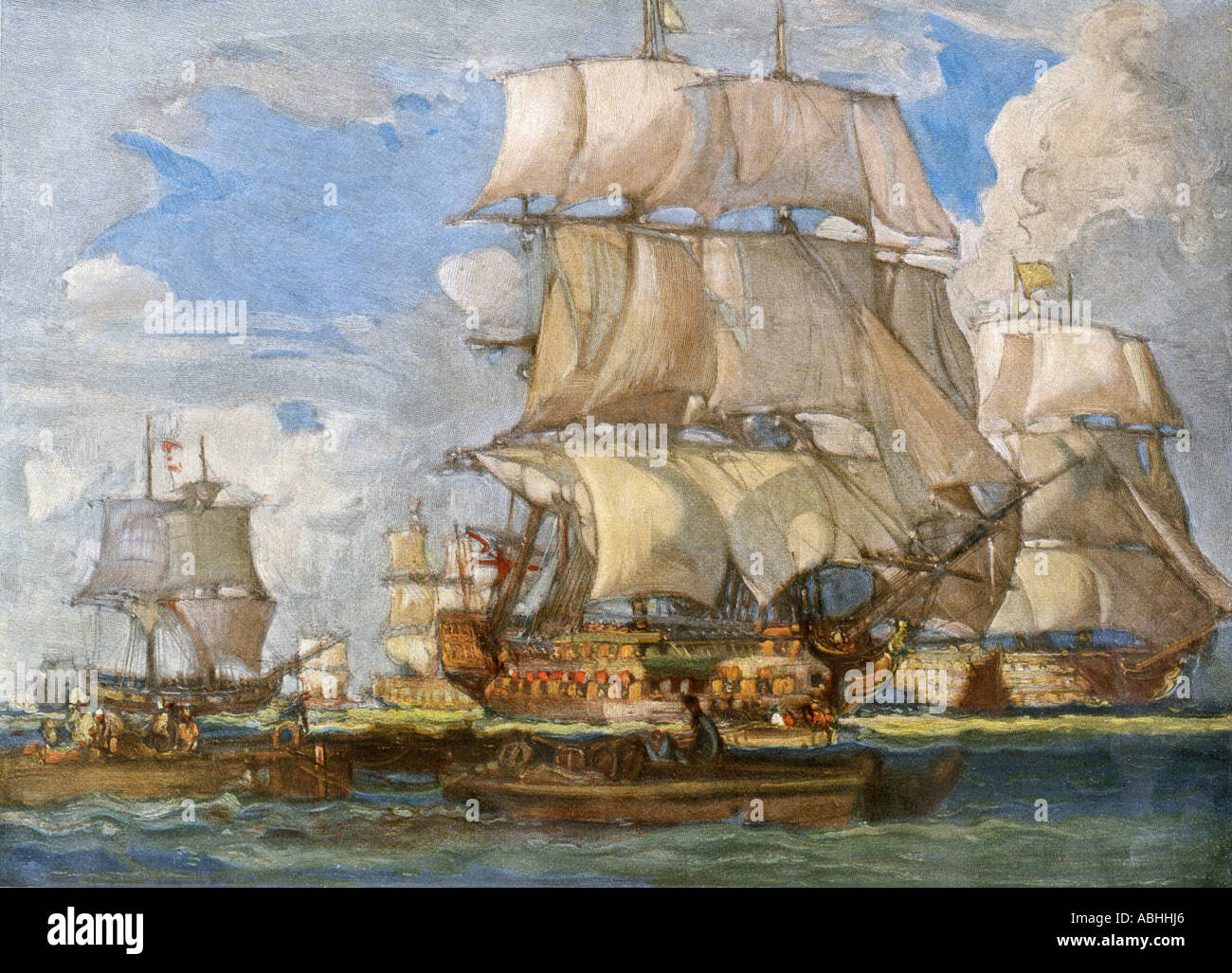 British Navy under Lord Howe sailing from Spithead for sea battles off the coast of France 1794. Color halftone of an illustration Stock Photohttps://www.alamy.com/image-license-details/?v=1https://www.alamy.com/british-navy-under-lord-howe-sailing-from-spithead-for-sea-battles-image7370213.html
British Navy under Lord Howe sailing from Spithead for sea battles off the coast of France 1794. Color halftone of an illustration Stock Photohttps://www.alamy.com/image-license-details/?v=1https://www.alamy.com/british-navy-under-lord-howe-sailing-from-spithead-for-sea-battles-image7370213.htmlRMABHHJ6–British Navy under Lord Howe sailing from Spithead for sea battles off the coast of France 1794. Color halftone of an illustration
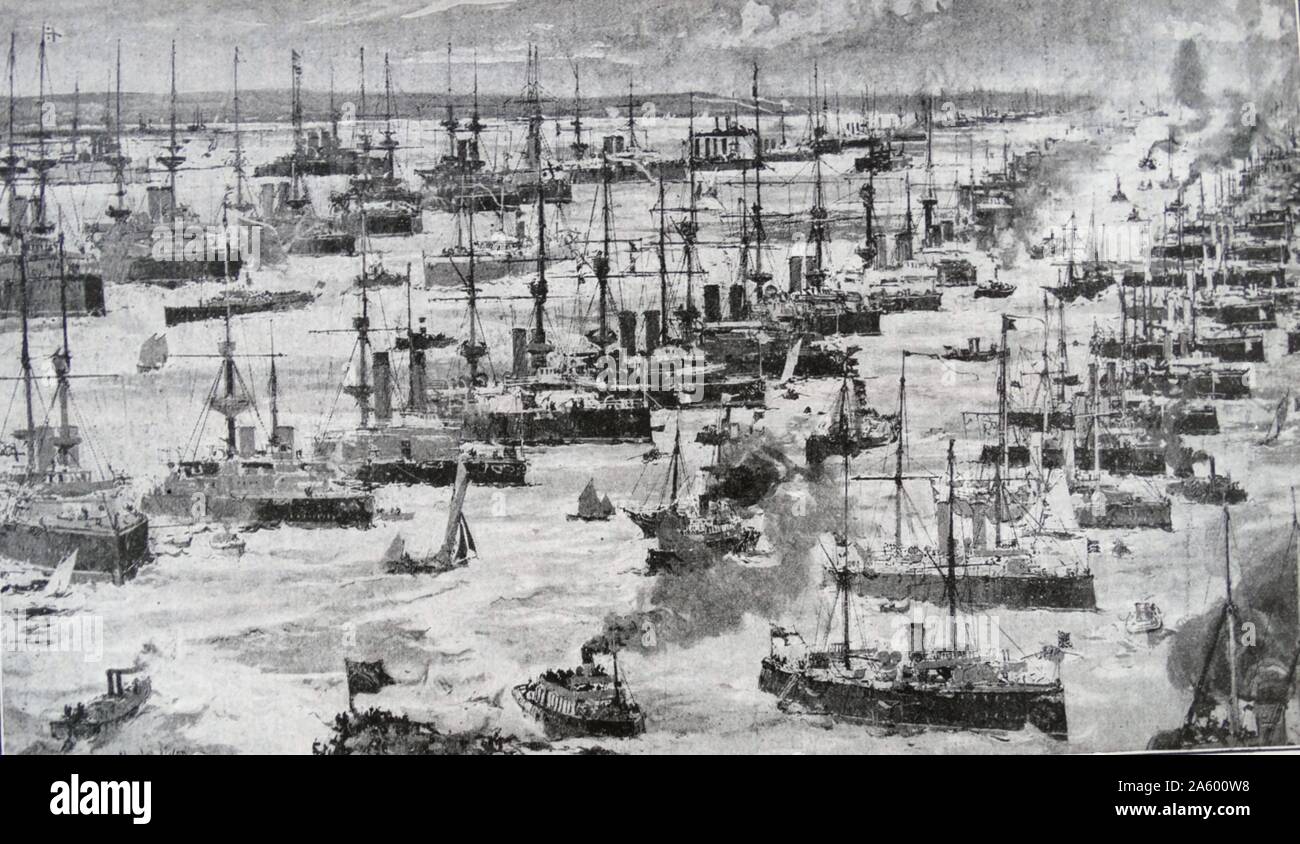 Bird's Eye view of the British Navy assembled at Spithead, England. Dated 1797 Stock Photohttps://www.alamy.com/image-license-details/?v=1https://www.alamy.com/birds-eye-view-of-the-british-navy-assembled-at-spithead-england-dated-1797-image330685636.html
Bird's Eye view of the British Navy assembled at Spithead, England. Dated 1797 Stock Photohttps://www.alamy.com/image-license-details/?v=1https://www.alamy.com/birds-eye-view-of-the-british-navy-assembled-at-spithead-england-dated-1797-image330685636.htmlRM2A600W8–Bird's Eye view of the British Navy assembled at Spithead, England. Dated 1797
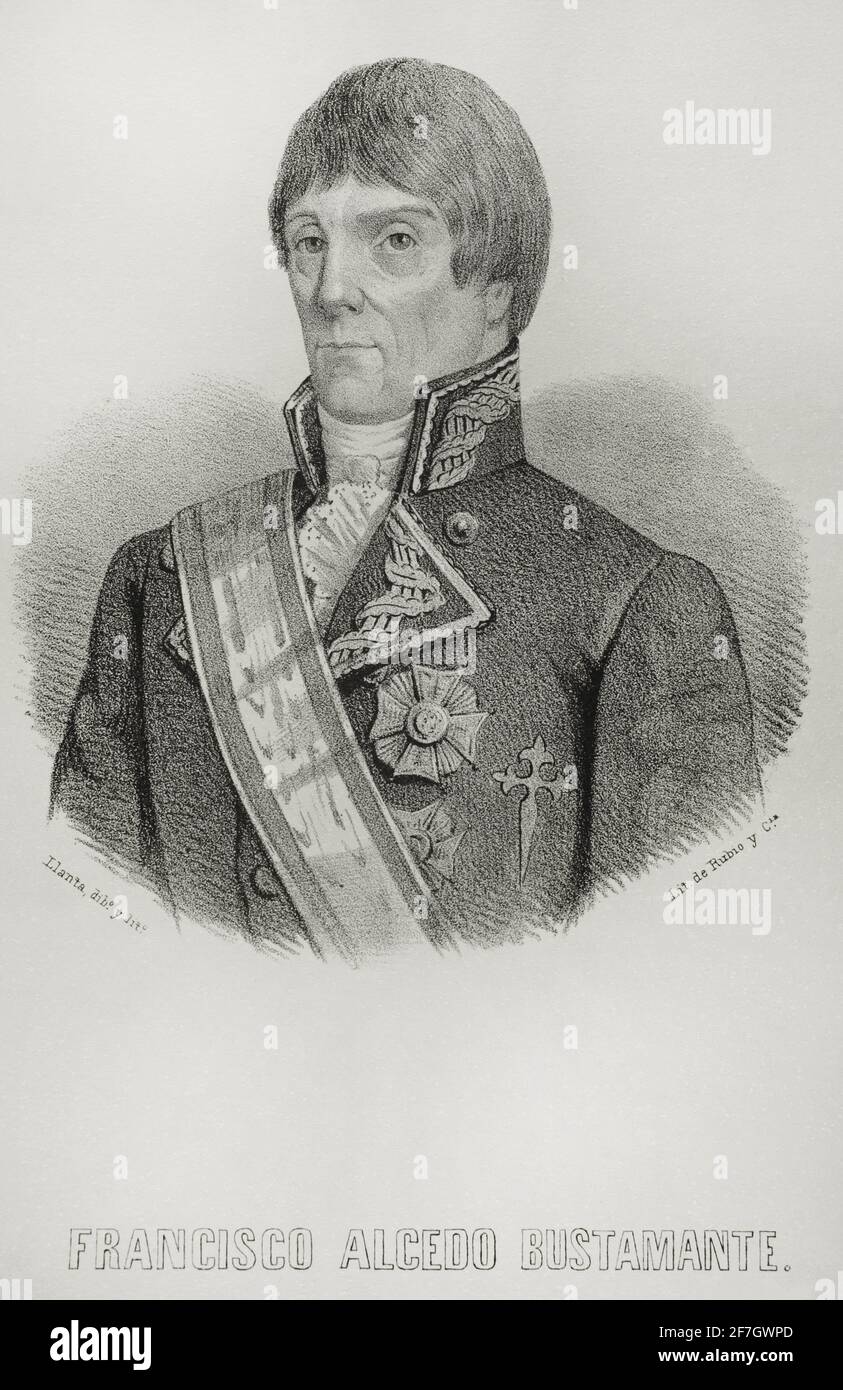 Francisco Alcedo Bustamante (1758-1805). Captain of the Spanish Navy. He was the commander of the ship 'Montañez', on whose deck he died during the Battle of Trafalgar on 21st October 1805. Illustration by Llanta. Portrait. Lithography. Crónica General de España, Historia Ilustrada y Descriptiva de sus Provincias. Castilla-La Vieja, 1870. Stock Photohttps://www.alamy.com/image-license-details/?v=1https://www.alamy.com/francisco-alcedo-bustamante-1758-1805-captain-of-the-spanish-navy-he-was-the-commander-of-the-ship-montaez-on-whose-deck-he-died-during-the-battle-of-trafalgar-on-21st-october-1805-illustration-by-llanta-portrait-lithography-crnica-general-de-espaa-historia-ilustrada-y-descriptiva-de-sus-provincias-castilla-la-vieja-1870-image417722885.html
Francisco Alcedo Bustamante (1758-1805). Captain of the Spanish Navy. He was the commander of the ship 'Montañez', on whose deck he died during the Battle of Trafalgar on 21st October 1805. Illustration by Llanta. Portrait. Lithography. Crónica General de España, Historia Ilustrada y Descriptiva de sus Provincias. Castilla-La Vieja, 1870. Stock Photohttps://www.alamy.com/image-license-details/?v=1https://www.alamy.com/francisco-alcedo-bustamante-1758-1805-captain-of-the-spanish-navy-he-was-the-commander-of-the-ship-montaez-on-whose-deck-he-died-during-the-battle-of-trafalgar-on-21st-october-1805-illustration-by-llanta-portrait-lithography-crnica-general-de-espaa-historia-ilustrada-y-descriptiva-de-sus-provincias-castilla-la-vieja-1870-image417722885.htmlRM2F7GWPD–Francisco Alcedo Bustamante (1758-1805). Captain of the Spanish Navy. He was the commander of the ship 'Montañez', on whose deck he died during the Battle of Trafalgar on 21st October 1805. Illustration by Llanta. Portrait. Lithography. Crónica General de España, Historia Ilustrada y Descriptiva de sus Provincias. Castilla-La Vieja, 1870.
 Victorian print showing a sailing ship leaving Archangel (Arkhangelsk) Russia Stock Photohttps://www.alamy.com/image-license-details/?v=1https://www.alamy.com/stock-photo-victorian-print-showing-a-sailing-ship-leaving-archangel-arkhangelsk-148654980.html
Victorian print showing a sailing ship leaving Archangel (Arkhangelsk) Russia Stock Photohttps://www.alamy.com/image-license-details/?v=1https://www.alamy.com/stock-photo-victorian-print-showing-a-sailing-ship-leaving-archangel-arkhangelsk-148654980.htmlRMJHRPXC–Victorian print showing a sailing ship leaving Archangel (Arkhangelsk) Russia
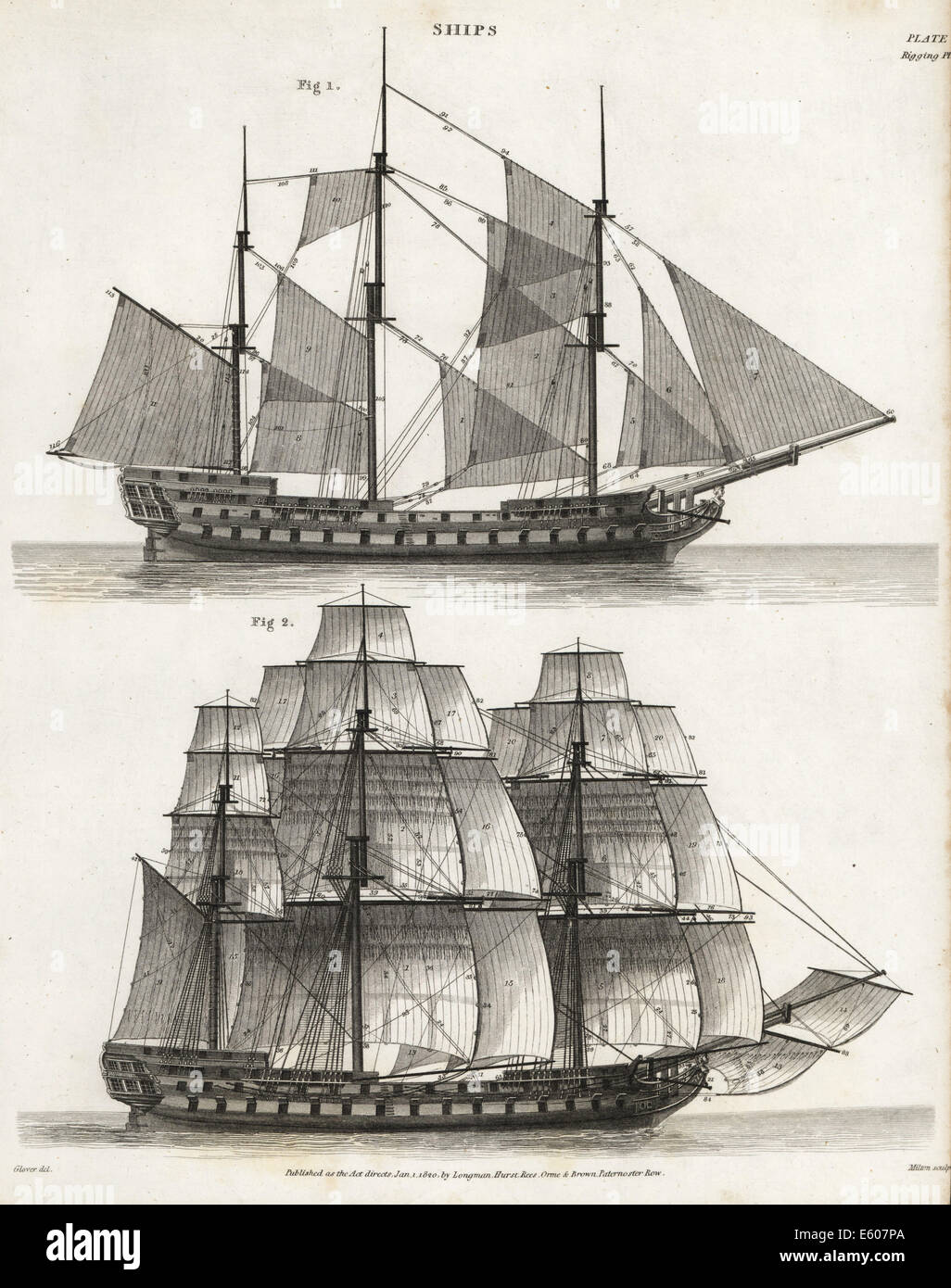 Rigging plans for sailing ships, 18th century. Stock Photohttps://www.alamy.com/image-license-details/?v=1https://www.alamy.com/stock-photo-rigging-plans-for-sailing-ships-18th-century-72535522.html
Rigging plans for sailing ships, 18th century. Stock Photohttps://www.alamy.com/image-license-details/?v=1https://www.alamy.com/stock-photo-rigging-plans-for-sailing-ships-18th-century-72535522.htmlRME607PA–Rigging plans for sailing ships, 18th century.
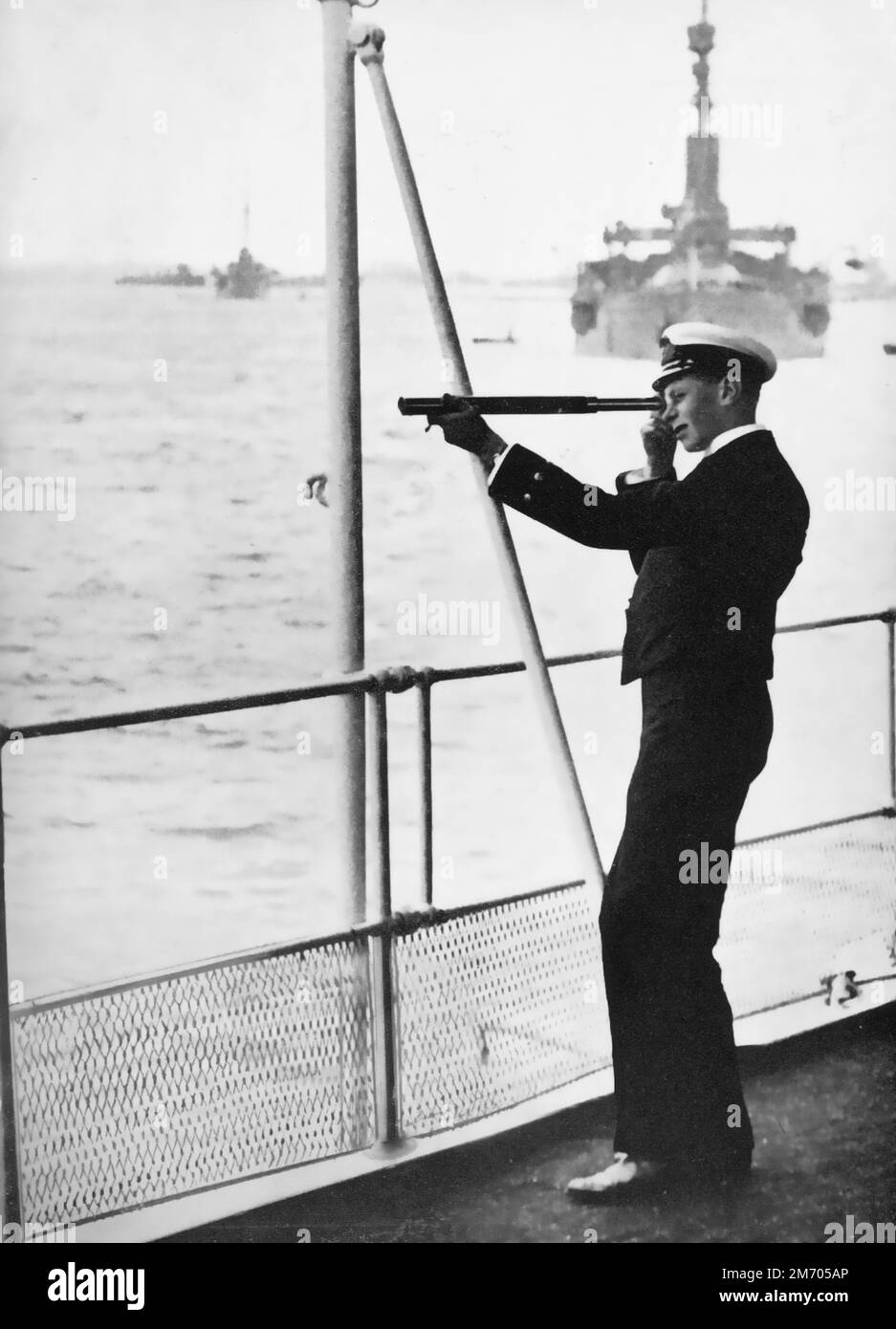 Midshipman, Prince Albert, watching the Spithead Review, July 1914. The future King George VI (1895-1952) watching the mobilisation of the Royal Navy fleet. From 18th to 20th July 1914, the naval fleet of the United Kingdom was mobilised for World War I. Stock Photohttps://www.alamy.com/image-license-details/?v=1https://www.alamy.com/midshipman-prince-albert-watching-the-spithead-review-july-1914-the-future-king-george-vi-1895-1952-watching-the-mobilisation-of-the-royal-navy-fleet-from-18th-to-20th-july-1914the-naval-fleetof-the-united-kingdom-was-mobilised-for-world-war-i-image503407486.html
Midshipman, Prince Albert, watching the Spithead Review, July 1914. The future King George VI (1895-1952) watching the mobilisation of the Royal Navy fleet. From 18th to 20th July 1914, the naval fleet of the United Kingdom was mobilised for World War I. Stock Photohttps://www.alamy.com/image-license-details/?v=1https://www.alamy.com/midshipman-prince-albert-watching-the-spithead-review-july-1914-the-future-king-george-vi-1895-1952-watching-the-mobilisation-of-the-royal-navy-fleet-from-18th-to-20th-july-1914the-naval-fleetof-the-united-kingdom-was-mobilised-for-world-war-i-image503407486.htmlRM2M705AP–Midshipman, Prince Albert, watching the Spithead Review, July 1914. The future King George VI (1895-1952) watching the mobilisation of the Royal Navy fleet. From 18th to 20th July 1914, the naval fleet of the United Kingdom was mobilised for World War I.
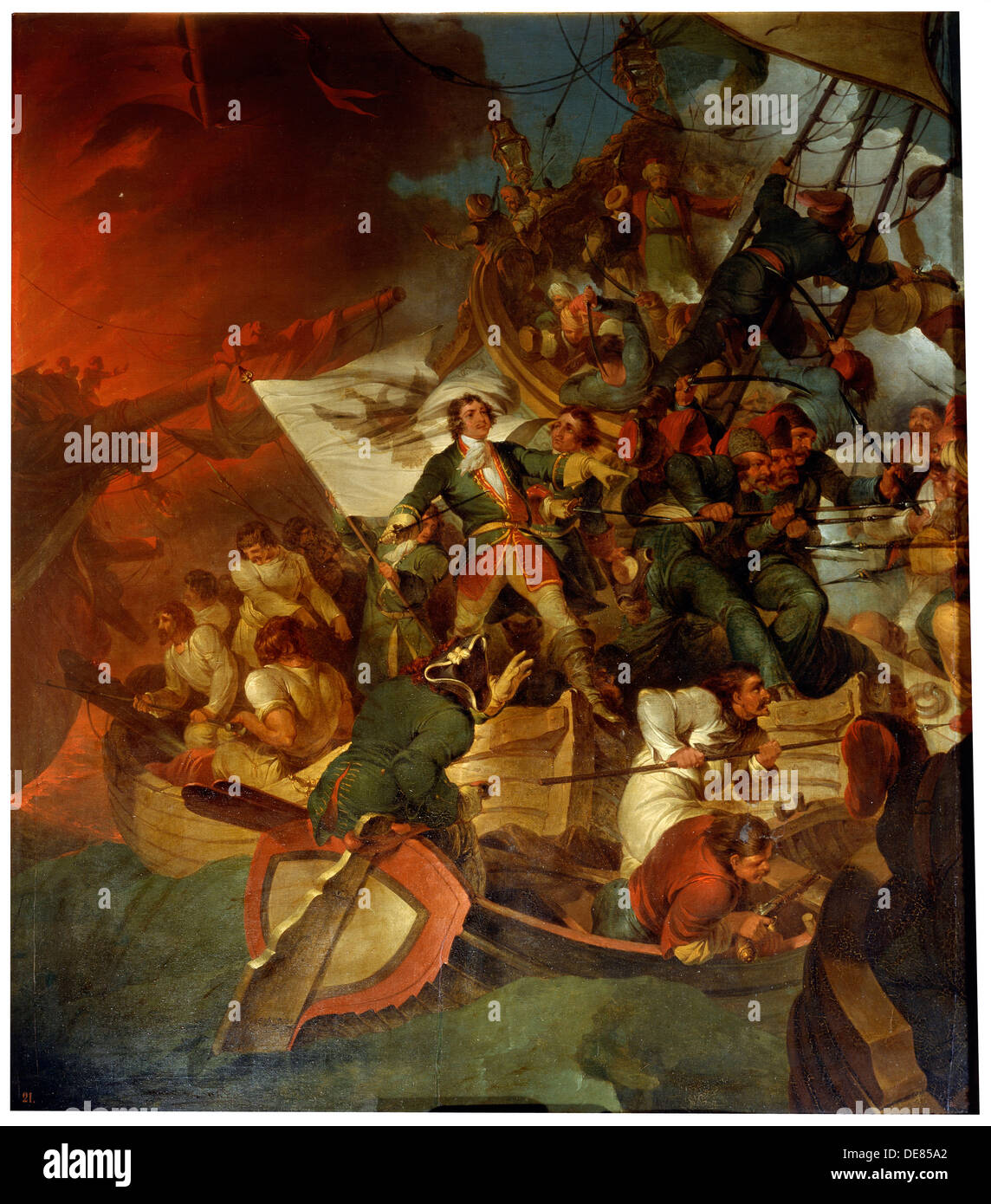 'Taking of Azov on 18 May 1696', late 18th or 19th century. Artist: Robert Ker Porter Stock Photohttps://www.alamy.com/image-license-details/?v=1https://www.alamy.com/taking-of-azov-on-18-may-1696-late-18th-or-19th-century-artist-robert-image60416106.html
'Taking of Azov on 18 May 1696', late 18th or 19th century. Artist: Robert Ker Porter Stock Photohttps://www.alamy.com/image-license-details/?v=1https://www.alamy.com/taking-of-azov-on-18-may-1696-late-18th-or-19th-century-artist-robert-image60416106.htmlRMDE85A2–'Taking of Azov on 18 May 1696', late 18th or 19th century. Artist: Robert Ker Porter
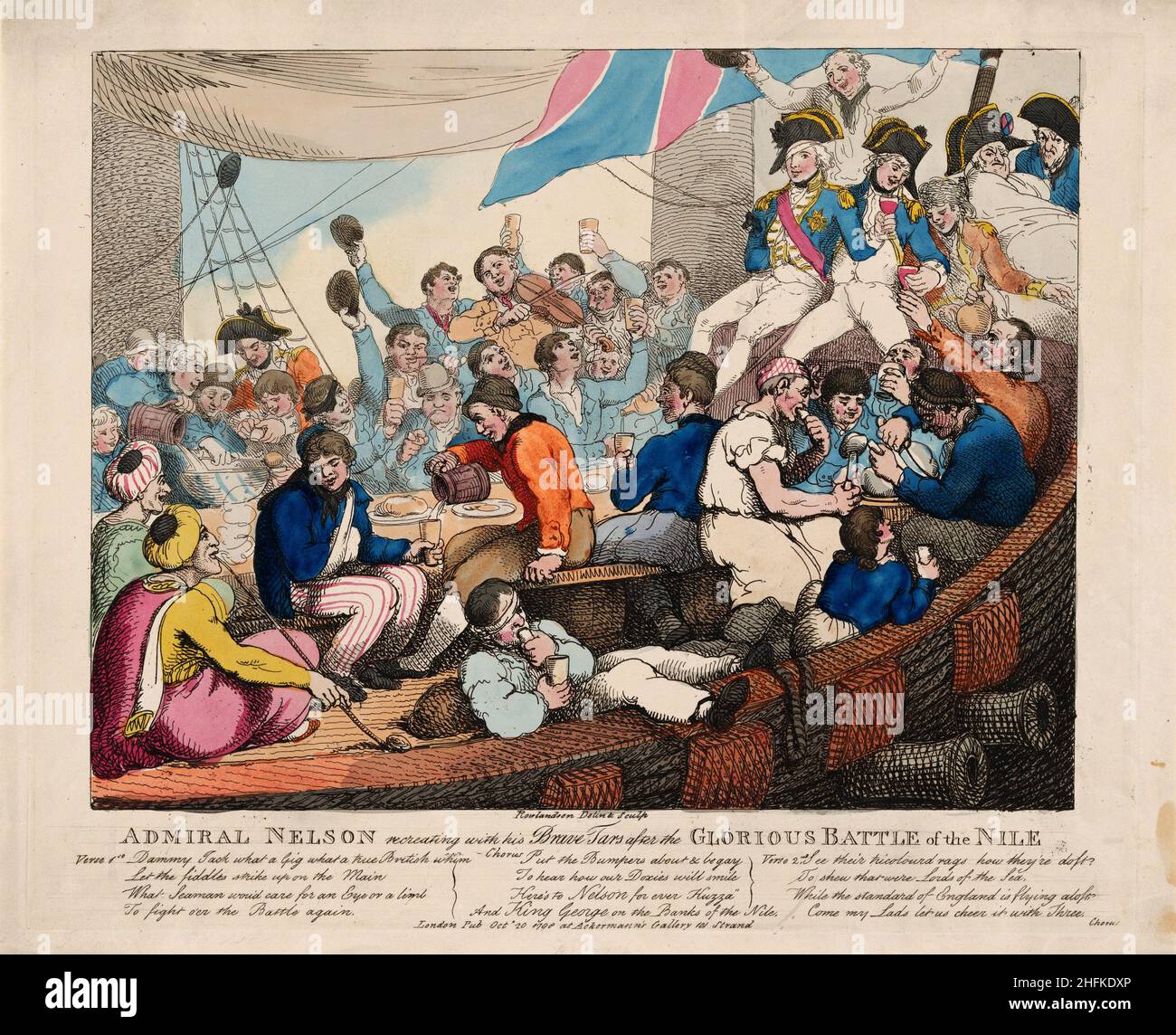 Admiral Nelson recreating with his brave Tars after the glorious Battle of the Nile. Artist: Thomas Rowlandson (1756-1827) an English artist and caricaturist of the Georgian Era. A social observer, he was a prolific artist and print maker. Credit: Thomas Rowlandson/Alamy Stock Photohttps://www.alamy.com/image-license-details/?v=1https://www.alamy.com/admiral-nelson-recreating-with-his-brave-tars-after-the-glorious-battle-of-the-nile-artist-thomas-rowlandson-1756-1827-an-english-artist-and-caricaturist-of-the-georgian-era-a-social-observer-he-was-a-prolific-artist-and-print-maker-credit-thomas-rowlandsonalamy-image457117438.html
Admiral Nelson recreating with his brave Tars after the glorious Battle of the Nile. Artist: Thomas Rowlandson (1756-1827) an English artist and caricaturist of the Georgian Era. A social observer, he was a prolific artist and print maker. Credit: Thomas Rowlandson/Alamy Stock Photohttps://www.alamy.com/image-license-details/?v=1https://www.alamy.com/admiral-nelson-recreating-with-his-brave-tars-after-the-glorious-battle-of-the-nile-artist-thomas-rowlandson-1756-1827-an-english-artist-and-caricaturist-of-the-georgian-era-a-social-observer-he-was-a-prolific-artist-and-print-maker-credit-thomas-rowlandsonalamy-image457117438.htmlRM2HFKDXP–Admiral Nelson recreating with his brave Tars after the glorious Battle of the Nile. Artist: Thomas Rowlandson (1756-1827) an English artist and caricaturist of the Georgian Era. A social observer, he was a prolific artist and print maker. Credit: Thomas Rowlandson/Alamy
![crustaceans collected and described on the voyage. from the book ' A voyage towards the North Pole : undertaken by His Majesty's command, 1773 ' by Constantine John Phipps, Baron Mulgrave, 1744-1792; The 1773 Phipps expedition towards the North Pole was a British Royal Navy expedition in which two ships under the commands of Constantine John Phipps as Captain of the HMS Racehorse [an 18-gun ship-rigged sloop of the Royal Navy.] and Skeffington Lutwidge as Captain of the HMS Carcass [a bomb vessel of the Royal Navy], sailed towards the North Pole in the summer of 1773 and became stuck in ice n Stock Photo crustaceans collected and described on the voyage. from the book ' A voyage towards the North Pole : undertaken by His Majesty's command, 1773 ' by Constantine John Phipps, Baron Mulgrave, 1744-1792; The 1773 Phipps expedition towards the North Pole was a British Royal Navy expedition in which two ships under the commands of Constantine John Phipps as Captain of the HMS Racehorse [an 18-gun ship-rigged sloop of the Royal Navy.] and Skeffington Lutwidge as Captain of the HMS Carcass [a bomb vessel of the Royal Navy], sailed towards the North Pole in the summer of 1773 and became stuck in ice n Stock Photo](https://c8.alamy.com/comp/2GB5CAB/crustaceans-collected-and-described-on-the-voyage-from-the-book-a-voyage-towards-the-north-pole-undertaken-by-his-majestys-command-1773-by-constantine-john-phipps-baron-mulgrave-1744-1792-the-1773-phipps-expedition-towards-the-north-pole-was-a-british-royal-navy-expedition-in-which-two-ships-under-the-commands-of-constantine-john-phipps-as-captain-of-the-hms-racehorse-an-18-gun-ship-rigged-sloop-of-the-royal-navy-and-skeffington-lutwidge-as-captain-of-the-hms-carcass-a-bomb-vessel-of-the-royal-navy-sailed-towards-the-north-pole-in-the-summer-of-1773-and-became-stuck-in-ice-n-2GB5CAB.jpg) crustaceans collected and described on the voyage. from the book ' A voyage towards the North Pole : undertaken by His Majesty's command, 1773 ' by Constantine John Phipps, Baron Mulgrave, 1744-1792; The 1773 Phipps expedition towards the North Pole was a British Royal Navy expedition in which two ships under the commands of Constantine John Phipps as Captain of the HMS Racehorse [an 18-gun ship-rigged sloop of the Royal Navy.] and Skeffington Lutwidge as Captain of the HMS Carcass [a bomb vessel of the Royal Navy], sailed towards the North Pole in the summer of 1773 and became stuck in ice n Stock Photohttps://www.alamy.com/image-license-details/?v=1https://www.alamy.com/crustaceans-collected-and-described-on-the-voyage-from-the-book-a-voyage-towards-the-north-pole-undertaken-by-his-majestys-command-1773-by-constantine-john-phipps-baron-mulgrave-1744-1792-the-1773-phipps-expedition-towards-the-north-pole-was-a-british-royal-navy-expedition-in-which-two-ships-under-the-commands-of-constantine-john-phipps-as-captain-of-the-hms-racehorse-an-18-gun-ship-rigged-sloop-of-the-royal-navy-and-skeffington-lutwidge-as-captain-of-the-hms-carcass-a-bomb-vessel-of-the-royal-navy-sailed-towards-the-north-pole-in-the-summer-of-1773-and-became-stuck-in-ice-n-image437139875.html
crustaceans collected and described on the voyage. from the book ' A voyage towards the North Pole : undertaken by His Majesty's command, 1773 ' by Constantine John Phipps, Baron Mulgrave, 1744-1792; The 1773 Phipps expedition towards the North Pole was a British Royal Navy expedition in which two ships under the commands of Constantine John Phipps as Captain of the HMS Racehorse [an 18-gun ship-rigged sloop of the Royal Navy.] and Skeffington Lutwidge as Captain of the HMS Carcass [a bomb vessel of the Royal Navy], sailed towards the North Pole in the summer of 1773 and became stuck in ice n Stock Photohttps://www.alamy.com/image-license-details/?v=1https://www.alamy.com/crustaceans-collected-and-described-on-the-voyage-from-the-book-a-voyage-towards-the-north-pole-undertaken-by-his-majestys-command-1773-by-constantine-john-phipps-baron-mulgrave-1744-1792-the-1773-phipps-expedition-towards-the-north-pole-was-a-british-royal-navy-expedition-in-which-two-ships-under-the-commands-of-constantine-john-phipps-as-captain-of-the-hms-racehorse-an-18-gun-ship-rigged-sloop-of-the-royal-navy-and-skeffington-lutwidge-as-captain-of-the-hms-carcass-a-bomb-vessel-of-the-royal-navy-sailed-towards-the-north-pole-in-the-summer-of-1773-and-became-stuck-in-ice-n-image437139875.htmlRM2GB5CAB–crustaceans collected and described on the voyage. from the book ' A voyage towards the North Pole : undertaken by His Majesty's command, 1773 ' by Constantine John Phipps, Baron Mulgrave, 1744-1792; The 1773 Phipps expedition towards the North Pole was a British Royal Navy expedition in which two ships under the commands of Constantine John Phipps as Captain of the HMS Racehorse [an 18-gun ship-rigged sloop of the Royal Navy.] and Skeffington Lutwidge as Captain of the HMS Carcass [a bomb vessel of the Royal Navy], sailed towards the North Pole in the summer of 1773 and became stuck in ice n
 The Grand Turk , an 18th century three-masted frigate, at Great Yarmouth Maritime Festival Stock Photohttps://www.alamy.com/image-license-details/?v=1https://www.alamy.com/stock-photo-the-grand-turk-an-18th-century-three-masted-frigate-at-great-yarmouth-27140088.html
The Grand Turk , an 18th century three-masted frigate, at Great Yarmouth Maritime Festival Stock Photohttps://www.alamy.com/image-license-details/?v=1https://www.alamy.com/stock-photo-the-grand-turk-an-18th-century-three-masted-frigate-at-great-yarmouth-27140088.htmlRMBG49CT–The Grand Turk , an 18th century three-masted frigate, at Great Yarmouth Maritime Festival
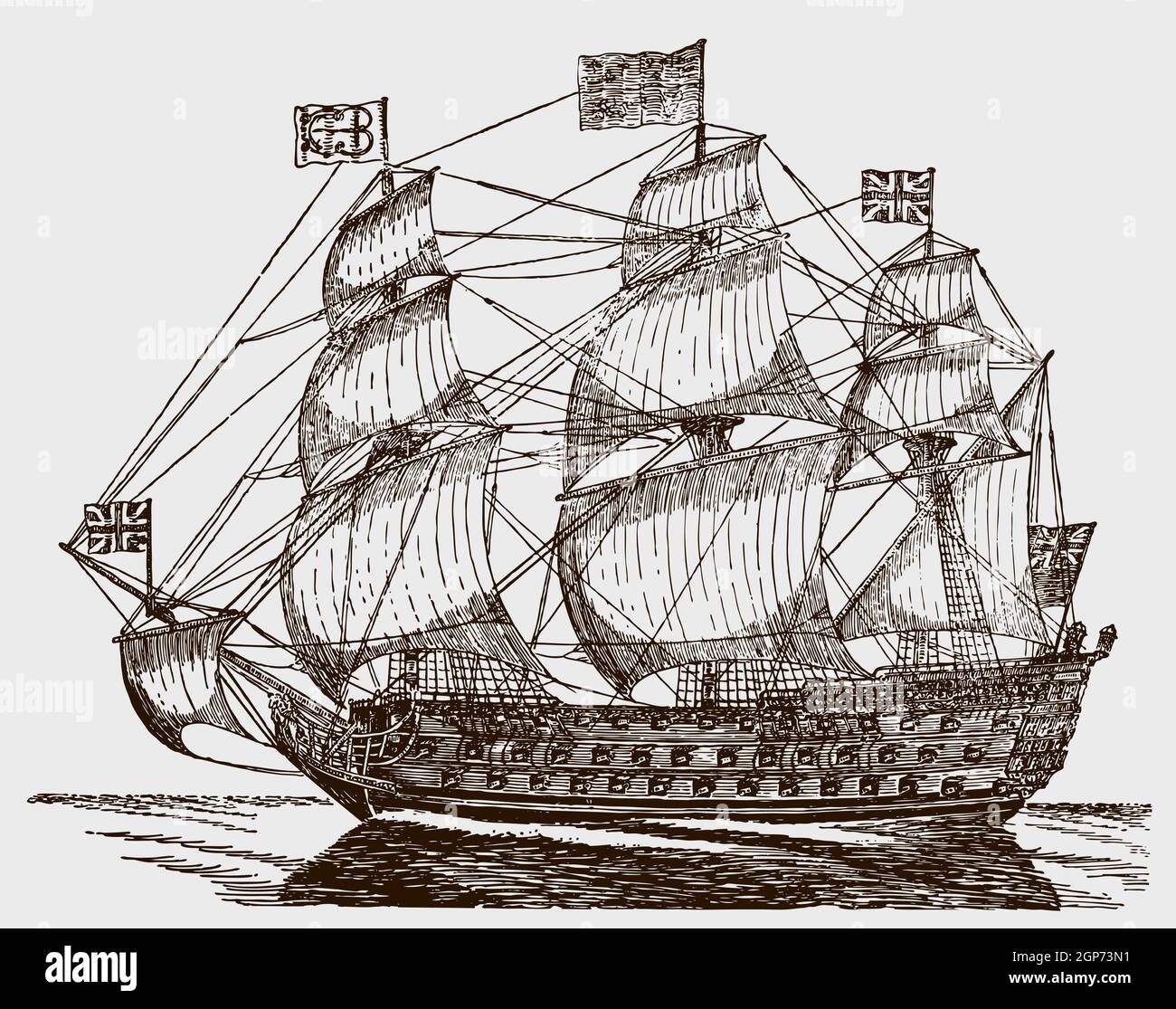 Royal George, historic English warship from 18th century at sea Stock Vectorhttps://www.alamy.com/image-license-details/?v=1https://www.alamy.com/royal-george-historic-english-warship-from-18th-century-at-sea-image443938237.html
Royal George, historic English warship from 18th century at sea Stock Vectorhttps://www.alamy.com/image-license-details/?v=1https://www.alamy.com/royal-george-historic-english-warship-from-18th-century-at-sea-image443938237.htmlRF2GP73N1–Royal George, historic English warship from 18th century at sea
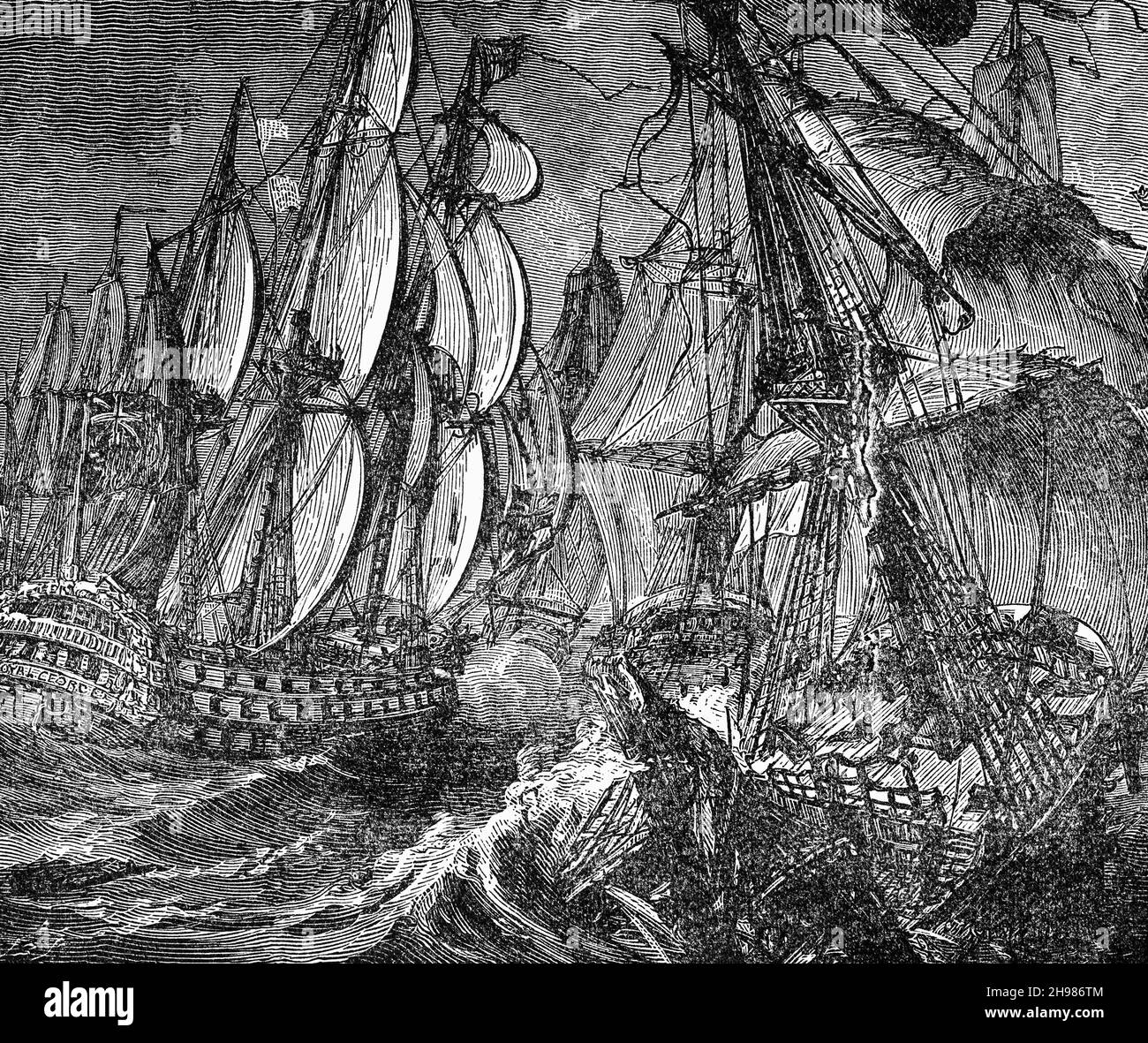 A late 19th Century illustration of the Battle of Cape St. Vincent, a naval battle that took place off the southern coast of Portugal on 16 January 1780 during the American Revolutionary War. A British fleet under Admiral Sir George Rodney defeated a Spanish squadron under Don Juan de Lángara. The battle is sometimes referred to as the Moonlight Battle because it was unusual for naval battles in the Age of Sail to take place at night. It was also the first major naval victory for the British over their European enemies in the war and proved the value of copper-sheathing the hulls of warships. Stock Photohttps://www.alamy.com/image-license-details/?v=1https://www.alamy.com/a-late-19th-century-illustration-of-the-battle-of-cape-st-vincent-a-naval-battle-that-took-place-off-the-southern-coast-of-portugal-on-16-january-1780-during-the-american-revolutionary-war-a-british-fleet-under-admiral-sir-george-rodney-defeated-a-spanish-squadron-under-don-juan-de-lngara-the-battle-is-sometimes-referred-to-as-the-moonlight-battle-because-it-was-unusual-for-naval-battles-in-the-age-of-sail-to-take-place-at-night-it-was-also-the-first-major-naval-victory-for-the-british-over-their-european-enemies-in-the-war-and-proved-the-value-of-copper-sheathing-the-hulls-of-warships-image453182484.html
A late 19th Century illustration of the Battle of Cape St. Vincent, a naval battle that took place off the southern coast of Portugal on 16 January 1780 during the American Revolutionary War. A British fleet under Admiral Sir George Rodney defeated a Spanish squadron under Don Juan de Lángara. The battle is sometimes referred to as the Moonlight Battle because it was unusual for naval battles in the Age of Sail to take place at night. It was also the first major naval victory for the British over their European enemies in the war and proved the value of copper-sheathing the hulls of warships. Stock Photohttps://www.alamy.com/image-license-details/?v=1https://www.alamy.com/a-late-19th-century-illustration-of-the-battle-of-cape-st-vincent-a-naval-battle-that-took-place-off-the-southern-coast-of-portugal-on-16-january-1780-during-the-american-revolutionary-war-a-british-fleet-under-admiral-sir-george-rodney-defeated-a-spanish-squadron-under-don-juan-de-lngara-the-battle-is-sometimes-referred-to-as-the-moonlight-battle-because-it-was-unusual-for-naval-battles-in-the-age-of-sail-to-take-place-at-night-it-was-also-the-first-major-naval-victory-for-the-british-over-their-european-enemies-in-the-war-and-proved-the-value-of-copper-sheathing-the-hulls-of-warships-image453182484.htmlRM2H986TM–A late 19th Century illustration of the Battle of Cape St. Vincent, a naval battle that took place off the southern coast of Portugal on 16 January 1780 during the American Revolutionary War. A British fleet under Admiral Sir George Rodney defeated a Spanish squadron under Don Juan de Lángara. The battle is sometimes referred to as the Moonlight Battle because it was unusual for naval battles in the Age of Sail to take place at night. It was also the first major naval victory for the British over their European enemies in the war and proved the value of copper-sheathing the hulls of warships.
 Blasco de Garay (1500–1552) was a Spanish navy captain and inventor. De Garay was a captain in the Spanish navy in the reign of the Holy Roman Emperor, Charles V. He made several important inventions, including diving apparatus, and introduced the paddle wheel as a substitute for oars. In the nineteenth century, a Spanish archivist claimed to have discovered documents that showed that de Garay had tested a steam-powered ship in 1543. From the book La ciencia y sus hombres : vidas de los sabios ilustres desde la antigüedad hasta el siglo XIX T. 3 [Science and its men: lives of the illustrious Stock Photohttps://www.alamy.com/image-license-details/?v=1https://www.alamy.com/blasco-de-garay-15001552-was-a-spanish-navy-captain-and-inventor-de-garay-was-a-captain-in-the-spanish-navy-in-the-reign-of-the-holy-roman-emperor-charles-v-he-made-several-important-inventions-including-diving-apparatus-and-introduced-the-paddle-wheel-as-a-substitute-for-oars-in-the-nineteenth-century-a-spanish-archivist-claimed-to-have-discovered-documents-that-showed-that-de-garay-had-tested-a-steam-powered-ship-in-1543-from-the-book-la-ciencia-y-sus-hombres-vidas-de-los-sabios-ilustres-desde-la-antigedad-hasta-el-siglo-xix-t-3-science-and-its-men-lives-of-the-illustrious-image368110838.html
Blasco de Garay (1500–1552) was a Spanish navy captain and inventor. De Garay was a captain in the Spanish navy in the reign of the Holy Roman Emperor, Charles V. He made several important inventions, including diving apparatus, and introduced the paddle wheel as a substitute for oars. In the nineteenth century, a Spanish archivist claimed to have discovered documents that showed that de Garay had tested a steam-powered ship in 1543. From the book La ciencia y sus hombres : vidas de los sabios ilustres desde la antigüedad hasta el siglo XIX T. 3 [Science and its men: lives of the illustrious Stock Photohttps://www.alamy.com/image-license-details/?v=1https://www.alamy.com/blasco-de-garay-15001552-was-a-spanish-navy-captain-and-inventor-de-garay-was-a-captain-in-the-spanish-navy-in-the-reign-of-the-holy-roman-emperor-charles-v-he-made-several-important-inventions-including-diving-apparatus-and-introduced-the-paddle-wheel-as-a-substitute-for-oars-in-the-nineteenth-century-a-spanish-archivist-claimed-to-have-discovered-documents-that-showed-that-de-garay-had-tested-a-steam-powered-ship-in-1543-from-the-book-la-ciencia-y-sus-hombres-vidas-de-los-sabios-ilustres-desde-la-antigedad-hasta-el-siglo-xix-t-3-science-and-its-men-lives-of-the-illustrious-image368110838.htmlRM2CATW3J–Blasco de Garay (1500–1552) was a Spanish navy captain and inventor. De Garay was a captain in the Spanish navy in the reign of the Holy Roman Emperor, Charles V. He made several important inventions, including diving apparatus, and introduced the paddle wheel as a substitute for oars. In the nineteenth century, a Spanish archivist claimed to have discovered documents that showed that de Garay had tested a steam-powered ship in 1543. From the book La ciencia y sus hombres : vidas de los sabios ilustres desde la antigüedad hasta el siglo XIX T. 3 [Science and its men: lives of the illustrious
 The Death of Captain Faulknor in 1795 when his ship HMS Blanche captured the Pique of the French Navy during the Revolutionary Wars. Stock Photohttps://www.alamy.com/image-license-details/?v=1https://www.alamy.com/the-death-of-captain-faulknor-in-1795-when-his-ship-hms-blanche-captured-image5770662.html
The Death of Captain Faulknor in 1795 when his ship HMS Blanche captured the Pique of the French Navy during the Revolutionary Wars. Stock Photohttps://www.alamy.com/image-license-details/?v=1https://www.alamy.com/the-death-of-captain-faulknor-in-1795-when-his-ship-hms-blanche-captured-image5770662.htmlRMA102J7–The Death of Captain Faulknor in 1795 when his ship HMS Blanche captured the Pique of the French Navy during the Revolutionary Wars.
 Royal Navy battle ship, c1760 (c1890-c1893). Artist: Unknown Stock Photohttps://www.alamy.com/image-license-details/?v=1https://www.alamy.com/royal-navy-battle-ship-c1760-c1890-c1893-artist-unknown-image262768088.html
Royal Navy battle ship, c1760 (c1890-c1893). Artist: Unknown Stock Photohttps://www.alamy.com/image-license-details/?v=1https://www.alamy.com/royal-navy-battle-ship-c1760-c1890-c1893-artist-unknown-image262768088.htmlRMW7E3AG–Royal Navy battle ship, c1760 (c1890-c1893). Artist: Unknown
 A View of Part of the Town of Boston in New England and British Ships of War Landing Their Troops, 1768 Stock Photohttps://www.alamy.com/image-license-details/?v=1https://www.alamy.com/a-view-of-part-of-the-town-of-boston-in-new-england-and-british-ships-of-war-landing-their-troops-1768-image634301166.html
A View of Part of the Town of Boston in New England and British Ships of War Landing Their Troops, 1768 Stock Photohttps://www.alamy.com/image-license-details/?v=1https://www.alamy.com/a-view-of-part-of-the-town-of-boston-in-new-england-and-british-ships-of-war-landing-their-troops-1768-image634301166.htmlRM2YRXWH2–A View of Part of the Town of Boston in New England and British Ships of War Landing Their Troops, 1768
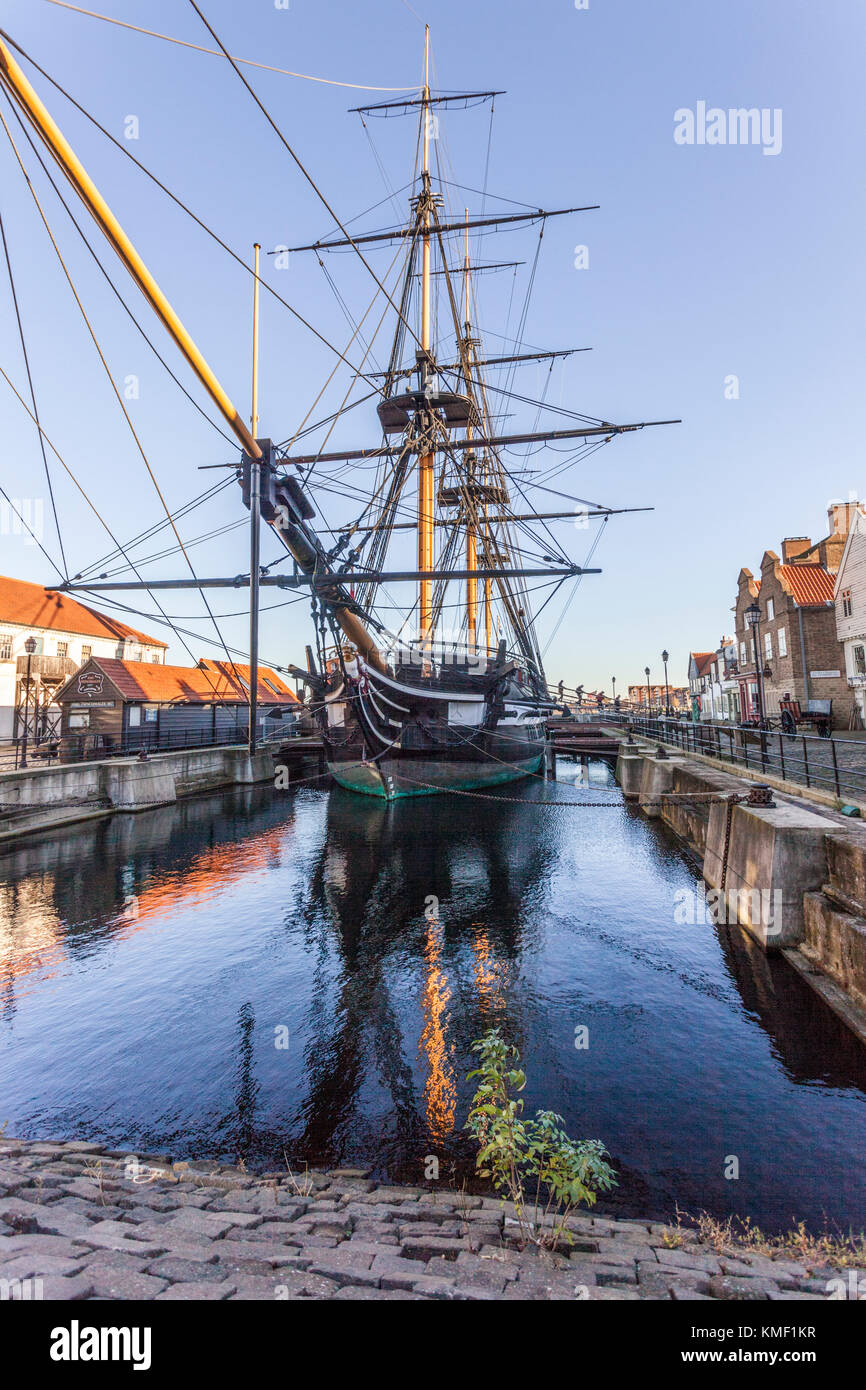 HMS Trincomalee at The National Museum of the Royal Navy, Hartlepool UK Stock Photohttps://www.alamy.com/image-license-details/?v=1https://www.alamy.com/stock-image-hms-trincomalee-at-the-national-museum-of-the-royal-navy-hartlepool-167517051.html
HMS Trincomalee at The National Museum of the Royal Navy, Hartlepool UK Stock Photohttps://www.alamy.com/image-license-details/?v=1https://www.alamy.com/stock-image-hms-trincomalee-at-the-national-museum-of-the-royal-navy-hartlepool-167517051.htmlRMKMF1KR–HMS Trincomalee at The National Museum of the Royal Navy, Hartlepool UK
 An old engraving of the 1797 mutiny at Spithead, The Solent, near Portsmouth, England, UK. It is from a Victorian history book of c.1900. Here sailors of HMS Royal George are hauling down the naval red ensign flag. The mutiny lasted from 16 April to 15 May 1797. Sailors on 16 ships in the Channel Fleet, commanded by Admiral Lord Bridport, protested against the living conditions aboard Royal Navy vessels and demanded a pay rise, better rations, increased shore leave, and compensation for sickness and injury. Stock Photohttps://www.alamy.com/image-license-details/?v=1https://www.alamy.com/an-old-engraving-of-the-1797-mutiny-at-spithead-the-solent-near-portsmouth-england-uk-it-is-from-a-victorian-history-book-of-c1900-here-sailors-of-hms-royal-george-are-hauling-down-the-naval-red-ensign-flag-the-mutiny-lasted-from-16-april-to-15-may-1797-sailors-on-16-ships-in-the-channel-fleet-commanded-by-admiral-lord-bridport-protested-against-the-living-conditions-aboard-royal-navy-vessels-and-demanded-a-pay-rise-better-rations-increased-shore-leave-and-compensation-for-sickness-and-injury-image618652379.html
An old engraving of the 1797 mutiny at Spithead, The Solent, near Portsmouth, England, UK. It is from a Victorian history book of c.1900. Here sailors of HMS Royal George are hauling down the naval red ensign flag. The mutiny lasted from 16 April to 15 May 1797. Sailors on 16 ships in the Channel Fleet, commanded by Admiral Lord Bridport, protested against the living conditions aboard Royal Navy vessels and demanded a pay rise, better rations, increased shore leave, and compensation for sickness and injury. Stock Photohttps://www.alamy.com/image-license-details/?v=1https://www.alamy.com/an-old-engraving-of-the-1797-mutiny-at-spithead-the-solent-near-portsmouth-england-uk-it-is-from-a-victorian-history-book-of-c1900-here-sailors-of-hms-royal-george-are-hauling-down-the-naval-red-ensign-flag-the-mutiny-lasted-from-16-april-to-15-may-1797-sailors-on-16-ships-in-the-channel-fleet-commanded-by-admiral-lord-bridport-protested-against-the-living-conditions-aboard-royal-navy-vessels-and-demanded-a-pay-rise-better-rations-increased-shore-leave-and-compensation-for-sickness-and-injury-image618652379.htmlRM2XXE1BR–An old engraving of the 1797 mutiny at Spithead, The Solent, near Portsmouth, England, UK. It is from a Victorian history book of c.1900. Here sailors of HMS Royal George are hauling down the naval red ensign flag. The mutiny lasted from 16 April to 15 May 1797. Sailors on 16 ships in the Channel Fleet, commanded by Admiral Lord Bridport, protested against the living conditions aboard Royal Navy vessels and demanded a pay rise, better rations, increased shore leave, and compensation for sickness and injury.
 Royal navy sailors dancing on the forecastle, with women on board, 18th Century Stock Photohttps://www.alamy.com/image-license-details/?v=1https://www.alamy.com/royal-navy-sailors-dancing-on-the-forecastle-with-women-on-board-18th-century-image463553888.html
Royal navy sailors dancing on the forecastle, with women on board, 18th Century Stock Photohttps://www.alamy.com/image-license-details/?v=1https://www.alamy.com/royal-navy-sailors-dancing-on-the-forecastle-with-women-on-board-18th-century-image463553888.htmlRM2HX4KM0–Royal navy sailors dancing on the forecastle, with women on board, 18th Century
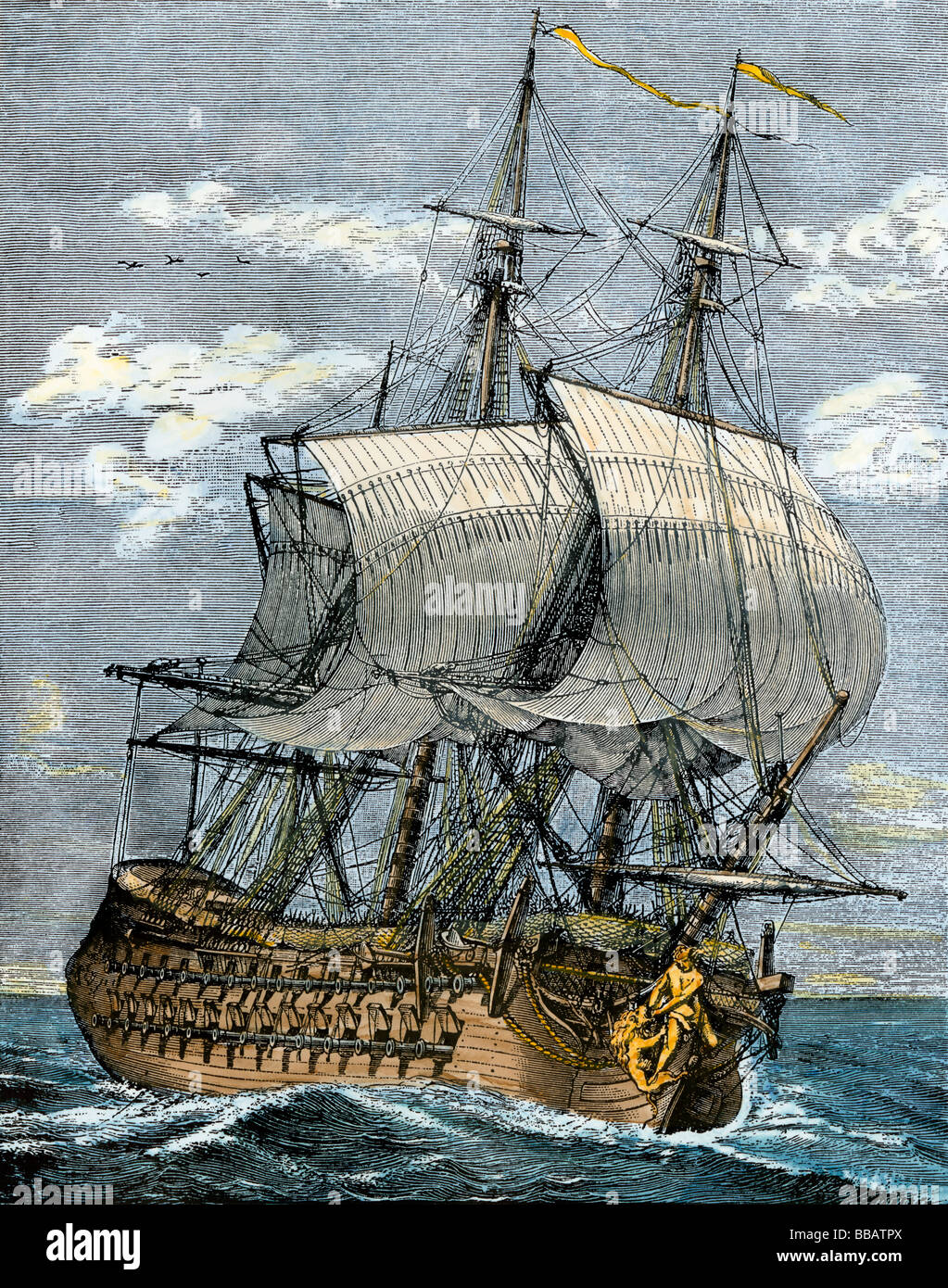 Armed French frigate of the 18th century. Hand-colored woodcut Stock Photohttps://www.alamy.com/image-license-details/?v=1https://www.alamy.com/stock-photo-armed-french-frigate-of-the-18th-century-hand-colored-woodcut-24210562.html
Armed French frigate of the 18th century. Hand-colored woodcut Stock Photohttps://www.alamy.com/image-license-details/?v=1https://www.alamy.com/stock-photo-armed-french-frigate-of-the-18th-century-hand-colored-woodcut-24210562.htmlRMBBATPX–Armed French frigate of the 18th century. Hand-colored woodcut
 AJAXNETPHOTO.1900S. SOLENT, ENGLAND. - HMS MARTIN, BRIG, 503 TONS. ONE OF FIVE SAILING VESSELS USED BY THE ROYAL NAVY FOR TRAINING BOYS OUT-OF-HARBOUR. BUILT IN 1890, THE MARTIN AND OTHERS WERE SWEPT AWAY IN LORD FISHER'S 'SCIENTIFIC NAVAL TRAINING PROGRAMME.' THE MARTIN WAS SIMILAR IN DESIGN AND RIG TO BRIGS DATING FROM THE 18TH CENTURY, BUT CARRIED LESS SAIL ON SHORTER YARDS. PHOTO: AJAX VINTAGE PICTURE LIBRARY REF: AVL/NA/BRIG/MARTIN-4 Stock Photohttps://www.alamy.com/image-license-details/?v=1https://www.alamy.com/stock-photo-ajaxnetphoto1900s-solent-england-hms-martin-brig-503-tons-one-of-five-137490963.html
AJAXNETPHOTO.1900S. SOLENT, ENGLAND. - HMS MARTIN, BRIG, 503 TONS. ONE OF FIVE SAILING VESSELS USED BY THE ROYAL NAVY FOR TRAINING BOYS OUT-OF-HARBOUR. BUILT IN 1890, THE MARTIN AND OTHERS WERE SWEPT AWAY IN LORD FISHER'S 'SCIENTIFIC NAVAL TRAINING PROGRAMME.' THE MARTIN WAS SIMILAR IN DESIGN AND RIG TO BRIGS DATING FROM THE 18TH CENTURY, BUT CARRIED LESS SAIL ON SHORTER YARDS. PHOTO: AJAX VINTAGE PICTURE LIBRARY REF: AVL/NA/BRIG/MARTIN-4 Stock Photohttps://www.alamy.com/image-license-details/?v=1https://www.alamy.com/stock-photo-ajaxnetphoto1900s-solent-england-hms-martin-brig-503-tons-one-of-five-137490963.htmlRMHYK73F–AJAXNETPHOTO.1900S. SOLENT, ENGLAND. - HMS MARTIN, BRIG, 503 TONS. ONE OF FIVE SAILING VESSELS USED BY THE ROYAL NAVY FOR TRAINING BOYS OUT-OF-HARBOUR. BUILT IN 1890, THE MARTIN AND OTHERS WERE SWEPT AWAY IN LORD FISHER'S 'SCIENTIFIC NAVAL TRAINING PROGRAMME.' THE MARTIN WAS SIMILAR IN DESIGN AND RIG TO BRIGS DATING FROM THE 18TH CENTURY, BUT CARRIED LESS SAIL ON SHORTER YARDS. PHOTO: AJAX VINTAGE PICTURE LIBRARY REF: AVL/NA/BRIG/MARTIN-4
 Bernardo Ramires Esquível (1723-1812). Aristocrat and Rear-Admiral of the Portuguese Navy. First Baron of Arruda. First Viscount of Estremoz. Anonymous portrait from the late 18th century, commissioned by the Marquis of Pombal. Maritime Museum. Lisbon, Portugal. Stock Photohttps://www.alamy.com/image-license-details/?v=1https://www.alamy.com/bernardo-ramires-esquvel-1723-1812-aristocrat-and-rear-admiral-of-the-portuguese-navy-first-baron-of-arruda-first-viscount-of-estremoz-anonymous-portrait-from-the-late-18th-century-commissioned-by-the-marquis-of-pombal-maritime-museum-lisbon-portugal-image545813787.html
Bernardo Ramires Esquível (1723-1812). Aristocrat and Rear-Admiral of the Portuguese Navy. First Baron of Arruda. First Viscount of Estremoz. Anonymous portrait from the late 18th century, commissioned by the Marquis of Pombal. Maritime Museum. Lisbon, Portugal. Stock Photohttps://www.alamy.com/image-license-details/?v=1https://www.alamy.com/bernardo-ramires-esquvel-1723-1812-aristocrat-and-rear-admiral-of-the-portuguese-navy-first-baron-of-arruda-first-viscount-of-estremoz-anonymous-portrait-from-the-late-18th-century-commissioned-by-the-marquis-of-pombal-maritime-museum-lisbon-portugal-image545813787.htmlRM2PKYY1F–Bernardo Ramires Esquível (1723-1812). Aristocrat and Rear-Admiral of the Portuguese Navy. First Baron of Arruda. First Viscount of Estremoz. Anonymous portrait from the late 18th century, commissioned by the Marquis of Pombal. Maritime Museum. Lisbon, Portugal.
 HMIS TRAVANCORE T312 - The Indian workforce rest after launching the 1st seagoing vessel built in India for the Indian navy on the 7th of July 1941. Built by Garden Reach Shipbuilders & Engineers Ltd. (Calcutta, India). I was financed by the Royal Family of The Kingdom of Travancore ,also known as the Kingdom of Thiruvithamkoor which was in power from the 18th century until 1949.-- HMIS திருவிதாங்கூர் T312 - ஜூலை 7, 1941 அன்று இந்தியக் கடற்படைக்காக இந்தியாவில் கட்டப்பட்டது. ---- -एचएमआईएस त्रावणकोर टी 312 - 7 जुलाई 1941 को भारतीय नौसेना के लिए भारत में बनाया गया था। Stock Photohttps://www.alamy.com/image-license-details/?v=1https://www.alamy.com/hmis-travancore-t312-the-indian-workforce-rest-after-launching-the-1st-seagoing-vessel-built-in-india-for-the-indian-navy-on-the-7th-of-july-1941-built-by-garden-reach-shipbuilders-engineers-ltd-calcutta-india-i-was-financed-by-the-royal-family-of-the-kingdom-of-travancore-also-known-as-the-kingdom-of-thiruvithamkoor-which-was-in-power-from-the-18th-century-until-1949-hmis-t312-7-1941-312-7-1941-image490306178.html
HMIS TRAVANCORE T312 - The Indian workforce rest after launching the 1st seagoing vessel built in India for the Indian navy on the 7th of July 1941. Built by Garden Reach Shipbuilders & Engineers Ltd. (Calcutta, India). I was financed by the Royal Family of The Kingdom of Travancore ,also known as the Kingdom of Thiruvithamkoor which was in power from the 18th century until 1949.-- HMIS திருவிதாங்கூர் T312 - ஜூலை 7, 1941 அன்று இந்தியக் கடற்படைக்காக இந்தியாவில் கட்டப்பட்டது. ---- -एचएमआईएस त्रावणकोर टी 312 - 7 जुलाई 1941 को भारतीय नौसेना के लिए भारत में बनाया गया था। Stock Photohttps://www.alamy.com/image-license-details/?v=1https://www.alamy.com/hmis-travancore-t312-the-indian-workforce-rest-after-launching-the-1st-seagoing-vessel-built-in-india-for-the-indian-navy-on-the-7th-of-july-1941-built-by-garden-reach-shipbuilders-engineers-ltd-calcutta-india-i-was-financed-by-the-royal-family-of-the-kingdom-of-travancore-also-known-as-the-kingdom-of-thiruvithamkoor-which-was-in-power-from-the-18th-century-until-1949-hmis-t312-7-1941-312-7-1941-image490306178.htmlRM2KDKAEX–HMIS TRAVANCORE T312 - The Indian workforce rest after launching the 1st seagoing vessel built in India for the Indian navy on the 7th of July 1941. Built by Garden Reach Shipbuilders & Engineers Ltd. (Calcutta, India). I was financed by the Royal Family of The Kingdom of Travancore ,also known as the Kingdom of Thiruvithamkoor which was in power from the 18th century until 1949.-- HMIS திருவிதாங்கூர் T312 - ஜூலை 7, 1941 அன்று இந்தியக் கடற்படைக்காக இந்தியாவில் கட்டப்பட்டது. ---- -एचएमआईएस त्रावणकोर टी 312 - 7 जुलाई 1941 को भारतीय नौसेना के लिए भारत में बनाया गया था।
 Italy: An early 16th-century illustration of Venice by Ottoman admiral and cartographer Piri Reis (1470-1554), published in his navigational ‘Kitab-i-Bahriye’ (Book of Sea Lore). For centuries Venice was Europe’s prime trading partner with the Middle East and the Byzantine Empire in particular. Venetian naval and commercial power was unrivalled in Europe until it lost a series of wars to the Ottoman armies in the 15th century. The city lost some 50,000 people to the Black Death in 1575-77, but remained a major manufacturing center and port well into the 18th century. Stock Photohttps://www.alamy.com/image-license-details/?v=1https://www.alamy.com/italy-an-early-16th-century-illustration-of-venice-by-ottoman-admiral-and-cartographer-piri-reis-1470-1554-published-in-his-navigational-kitab-i-bahriye-book-of-sea-lore-for-centuries-venice-was-europes-prime-trading-partner-with-the-middle-east-and-the-byzantine-empire-in-particular-venetian-naval-and-commercial-power-was-unrivalled-in-europe-until-it-lost-a-series-of-wars-to-the-ottoman-armies-in-the-15th-century-the-city-lost-some-50000-people-to-the-black-death-in-1575-77-but-remained-a-major-manufacturing-center-and-port-well-into-the-18th-century-image344226976.html
Italy: An early 16th-century illustration of Venice by Ottoman admiral and cartographer Piri Reis (1470-1554), published in his navigational ‘Kitab-i-Bahriye’ (Book of Sea Lore). For centuries Venice was Europe’s prime trading partner with the Middle East and the Byzantine Empire in particular. Venetian naval and commercial power was unrivalled in Europe until it lost a series of wars to the Ottoman armies in the 15th century. The city lost some 50,000 people to the Black Death in 1575-77, but remained a major manufacturing center and port well into the 18th century. Stock Photohttps://www.alamy.com/image-license-details/?v=1https://www.alamy.com/italy-an-early-16th-century-illustration-of-venice-by-ottoman-admiral-and-cartographer-piri-reis-1470-1554-published-in-his-navigational-kitab-i-bahriye-book-of-sea-lore-for-centuries-venice-was-europes-prime-trading-partner-with-the-middle-east-and-the-byzantine-empire-in-particular-venetian-naval-and-commercial-power-was-unrivalled-in-europe-until-it-lost-a-series-of-wars-to-the-ottoman-armies-in-the-15th-century-the-city-lost-some-50000-people-to-the-black-death-in-1575-77-but-remained-a-major-manufacturing-center-and-port-well-into-the-18th-century-image344226976.htmlRM2B00W0G–Italy: An early 16th-century illustration of Venice by Ottoman admiral and cartographer Piri Reis (1470-1554), published in his navigational ‘Kitab-i-Bahriye’ (Book of Sea Lore). For centuries Venice was Europe’s prime trading partner with the Middle East and the Byzantine Empire in particular. Venetian naval and commercial power was unrivalled in Europe until it lost a series of wars to the Ottoman armies in the 15th century. The city lost some 50,000 people to the Black Death in 1575-77, but remained a major manufacturing center and port well into the 18th century.
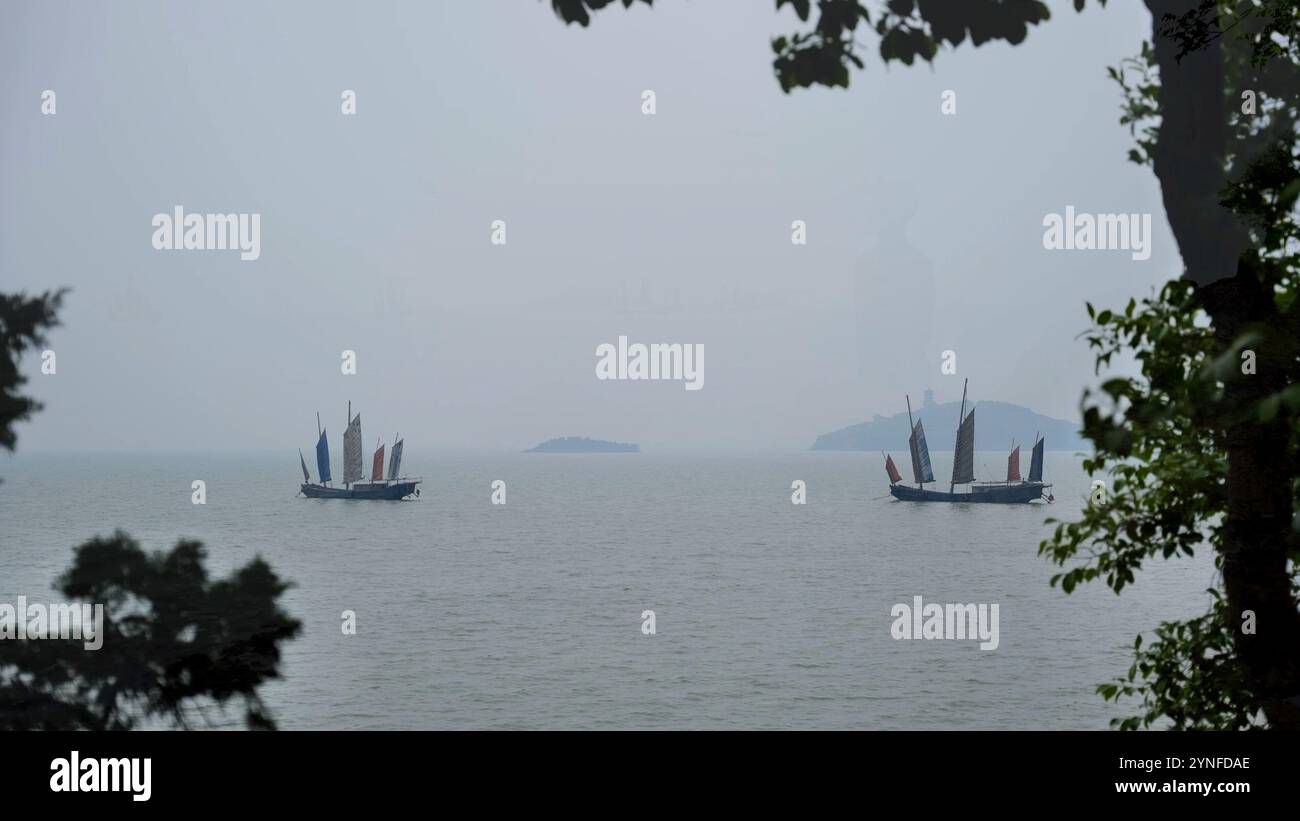 Old 18th century ship on taihu lake Jiangsu province China. High quality photo Stock Photohttps://www.alamy.com/image-license-details/?v=1https://www.alamy.com/old-18th-century-ship-on-taihu-lake-jiangsu-province-china-high-quality-photo-image632820790.html
Old 18th century ship on taihu lake Jiangsu province China. High quality photo Stock Photohttps://www.alamy.com/image-license-details/?v=1https://www.alamy.com/old-18th-century-ship-on-taihu-lake-jiangsu-province-china-high-quality-photo-image632820790.htmlRF2YNFDAE–Old 18th century ship on taihu lake Jiangsu province China. High quality photo
 English squadron arriving at Dunkirk. Caption reads: 'English Squadron Carrying Troops to Take Possession of Dunkirk'. Dunkirk, 'commune' in the Nord department of France. From 'History of Queen Anne', 1740. Stock Photohttps://www.alamy.com/image-license-details/?v=1https://www.alamy.com/stock-image-english-squadron-arriving-at-dunkirk-caption-reads-english-squadron-164175169.html
English squadron arriving at Dunkirk. Caption reads: 'English Squadron Carrying Troops to Take Possession of Dunkirk'. Dunkirk, 'commune' in the Nord department of France. From 'History of Queen Anne', 1740. Stock Photohttps://www.alamy.com/image-license-details/?v=1https://www.alamy.com/stock-image-english-squadron-arriving-at-dunkirk-caption-reads-english-squadron-164175169.htmlRMKF2R2W–English squadron arriving at Dunkirk. Caption reads: 'English Squadron Carrying Troops to Take Possession of Dunkirk'. Dunkirk, 'commune' in the Nord department of France. From 'History of Queen Anne', 1740.
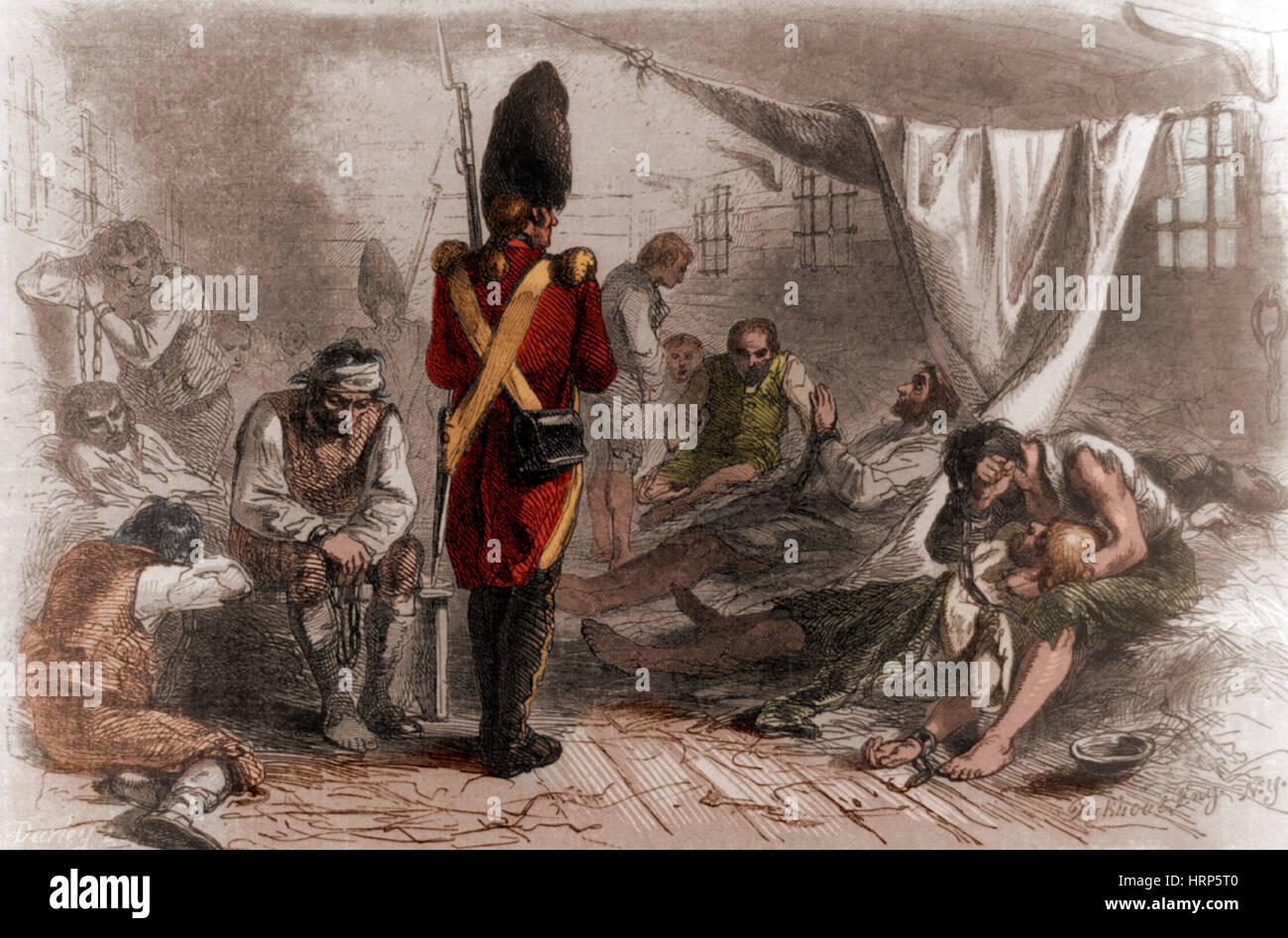 American Revolution, British Prison Ship Jersey Stock Photohttps://www.alamy.com/image-license-details/?v=1https://www.alamy.com/stock-photo-american-revolution-british-prison-ship-jersey-135097200.html
American Revolution, British Prison Ship Jersey Stock Photohttps://www.alamy.com/image-license-details/?v=1https://www.alamy.com/stock-photo-american-revolution-british-prison-ship-jersey-135097200.htmlRMHRP5T0–American Revolution, British Prison Ship Jersey
![landscape of the polar region from the book ' A voyage towards the North Pole : undertaken by His Majesty's command, 1773 ' by Constantine John Phipps, Baron Mulgrave, 1744-1792; The 1773 Phipps expedition towards the North Pole was a British Royal Navy expedition in which two ships under the commands of Constantine John Phipps as Captain of the HMS Racehorse [an 18-gun ship-rigged sloop of the Royal Navy.] and Skeffington Lutwidge as Captain of the HMS Carcass [a bomb vessel of the Royal Navy], sailed towards the North Pole in the summer of 1773 and became stuck in ice near Svalbard. A young Stock Photo landscape of the polar region from the book ' A voyage towards the North Pole : undertaken by His Majesty's command, 1773 ' by Constantine John Phipps, Baron Mulgrave, 1744-1792; The 1773 Phipps expedition towards the North Pole was a British Royal Navy expedition in which two ships under the commands of Constantine John Phipps as Captain of the HMS Racehorse [an 18-gun ship-rigged sloop of the Royal Navy.] and Skeffington Lutwidge as Captain of the HMS Carcass [a bomb vessel of the Royal Navy], sailed towards the North Pole in the summer of 1773 and became stuck in ice near Svalbard. A young Stock Photo](https://c8.alamy.com/comp/2GB5BN6/landscape-of-the-polar-region-from-the-book-a-voyage-towards-the-north-pole-undertaken-by-his-majestys-command-1773-by-constantine-john-phipps-baron-mulgrave-1744-1792-the-1773-phipps-expedition-towards-the-north-pole-was-a-british-royal-navy-expedition-in-which-two-ships-under-the-commands-of-constantine-john-phipps-as-captain-of-the-hms-racehorse-an-18-gun-ship-rigged-sloop-of-the-royal-navy-and-skeffington-lutwidge-as-captain-of-the-hms-carcass-a-bomb-vessel-of-the-royal-navy-sailed-towards-the-north-pole-in-the-summer-of-1773-and-became-stuck-in-ice-near-svalbard-a-young-2GB5BN6.jpg) landscape of the polar region from the book ' A voyage towards the North Pole : undertaken by His Majesty's command, 1773 ' by Constantine John Phipps, Baron Mulgrave, 1744-1792; The 1773 Phipps expedition towards the North Pole was a British Royal Navy expedition in which two ships under the commands of Constantine John Phipps as Captain of the HMS Racehorse [an 18-gun ship-rigged sloop of the Royal Navy.] and Skeffington Lutwidge as Captain of the HMS Carcass [a bomb vessel of the Royal Navy], sailed towards the North Pole in the summer of 1773 and became stuck in ice near Svalbard. A young Stock Photohttps://www.alamy.com/image-license-details/?v=1https://www.alamy.com/landscape-of-the-polar-region-from-the-book-a-voyage-towards-the-north-pole-undertaken-by-his-majestys-command-1773-by-constantine-john-phipps-baron-mulgrave-1744-1792-the-1773-phipps-expedition-towards-the-north-pole-was-a-british-royal-navy-expedition-in-which-two-ships-under-the-commands-of-constantine-john-phipps-as-captain-of-the-hms-racehorse-an-18-gun-ship-rigged-sloop-of-the-royal-navy-and-skeffington-lutwidge-as-captain-of-the-hms-carcass-a-bomb-vessel-of-the-royal-navy-sailed-towards-the-north-pole-in-the-summer-of-1773-and-became-stuck-in-ice-near-svalbard-a-young-image437139394.html
landscape of the polar region from the book ' A voyage towards the North Pole : undertaken by His Majesty's command, 1773 ' by Constantine John Phipps, Baron Mulgrave, 1744-1792; The 1773 Phipps expedition towards the North Pole was a British Royal Navy expedition in which two ships under the commands of Constantine John Phipps as Captain of the HMS Racehorse [an 18-gun ship-rigged sloop of the Royal Navy.] and Skeffington Lutwidge as Captain of the HMS Carcass [a bomb vessel of the Royal Navy], sailed towards the North Pole in the summer of 1773 and became stuck in ice near Svalbard. A young Stock Photohttps://www.alamy.com/image-license-details/?v=1https://www.alamy.com/landscape-of-the-polar-region-from-the-book-a-voyage-towards-the-north-pole-undertaken-by-his-majestys-command-1773-by-constantine-john-phipps-baron-mulgrave-1744-1792-the-1773-phipps-expedition-towards-the-north-pole-was-a-british-royal-navy-expedition-in-which-two-ships-under-the-commands-of-constantine-john-phipps-as-captain-of-the-hms-racehorse-an-18-gun-ship-rigged-sloop-of-the-royal-navy-and-skeffington-lutwidge-as-captain-of-the-hms-carcass-a-bomb-vessel-of-the-royal-navy-sailed-towards-the-north-pole-in-the-summer-of-1773-and-became-stuck-in-ice-near-svalbard-a-young-image437139394.htmlRM2GB5BN6–landscape of the polar region from the book ' A voyage towards the North Pole : undertaken by His Majesty's command, 1773 ' by Constantine John Phipps, Baron Mulgrave, 1744-1792; The 1773 Phipps expedition towards the North Pole was a British Royal Navy expedition in which two ships under the commands of Constantine John Phipps as Captain of the HMS Racehorse [an 18-gun ship-rigged sloop of the Royal Navy.] and Skeffington Lutwidge as Captain of the HMS Carcass [a bomb vessel of the Royal Navy], sailed towards the North Pole in the summer of 1773 and became stuck in ice near Svalbard. A young
 The Grand Turk , an 18th century three-masted frigate, at Great Yarmouth Maritime Festival Stock Photohttps://www.alamy.com/image-license-details/?v=1https://www.alamy.com/stock-photo-the-grand-turk-an-18th-century-three-masted-frigate-at-great-yarmouth-27139923.html
The Grand Turk , an 18th century three-masted frigate, at Great Yarmouth Maritime Festival Stock Photohttps://www.alamy.com/image-license-details/?v=1https://www.alamy.com/stock-photo-the-grand-turk-an-18th-century-three-masted-frigate-at-great-yarmouth-27139923.htmlRMBG496Y–The Grand Turk , an 18th century three-masted frigate, at Great Yarmouth Maritime Festival
 Bernardo Ramires Esquível (1723-1812). Aristocrat and Rear-Admiral of the Portuguese Navy. First Baron of Arruda. First Viscount of Estremoz. Anonymous portrait from the late 18th century, commissioned by the Marquis of Pombal. Maritime Museum. Lisbon, Portugal. Stock Photohttps://www.alamy.com/image-license-details/?v=1https://www.alamy.com/bernardo-ramires-esquvel-1723-1812-aristocrat-and-rear-admiral-of-the-portuguese-navy-first-baron-of-arruda-first-viscount-of-estremoz-anonymous-portrait-from-the-late-18th-century-commissioned-by-the-marquis-of-pombal-maritime-museum-lisbon-portugal-image546212787.html
Bernardo Ramires Esquível (1723-1812). Aristocrat and Rear-Admiral of the Portuguese Navy. First Baron of Arruda. First Viscount of Estremoz. Anonymous portrait from the late 18th century, commissioned by the Marquis of Pombal. Maritime Museum. Lisbon, Portugal. Stock Photohttps://www.alamy.com/image-license-details/?v=1https://www.alamy.com/bernardo-ramires-esquvel-1723-1812-aristocrat-and-rear-admiral-of-the-portuguese-navy-first-baron-of-arruda-first-viscount-of-estremoz-anonymous-portrait-from-the-late-18th-century-commissioned-by-the-marquis-of-pombal-maritime-museum-lisbon-portugal-image546212787.htmlRM2PMJ3YF–Bernardo Ramires Esquível (1723-1812). Aristocrat and Rear-Admiral of the Portuguese Navy. First Baron of Arruda. First Viscount of Estremoz. Anonymous portrait from the late 18th century, commissioned by the Marquis of Pombal. Maritime Museum. Lisbon, Portugal.
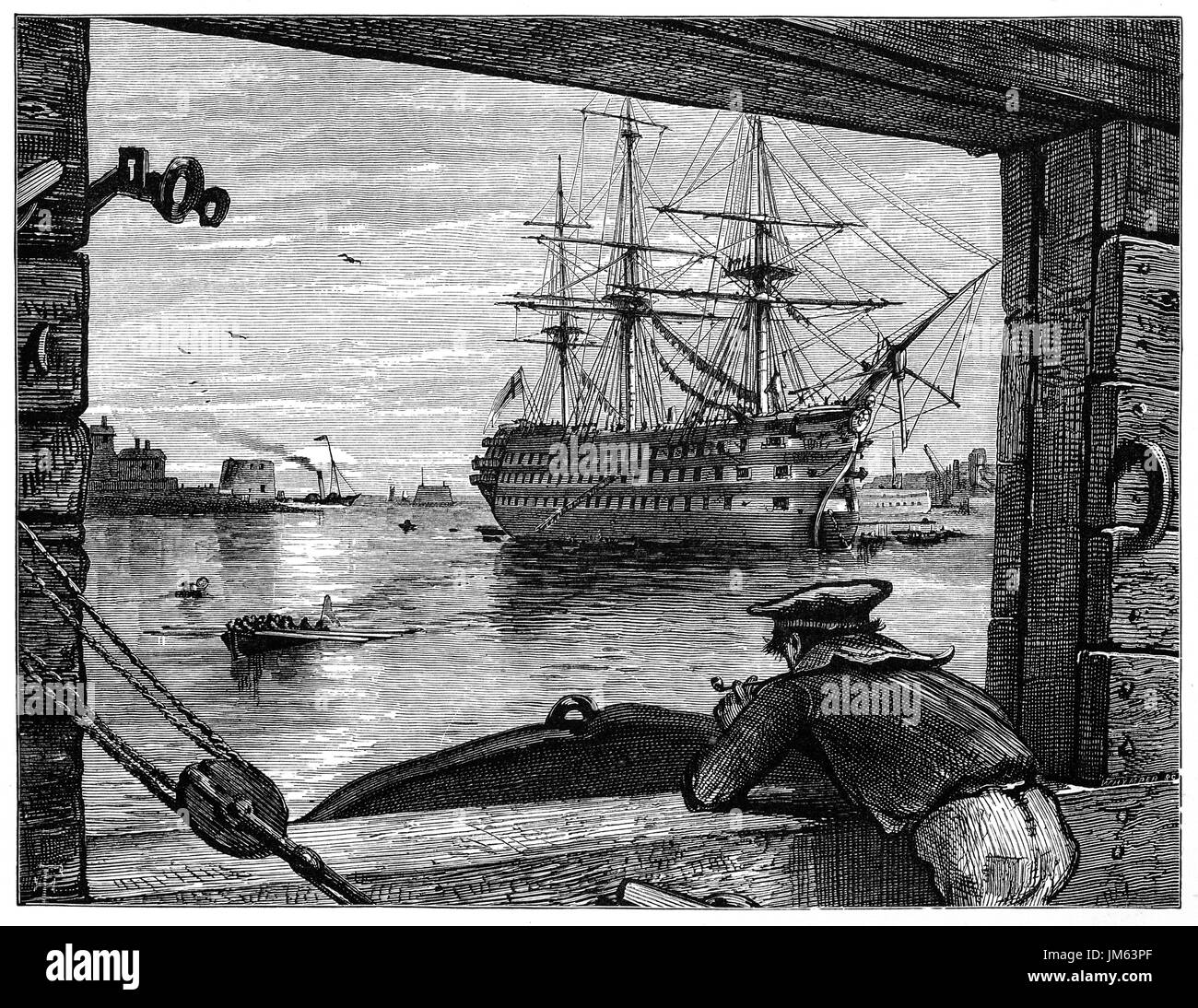 1870: 1870: An old tar (sailor) viewing HMS Victory in Portsmouth Harbour off Gosport. She is a 104-gun first-rate ship of the line of the Royal Navy, ordered in 1758, laid down in 1759 and launched in 1765. She is best known for her role as Lord Nelson's flagship at the Battle of Trafalgar in 1805. Hampshire, England. Stock Photohttps://www.alamy.com/image-license-details/?v=1https://www.alamy.com/1870-1870-an-old-tar-sailor-viewing-hms-victory-in-portsmouth-harbour-image150110759.html
1870: 1870: An old tar (sailor) viewing HMS Victory in Portsmouth Harbour off Gosport. She is a 104-gun first-rate ship of the line of the Royal Navy, ordered in 1758, laid down in 1759 and launched in 1765. She is best known for her role as Lord Nelson's flagship at the Battle of Trafalgar in 1805. Hampshire, England. Stock Photohttps://www.alamy.com/image-license-details/?v=1https://www.alamy.com/1870-1870-an-old-tar-sailor-viewing-hms-victory-in-portsmouth-harbour-image150110759.htmlRMJM63PF–1870: 1870: An old tar (sailor) viewing HMS Victory in Portsmouth Harbour off Gosport. She is a 104-gun first-rate ship of the line of the Royal Navy, ordered in 1758, laid down in 1759 and launched in 1765. She is best known for her role as Lord Nelson's flagship at the Battle of Trafalgar in 1805. Hampshire, England.
 Woolwich Dockyard . English: Woolwich Dockyard was an English naval dockyard. The dockyard was built in 1514 by Henry VIII for the construction of his famous ship 'Harry Grace a Dieu'. Royal Navy vessels were built at the yard until its closure in 1869. This view, by Nicholas Pocock, gives an indication of the scale of the enterprise by the late 18th century. The area around the dockyard was known as the Warren and consisted of workshops, warehouses, timber yards, barracks, foundries and the nearby Royal Arsenal. . 1790. 924 Nicholas Pocock - Woolwich Dockyard Stock Photohttps://www.alamy.com/image-license-details/?v=1https://www.alamy.com/woolwich-dockyard-english-woolwich-dockyard-was-an-english-naval-dockyard-the-dockyard-was-built-in-1514-by-henry-viii-for-the-construction-of-his-famous-ship-harry-grace-a-dieu-royal-navy-vessels-were-built-at-the-yard-until-its-closure-in-1869-this-view-by-nicholas-pocock-gives-an-indication-of-the-scale-of-the-enterprise-by-the-late-18th-century-the-area-around-the-dockyard-was-known-as-the-warren-and-consisted-of-workshops-warehouses-timber-yards-barracks-foundries-and-the-nearby-royal-arsenal-1790-924-nicholas-pocock-woolwich-dockyard-image185879757.html
Woolwich Dockyard . English: Woolwich Dockyard was an English naval dockyard. The dockyard was built in 1514 by Henry VIII for the construction of his famous ship 'Harry Grace a Dieu'. Royal Navy vessels were built at the yard until its closure in 1869. This view, by Nicholas Pocock, gives an indication of the scale of the enterprise by the late 18th century. The area around the dockyard was known as the Warren and consisted of workshops, warehouses, timber yards, barracks, foundries and the nearby Royal Arsenal. . 1790. 924 Nicholas Pocock - Woolwich Dockyard Stock Photohttps://www.alamy.com/image-license-details/?v=1https://www.alamy.com/woolwich-dockyard-english-woolwich-dockyard-was-an-english-naval-dockyard-the-dockyard-was-built-in-1514-by-henry-viii-for-the-construction-of-his-famous-ship-harry-grace-a-dieu-royal-navy-vessels-were-built-at-the-yard-until-its-closure-in-1869-this-view-by-nicholas-pocock-gives-an-indication-of-the-scale-of-the-enterprise-by-the-late-18th-century-the-area-around-the-dockyard-was-known-as-the-warren-and-consisted-of-workshops-warehouses-timber-yards-barracks-foundries-and-the-nearby-royal-arsenal-1790-924-nicholas-pocock-woolwich-dockyard-image185879757.htmlRMMPBFEN–Woolwich Dockyard . English: Woolwich Dockyard was an English naval dockyard. The dockyard was built in 1514 by Henry VIII for the construction of his famous ship 'Harry Grace a Dieu'. Royal Navy vessels were built at the yard until its closure in 1869. This view, by Nicholas Pocock, gives an indication of the scale of the enterprise by the late 18th century. The area around the dockyard was known as the Warren and consisted of workshops, warehouses, timber yards, barracks, foundries and the nearby Royal Arsenal. . 1790. 924 Nicholas Pocock - Woolwich Dockyard
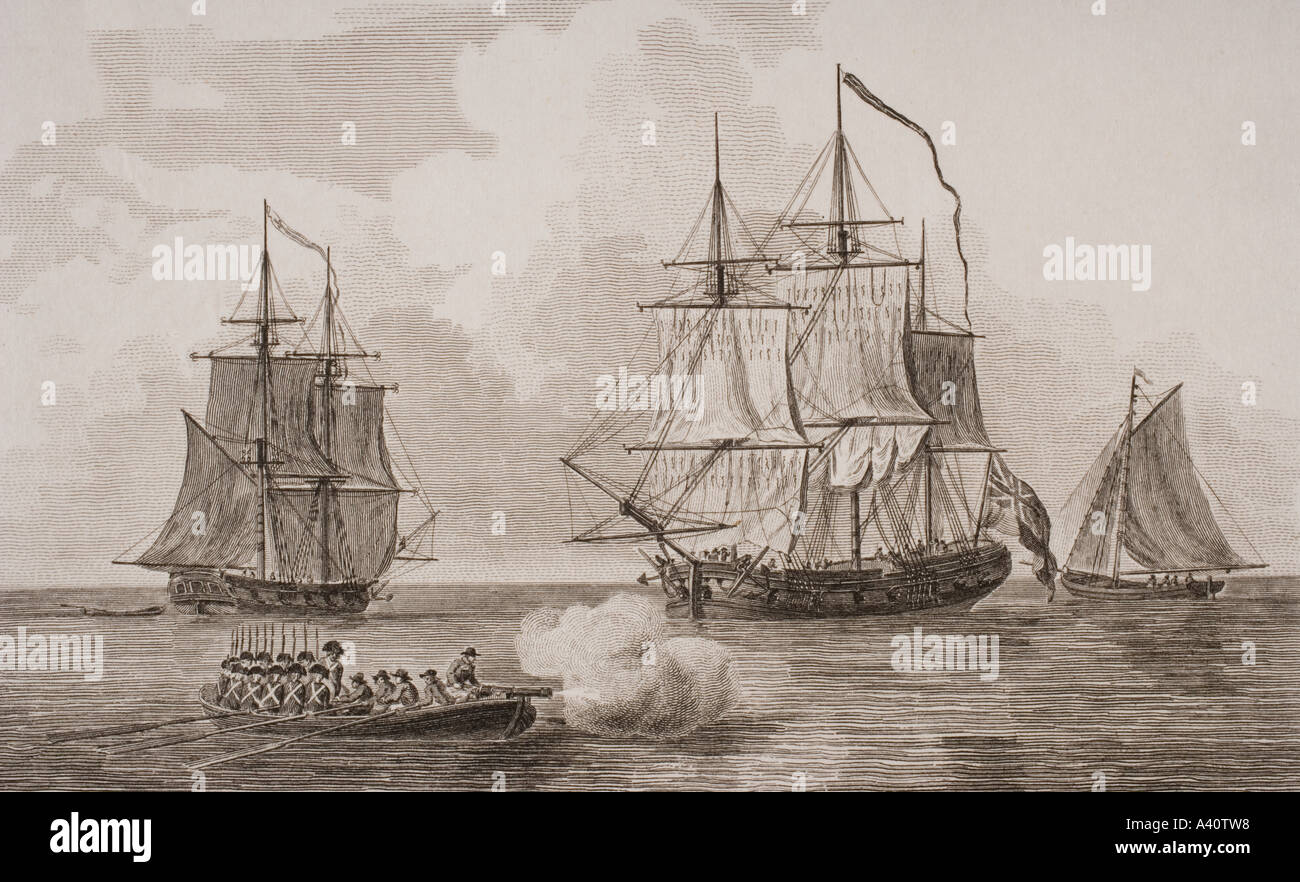 18th and 19th century British navy boats. From left, Fire Brig, Flat Bottomed Boat Gun Vessel, Man of War, Long Boat. Stock Photohttps://www.alamy.com/image-license-details/?v=1https://www.alamy.com/18th-and-19th-century-british-navy-boats-from-left-fire-brig-flat-image6226583.html
18th and 19th century British navy boats. From left, Fire Brig, Flat Bottomed Boat Gun Vessel, Man of War, Long Boat. Stock Photohttps://www.alamy.com/image-license-details/?v=1https://www.alamy.com/18th-and-19th-century-british-navy-boats-from-left-fire-brig-flat-image6226583.htmlRMA40TW8–18th and 19th century British navy boats. From left, Fire Brig, Flat Bottomed Boat Gun Vessel, Man of War, Long Boat.
 'The Town and Harbour of Portsmouth with a View of his Majesty's Fleet at Spithead', 18th century. Creator: Unknown. Stock Photohttps://www.alamy.com/image-license-details/?v=1https://www.alamy.com/the-town-and-harbour-of-portsmouth-with-a-view-of-his-majestys-fleet-at-spithead-18th-century-creator-unknown-image224240930.html
'The Town and Harbour of Portsmouth with a View of his Majesty's Fleet at Spithead', 18th century. Creator: Unknown. Stock Photohttps://www.alamy.com/image-license-details/?v=1https://www.alamy.com/the-town-and-harbour-of-portsmouth-with-a-view-of-his-majestys-fleet-at-spithead-18th-century-creator-unknown-image224240930.htmlRMR0R1GJ–'The Town and Harbour of Portsmouth with a View of his Majesty's Fleet at Spithead', 18th century. Creator: Unknown.